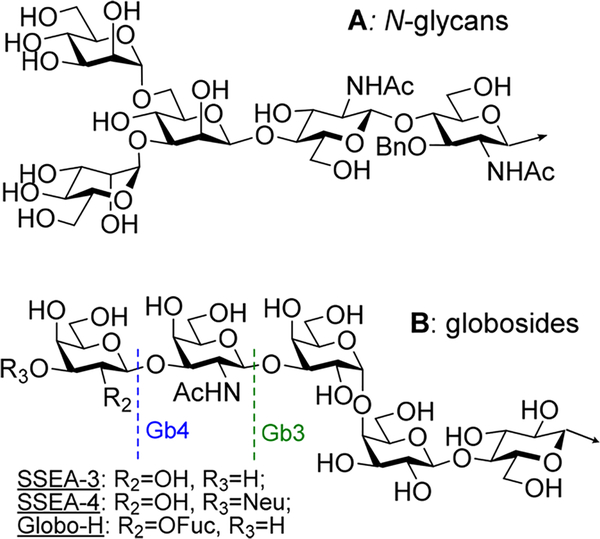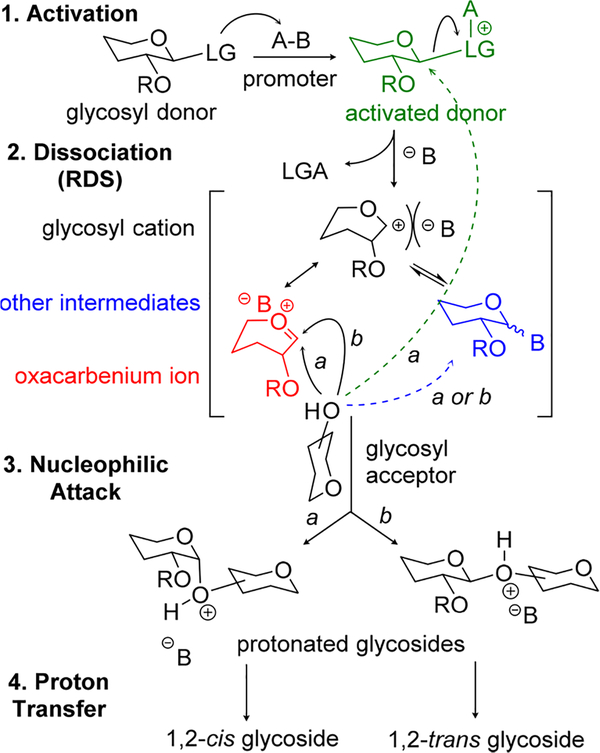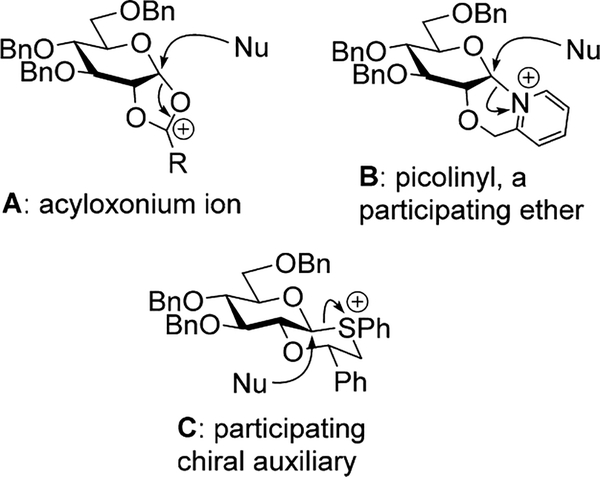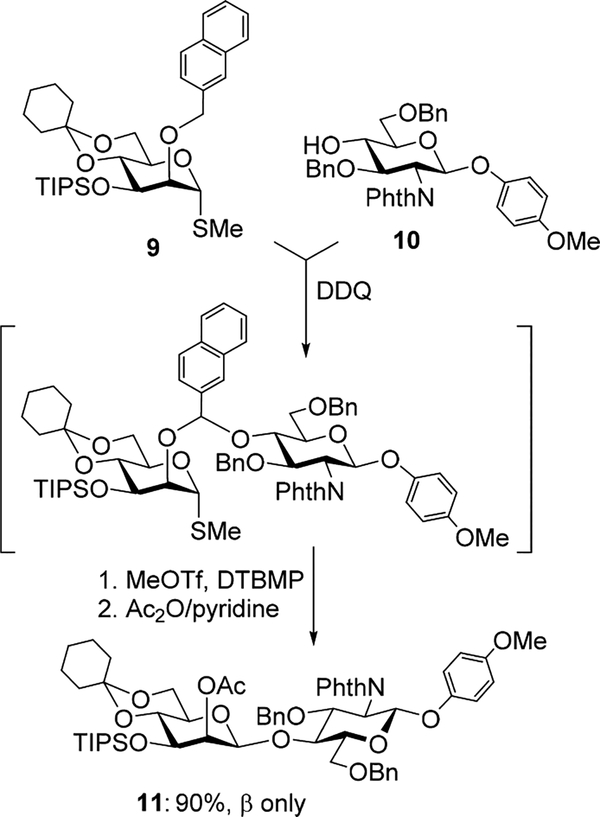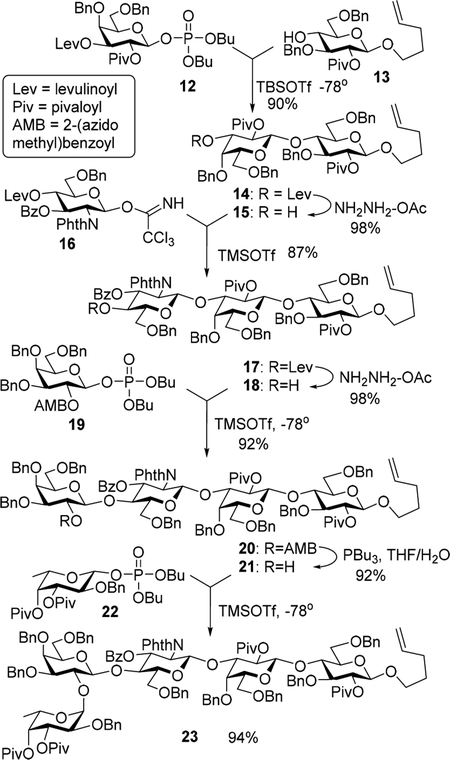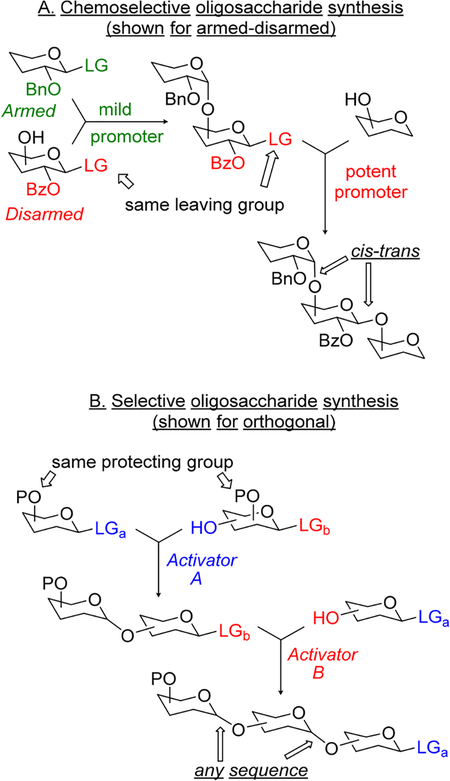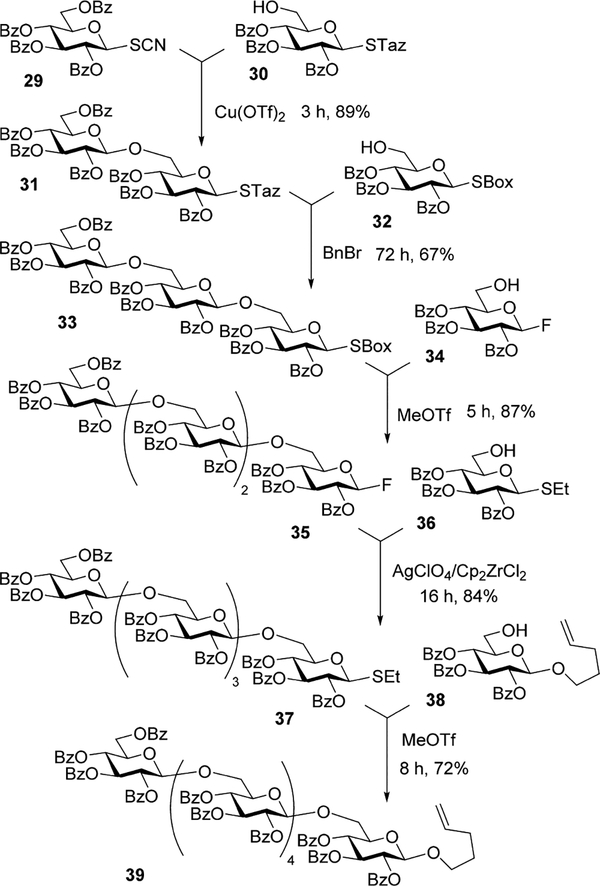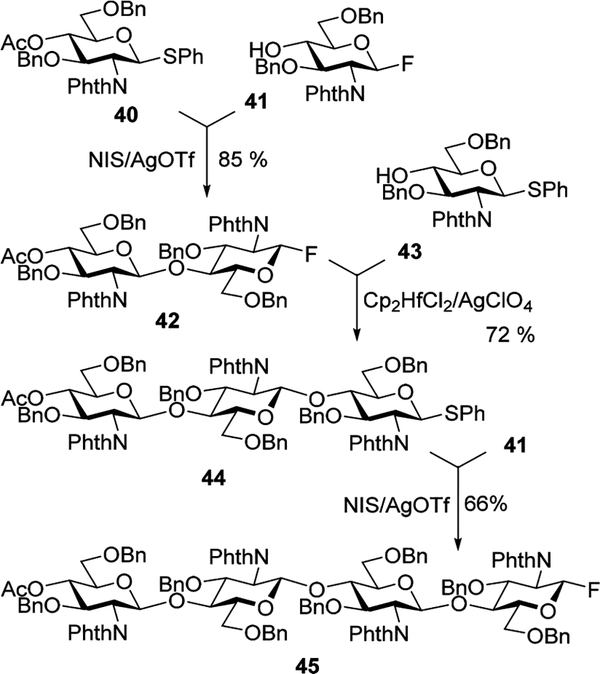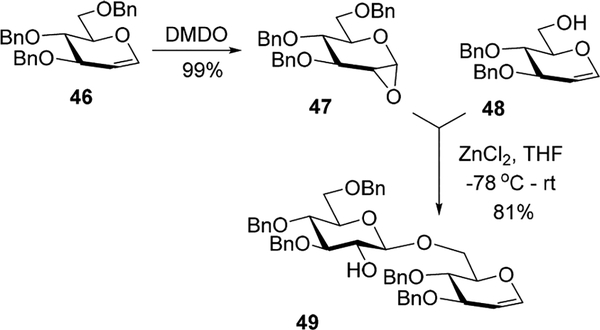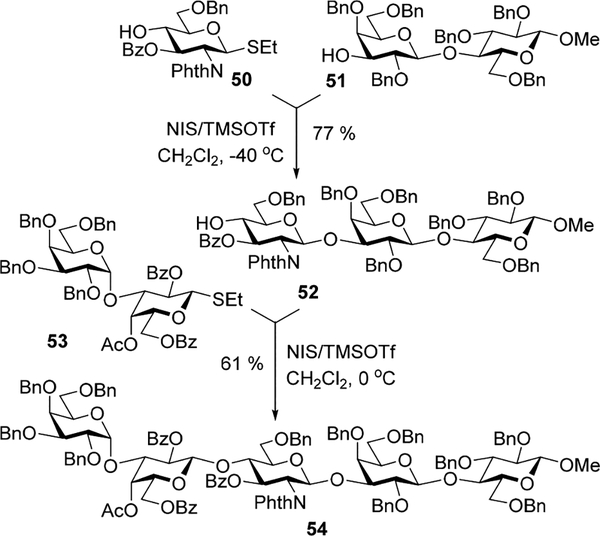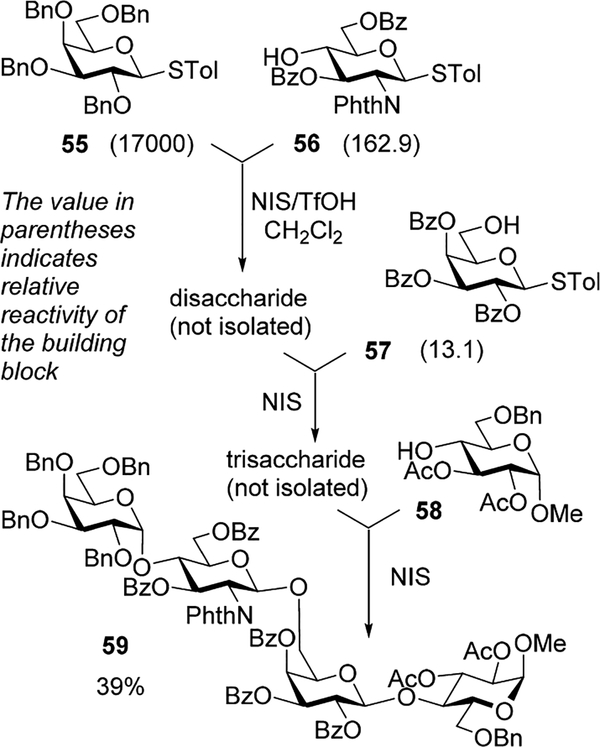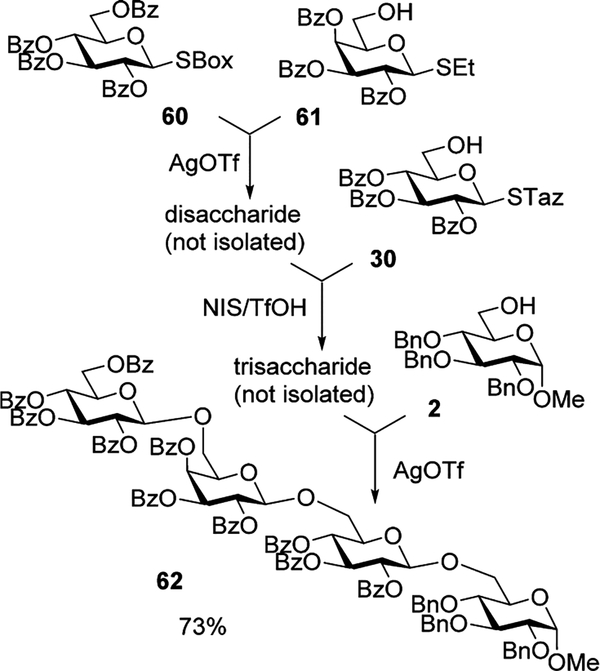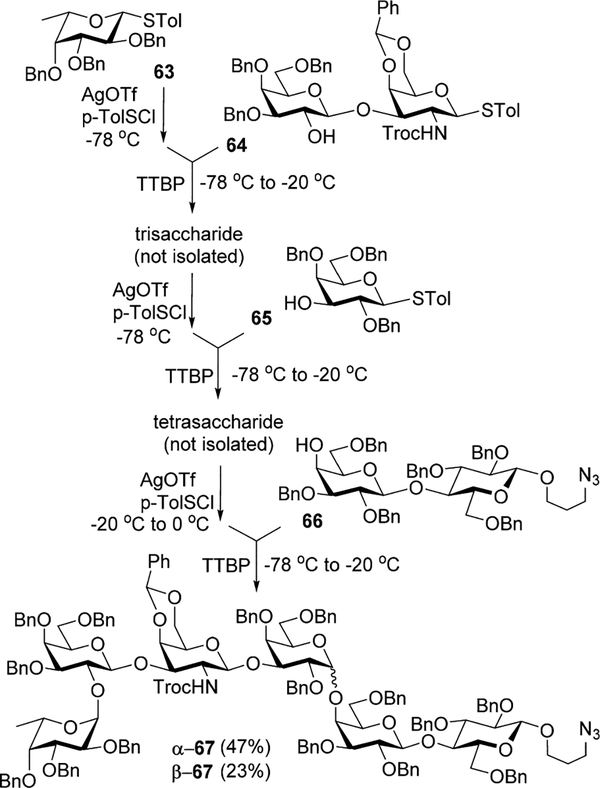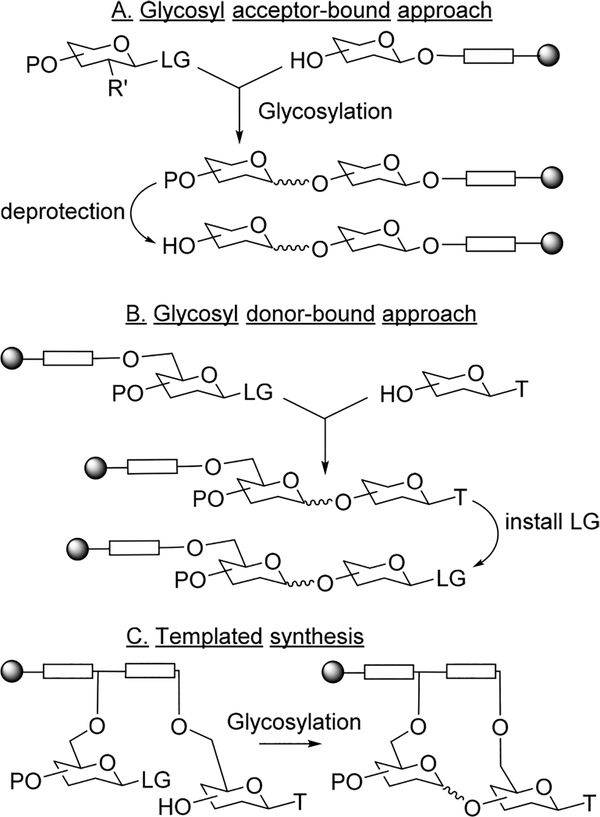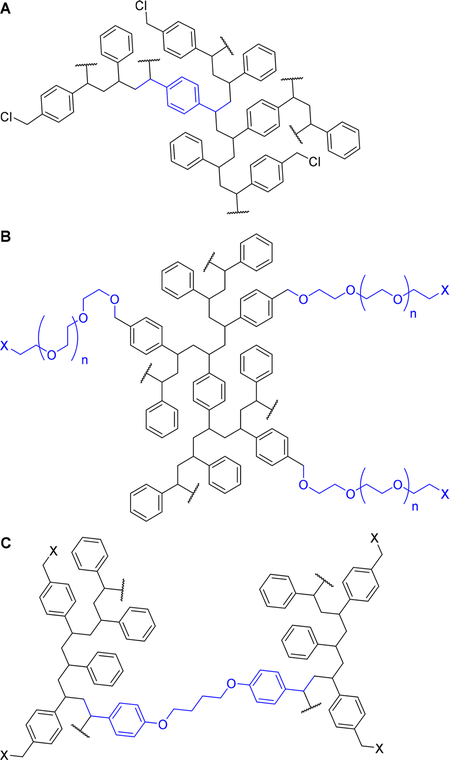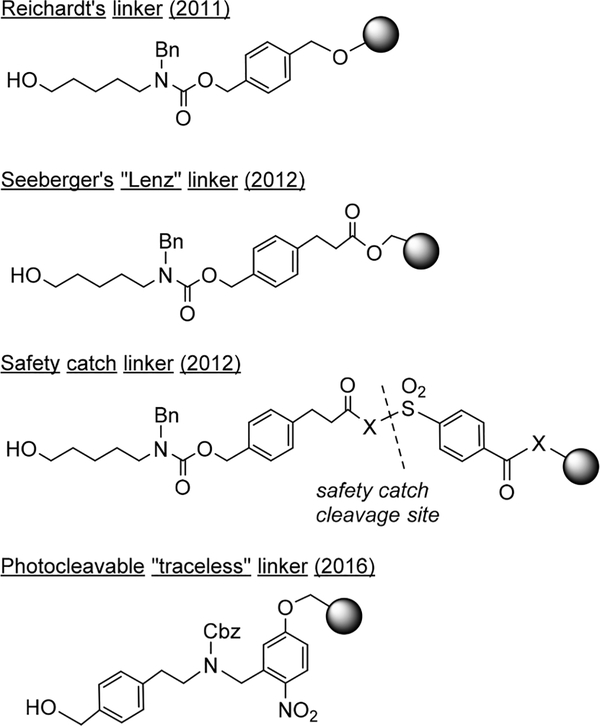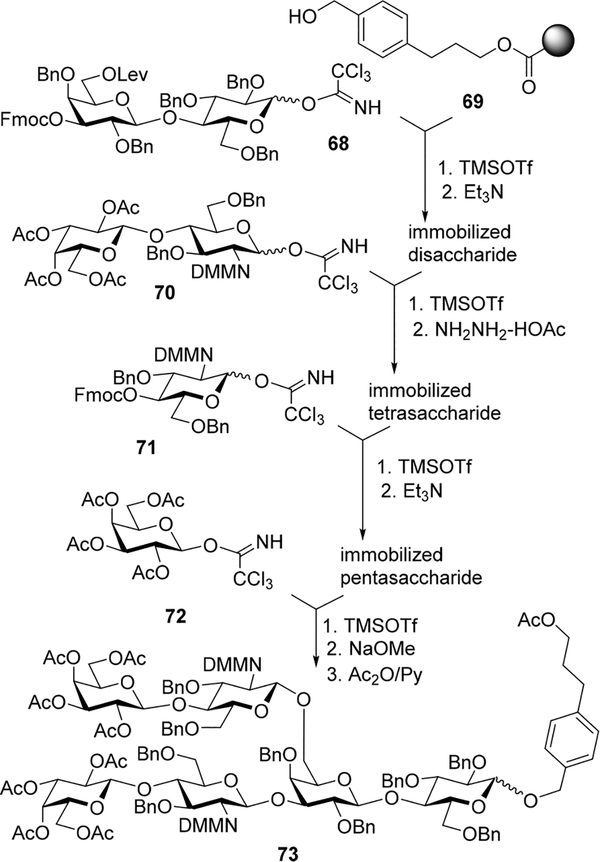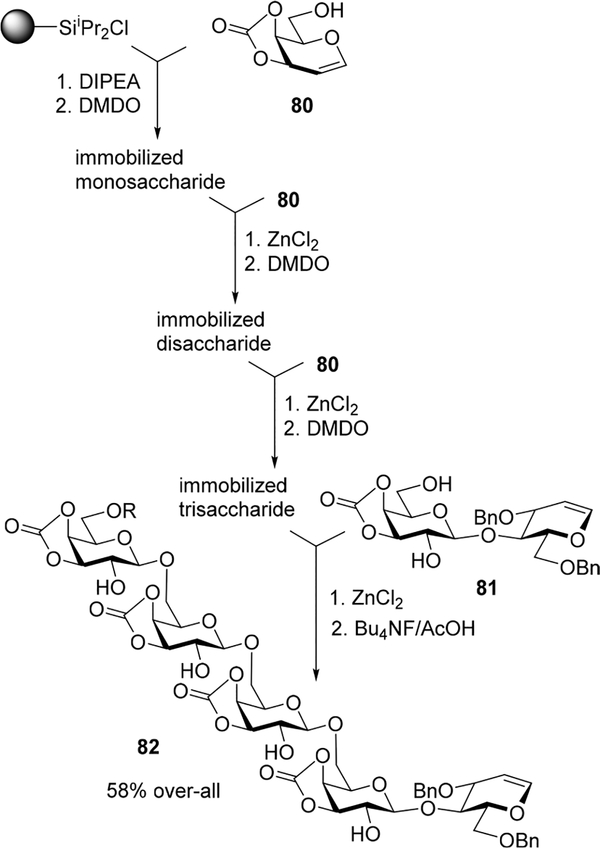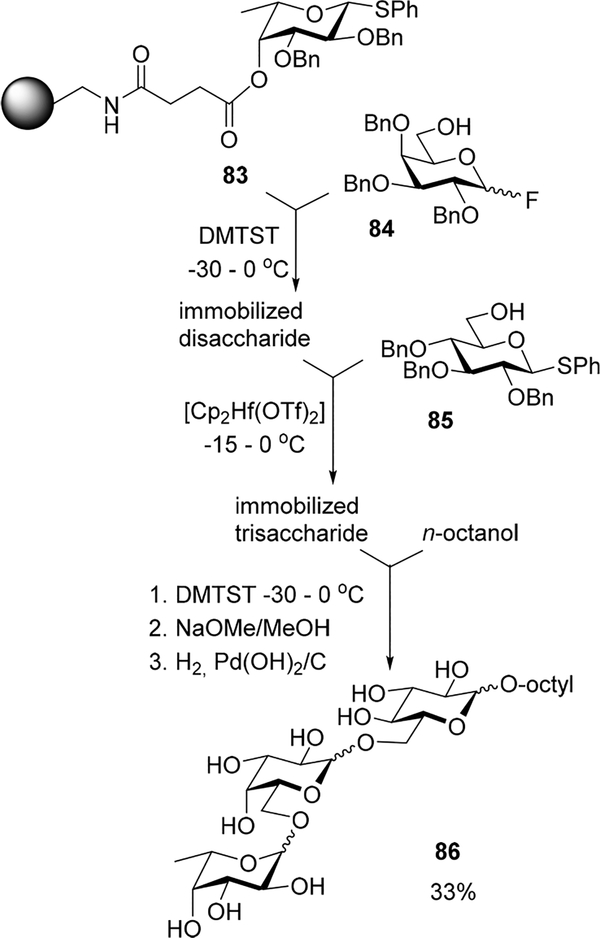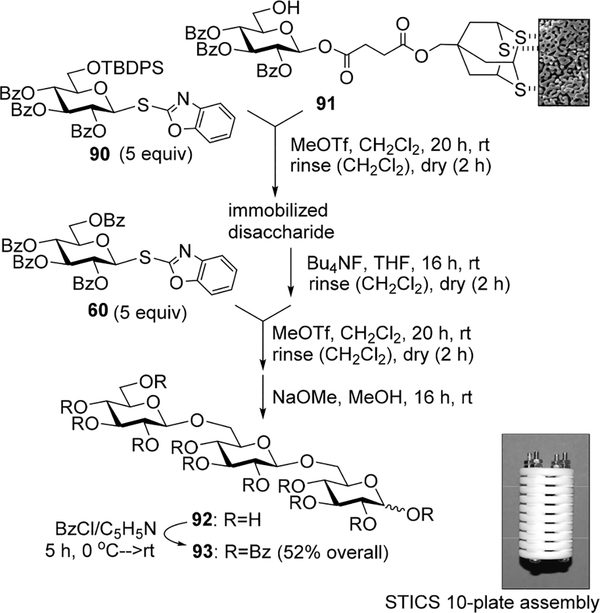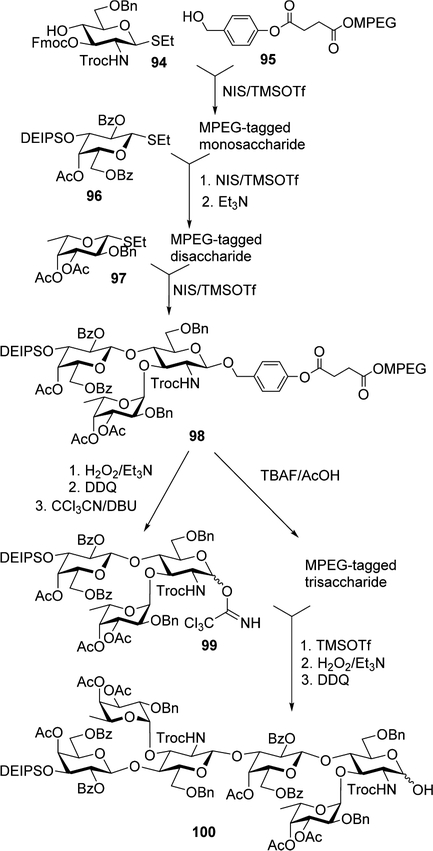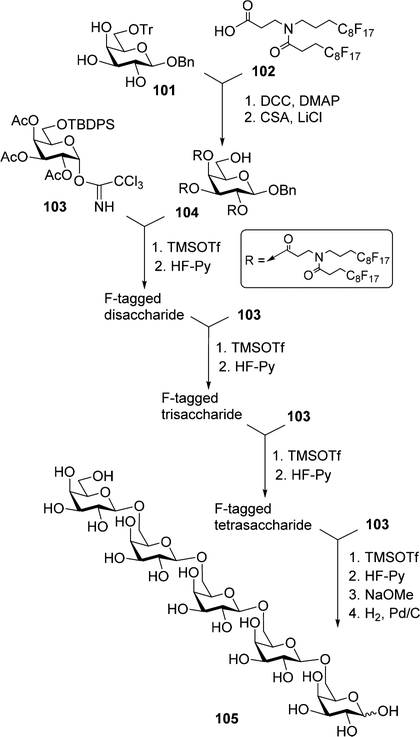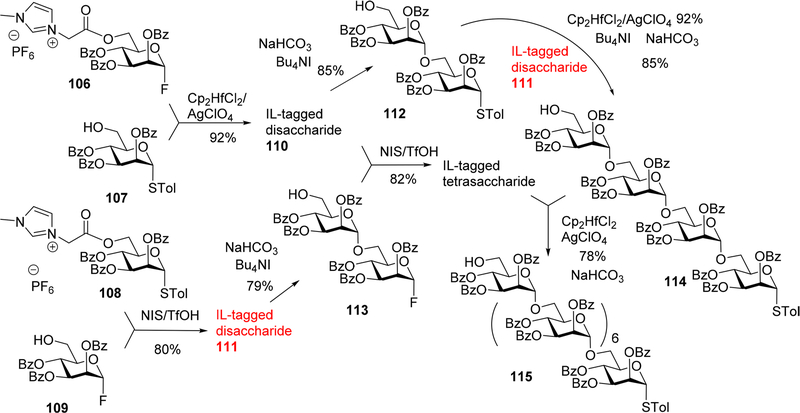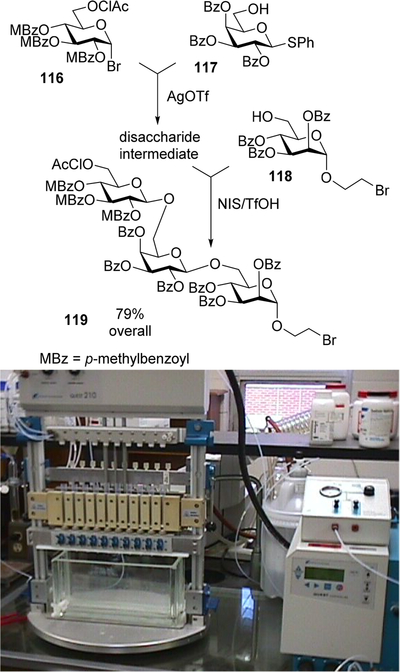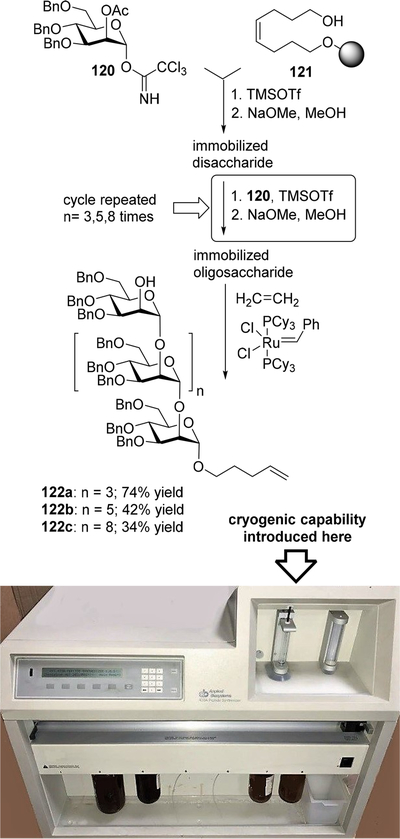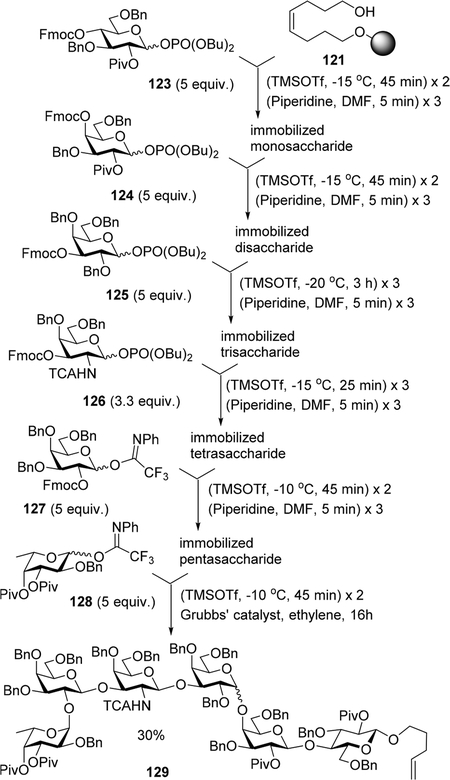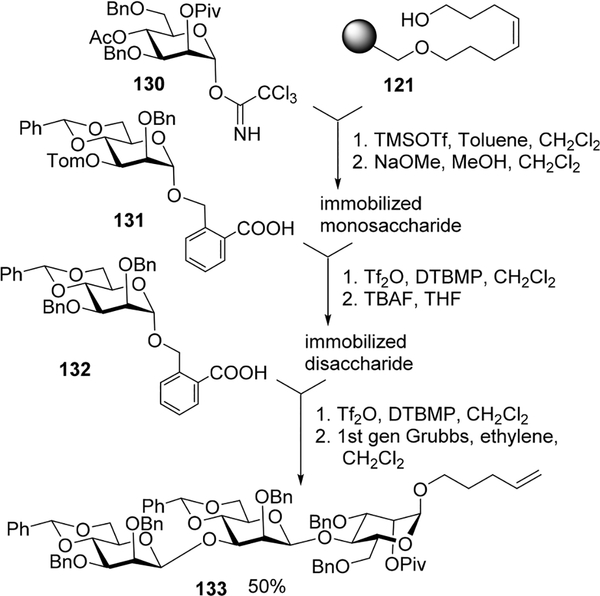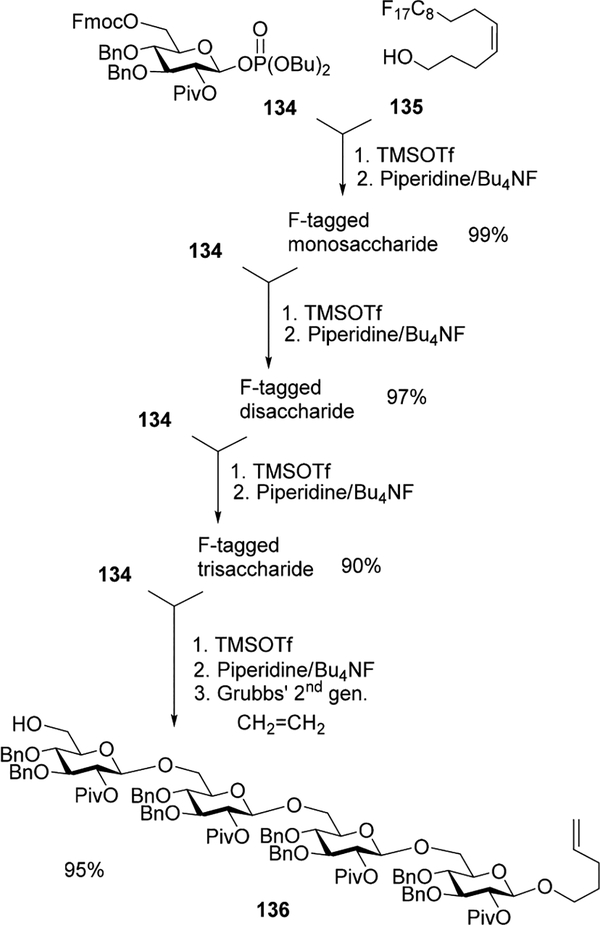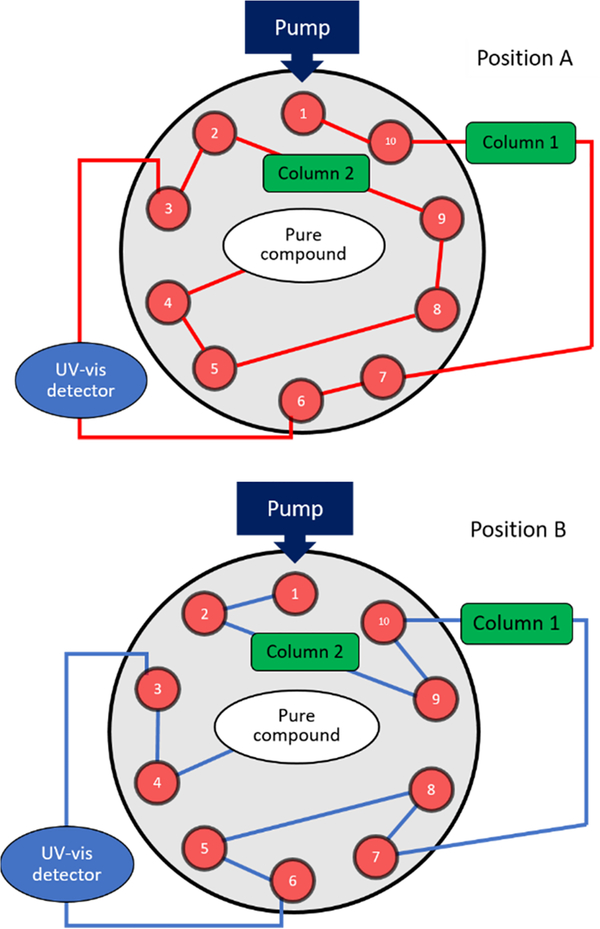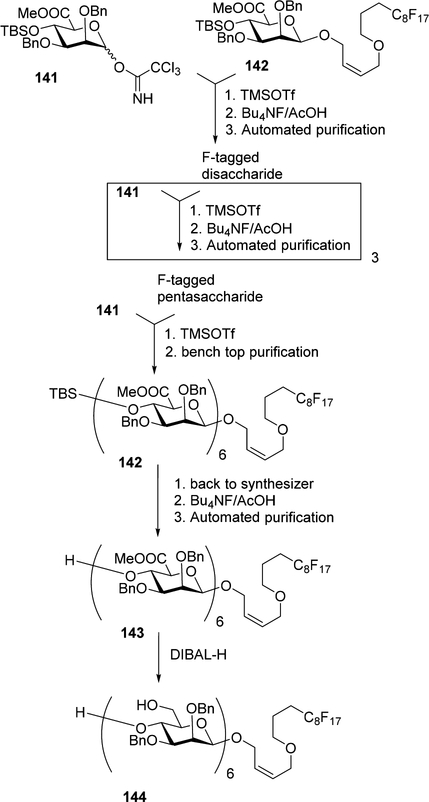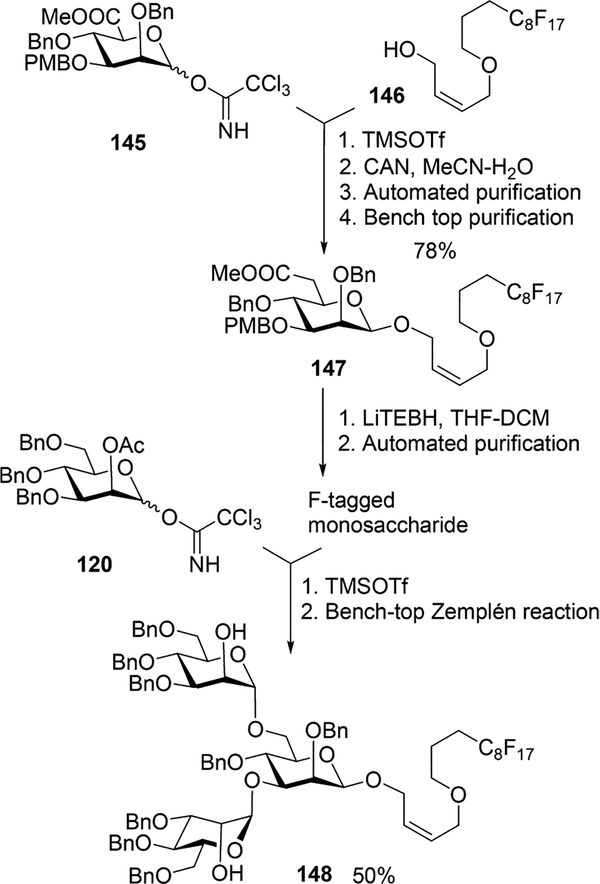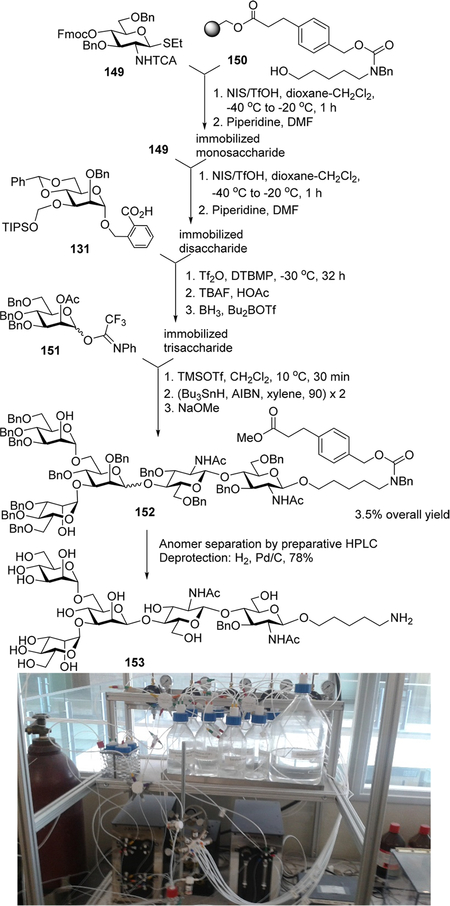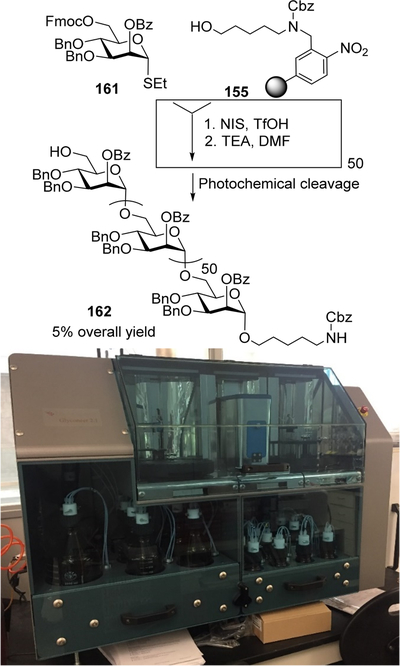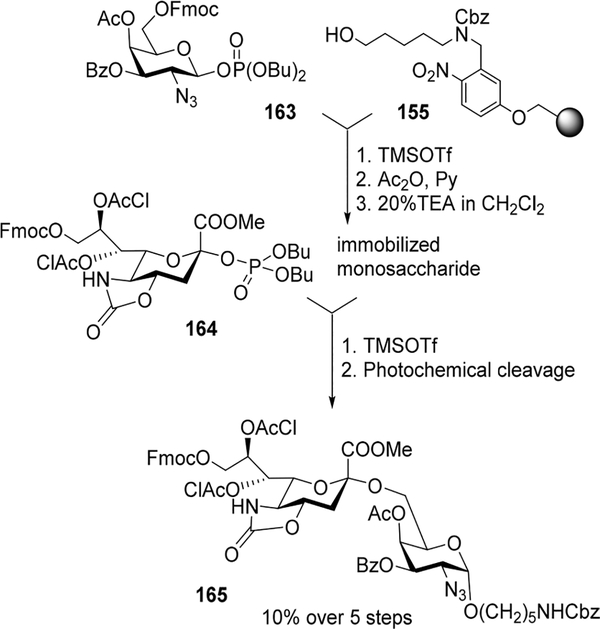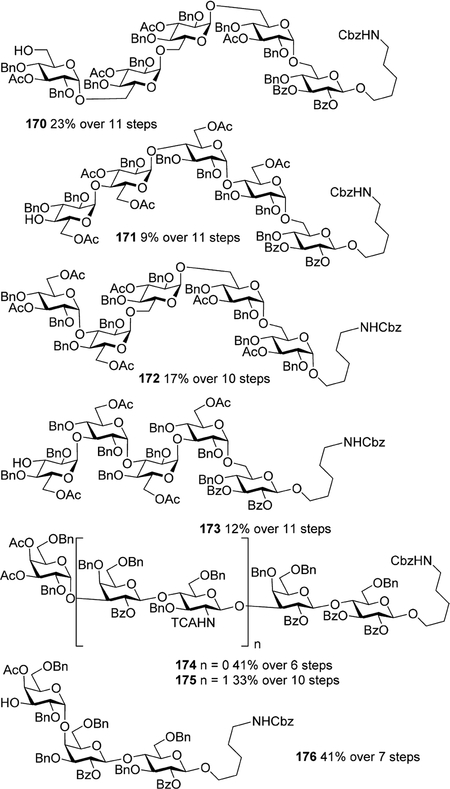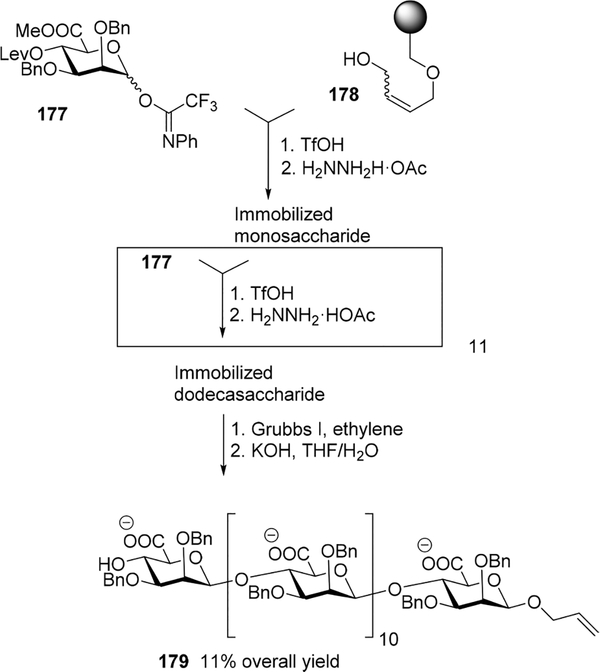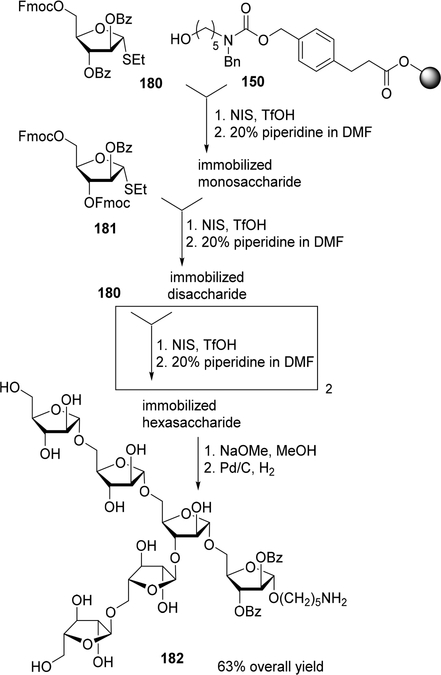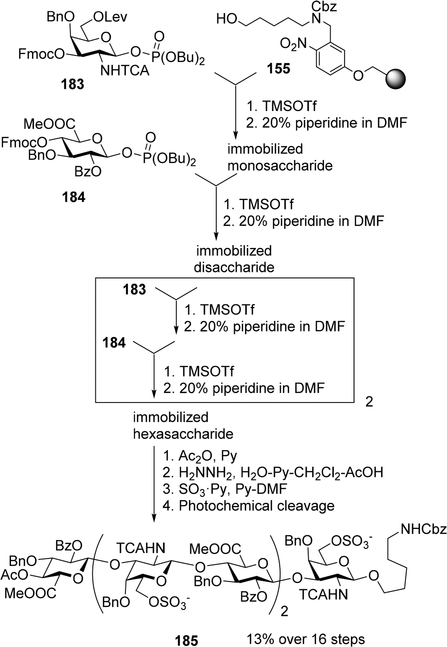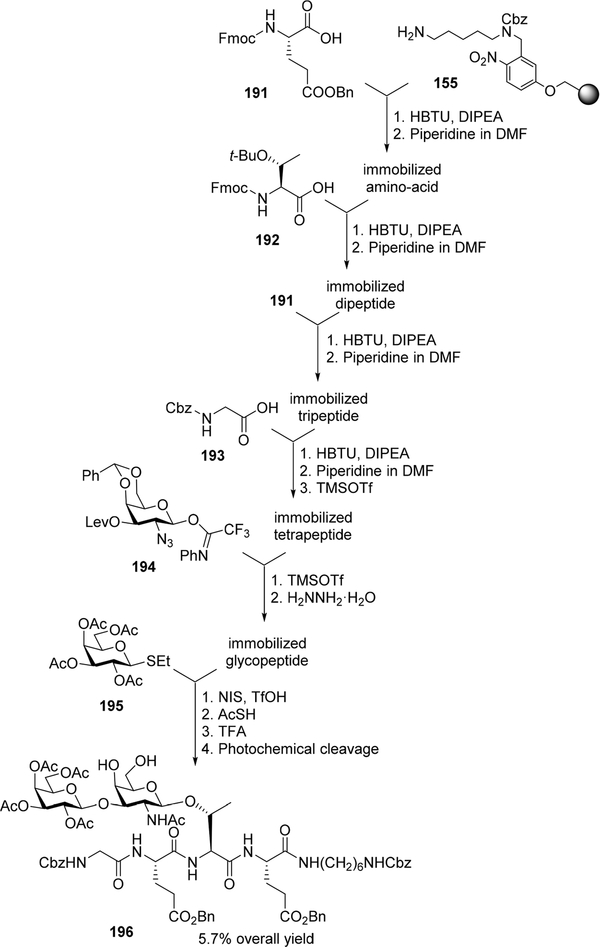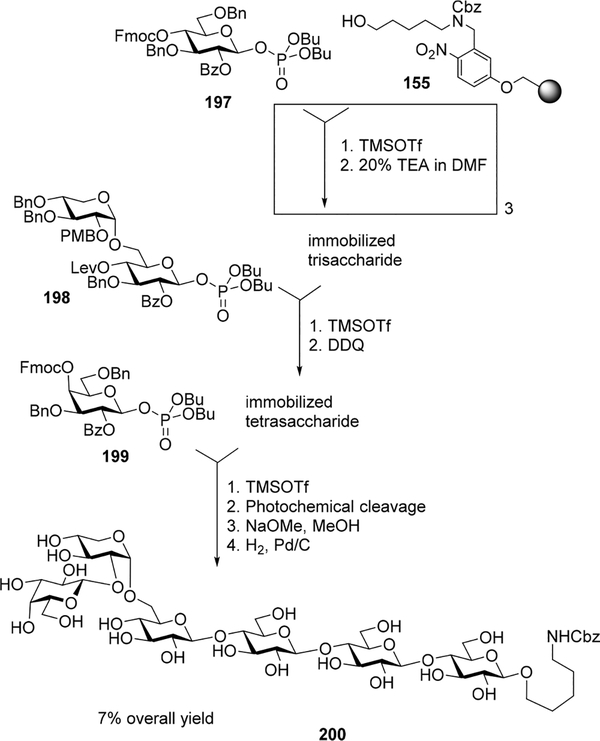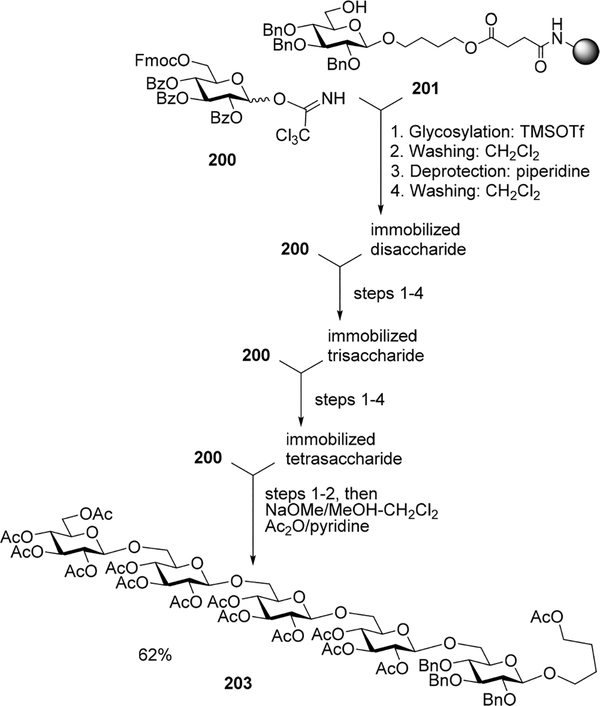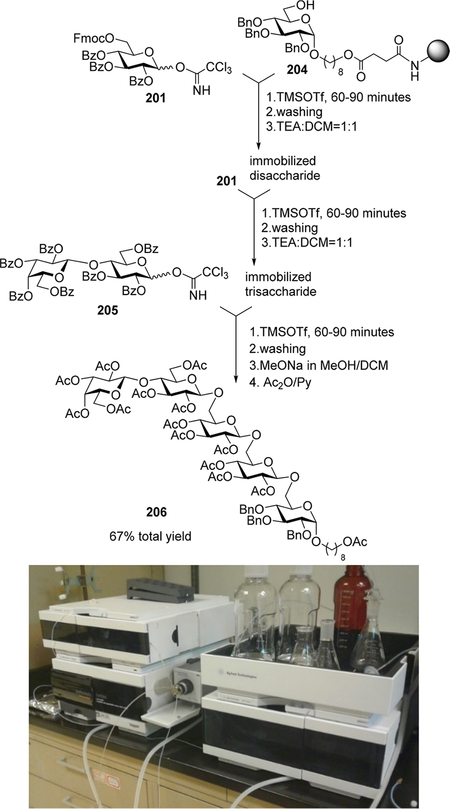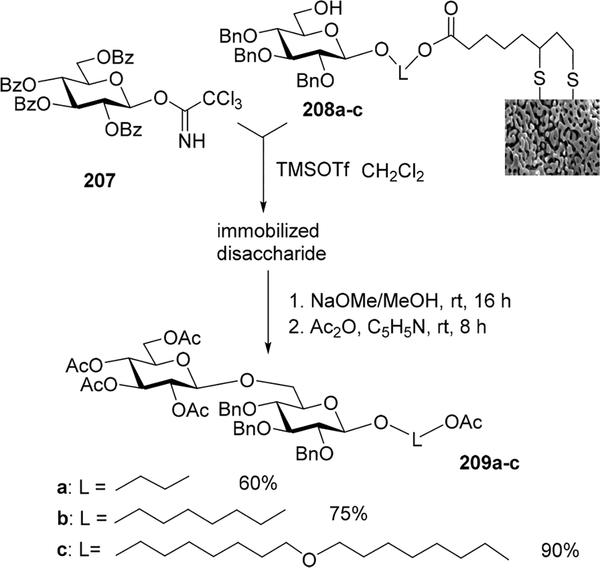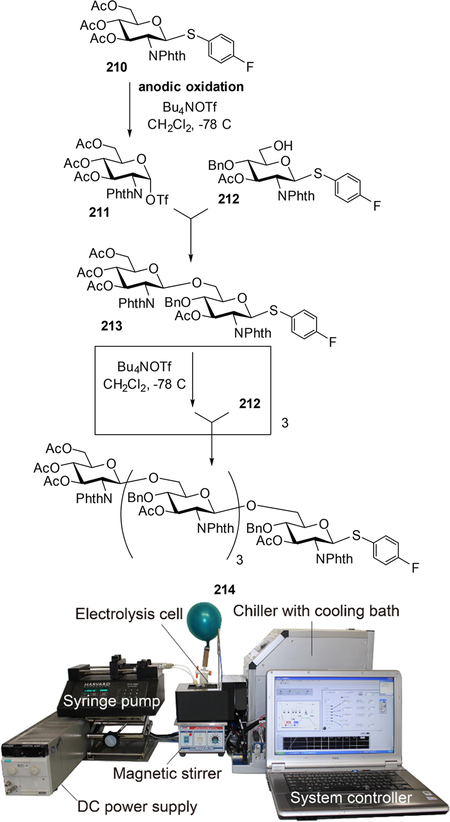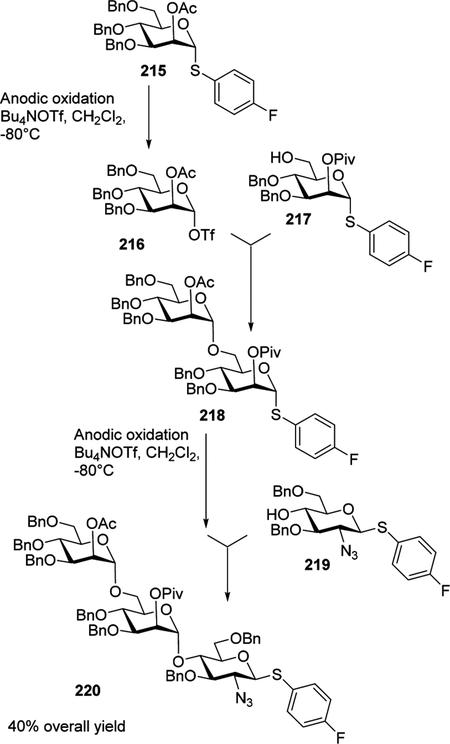Abstract
Advances in carbohydrate chemistry have certainly made common oligosaccharides much more accessible. However, many current methods still rely heavily upon specialized knowledge of carbohydrate chemistry. The application of automated technologies to chemical and life science applications such as genomics and proteomics represents a vibrant field. These automated technologies also present opportunities for their application to organic synthesis, including that of the synthesis of oligosaccharides. However, application of automated methods to the synthesis of carbohydrates is an underdeveloped area as compared to other classes of biomolecules. The overarching goal of this review article is to present the advances that have been made at the interface of carbohydrate chemistry and automated technology.
Graphical Abstract
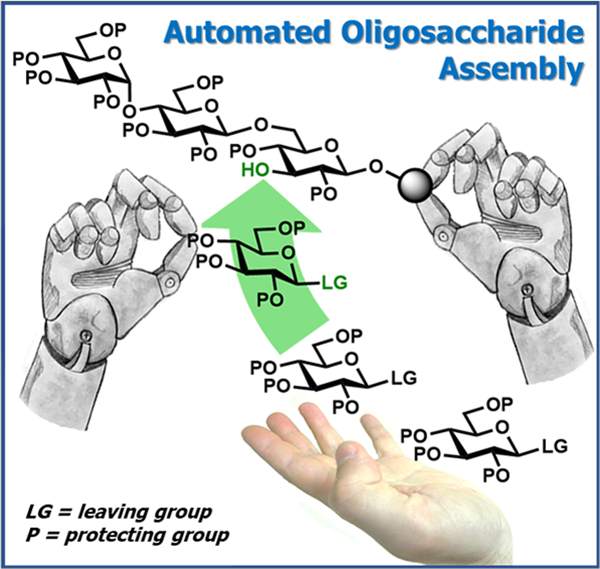
1. INTRODUCTION: CARBOHYDRATES, OLIGOSACCHARIDES, BIOLOGICAL ROLES AND MEDICAL IMPLICATIONS
Carbohydrates, the “essential molecules of life,”1 play key roles in various biological processes. Carbohydrates are involved from the very beginning of life: fertilization occurs through the carbohydrate–protein interaction.2 Carbohydrates contribute to human health by facilitating joint lubrication, cell growth, and the inflammatory and immune responses.3 The exponential increase in interest in sugars and the notable growth of all areas of glycosciences also reveals the involvement of carbohydrates in processes detrimental for human health. Viral infections, bacterial- and parasite-related diseases, metastasis, and rejection of transplanted tissues are only a few of these processes that can be mentioned.4 The pathogenesis of diabetes, septicemia, cancer, pneumonia, malaria, AIDS, and hepatitis are all carbohydrate-mediated processes. Understanding the roles of carbohydrates in these processes has stimulated many biomedical discoveries involving glycosciences.5–7 Investigation of carbohydrate composition,8 conformation,9 interaction with other molecules and with themselves10,11 are some other areas of inquiry in the field. Isolation of carbohydrates from natural sources represents a viable approach to providing samples for the biological testing of these molecules. However, it is chemical synthesis that allows access to both natural carbohydrates and their mimetics, which are often of interest due to their therapeutic4,12 or diagnostic13–15 potential. Challenges related to the synthesis and purification of carbohydrates and the lack of universal methods applicable to all systems is the key bottleneck of glycosciences. As a result, examples of large-scale development of carbohydrate-based pharmaceuticals including heparin and its analogs,16,17 antibiotics,18,19 glycoconjugate-based vaccines,20–24 and other applications6,7,25 are still rare.
Oligosaccharide sequences are found in numerous natural compounds and constitute the core of many therapeutics. The presence of glycans in glycoproteins, glycolipids, glycosaminoglycans, and in other conjugates presents a treasure of potential information on cellular differentiation and condition. Over half of all proteins in the human body are N- or O-glycosylated,3 and cell surfaces present a rich multitude of glycolipids and glycosaminoglycans, in addition to the presence of a variety of free oligosaccharides.26 Glycans carrying information on biological significance are found in every body fluid, on cell surfaces, and within cells.
Glycan biomarker discovery is accelerating aided by advances in separation, mass spectrometric analysis,27–29 and in glycanlectin array technologies.30 Efforts to map the entire glycome of a cell have recently been reported.31 Glycans have been identified as markers for many different forms of cancer including breast, colon, lung, etc.32–34 Increases or decreases in the levels of certain glycans and changes in branching patterns can indicate the presence and progression of disease.35 For example, one study showed that prostate cancer can be distinguished from benign prostatic hypertrophy via distinction of a specific glycoform by lectin binding.36 In cerebrospinal fluid, the presence of a unique N-linked glycan on transferrin has been used to distinguish Alzheimer’s disease from a condition arising from abnormal metabolism.37 Profiling of N-glycans on IgG has been found useful for following the metabolic disorder of galactosaemia.38
Many families of glycoconjugates represent important therapeutic targets. High mannose, hybrid, and complex N-glycan families (Figure 1A) that are involved in many fundamental processes,39–41 as well as in mediation of the pathogenesis of cancers,42 AIDS,43 Alzheimer’s disease,37 etc.38 have stimulated many synthetic developments.41,44–51 Another representative example is the globoside family of glycosphingolipids (Figure 1B; Neu, N-acetylneuraminic acid; Fuc, fucose), whose members present a broad range of significant biological roles as glycan biomarkers. For example, Gb3 is overexpressed in colorectal adenoma cells,52 in Burkitt’s lymphoma cells,53 and in breast and ovarian cancer.54 Gb3 is found on the glycolipid that accumulates in the lysosomes of individuals suffering from Fabry disease.55 Iso-Gb3 is found on natural killer T cells.56 Gb4 has been found to be enhanced and attached to longer fatty acid chains in vascular endothelial cells undergoing an inflammatory response.57 Stage-specific embryonic antigens SSEA-3 and SSEA-4 are glycosphingolipids found on the surface of human embryonic stem cells but not on differentiated cells.58 SSEA-4 was found expressed in a variant of nonsmall cell lung cancer cells59 and on embryonal carcinoma cells in the ovaries.60 Globo-H is a target antigen for the development of vaccines against prostate and breast cancer,61 for which clinical trials are underway. Globo-H and SSEA-3 have been found expressed on breast cancer stem cells.62 Many synthetic developments have been applied to the synthesis of globosides and Globo-H in particular.63–68 More examples of the value of glycans and glycoconjugates as biomarkers are steadily emerging.
Figure 1.
Representative structures of common linear and branched oligosaccharide motifs.
Oligosaccharides or glycans can be obtained by isolation from natural sources or prepared enzymatically and/or chemically. All three major approaches are viable, but none yet can significantly outperform the others. This review is dedicated to chemical synthesis, which, in spite of recent progress, remains challenging. As a result, synthesis of even moderately complex glycans and their conjugates still require significant resources. This limits accessibility of these essential targets to only a small circle of glycoscientists and inhibits their industrial production and application. Recent development of dependable techniques for oligosaccharide synthesis using traditional manual synthesis are introduced in section 2 of this review. An overview of very attractive and potentially transformative automated technologies that are expected to facilitate access to oligosaccharides is presented in section 3.
A majority of complex sugars are oligomers in which monomeric units (monosaccharides) are connected via glycosidic bonds. The latter are obtained by glycosylation, a reaction discussed in section 2.1. Certain mechanistic conventions discussed in section 2.1.1 have been established, and many factors that affect the outcome of glycosylations discussed in section 2 are known. Nevertheless, chemical glycosylation remains challenging. Oligosaccharide synthesis brings about further challenges (section 2.2). Both traditional (section 2.2.1) and expeditious strategies are known (section 2.2.2). Various one-pot strategies that offer a streamlined access to oligosaccharides have been developed (section 2.2.3). Supported and tagged synthesis has also been investigated (section 2.3). In particular, solid-phase synthesis, widely used in the preparation of oligopeptides and oligonucleotides, has also been applied to the preparation of oligosaccharides (section 2.3.1). This approach can streamline synthesis by eliminating the need to purify reaction intermediates and by simplifying the removal of excess reagents. Similar advantages are seen in the tagged synthesis wherein soluble polymer supports, ionic liquids, and fluorous-based protecting groups have successfully been used to expedite oligosaccharide assembly (section 2.3.1).
Dedicated attempts to automate oligosaccharide synthesis resulted in the development of a number of platforms and technologies for their automated chemical synthesis. These developments are reviewed in section 3. Early attempts by Takahashi and Wong to develop the automated chemical syntheses in solution set the benchmark in the field (section 3.1). Those early attempts have also shown difficulties associated with the automation. To expedite polymer-supported oligosaccharide synthesis, Seeberger introduced an automated approach. The automation was initially based on a modified peptide synthesizer (section 3.2). In 2012, Seeberger et al. reported the “first fully automated solid-phase oligosaccharide synthesizer” (section 3.4). Around the same time Pohl, Demchenko-Stine, and Nokami have developed alternative automation platforms discussed in sections 3.3, 3.5, and 3.6. Operation of all automated synthesizers is controlled by a computer. The greatest advantage of employing the computer interface along with liquid handling hardware and software is to allow recording successful automated sequences that can be then repeated over and over with an expected high degree of reproducibility.
2. TRADITIONAL MANUAL SYNTHESIS OF OLIGOSACCHARIDES
Glycosidic linkages are obtained by glycosylation, a reaction of the nucleophilic displacement of an anomeric leaving group (LG) on the glycosyl donor by a hydroxyl group of the glycosyl acceptor.69 The remaining functional groups of both reaction counterparts (hydroxyls, amines, and carboxyls) are masked with respective temporary protective groups. A detailed mechanism of chemical glycosylation is unknown, but certain aspects, factors, and pathways have been established.70–93 With a notable progress in the field of chemical glycosylation,83,86–88,94 this reaction remains challenging. Beyond that, traditional stepwise oligosaccharide synthesis requires careful strategic planning to achieve protecting and/or leaving group introduction/removal between glycosylation steps. In addition, purification and reagent separation become difficult with large oligosaccharide sequences. Many selective, chemoselective, and regioselective strategies have been developed to streamline oligosaccharide synthesis by reducing the number of additional steps.95 Other advanced techniques, such as solid-phase synthesis,96,97 have been developed to streamline oligosaccharide synthesis. These approaches reduce the need to purify reaction intermediates and simplify the excess reagents removal.
2.1. Chemical Glycosylation
Glycosylation reaction is the central reaction in glycochemistry. The glycosylation involves a promoter or activator-assisted reaction between a glycosyl donor and glycosyl acceptor. Along with the formation of a glycosidic bond, a new chirality center is produced. Therefore, particular care should be taken of stereocontrol. Discussed below are basic principles of chemical glycosylation and factors that have an effect on the reaction outcome. In addition to the glycosylation reaction, there are many competing processes that may simultaneously occur. Side reactions that often complicate stereocontrol of glycosylation and may have a profound effect on yields include, but are not limited to, migration, elimination, cyclization substitution, and redox reactions.69,98
2.1.1. Reaction Mechanism.
The promoter-assisted departure of the leaving group leads to the formation of a glycosyl cation that is stabilized via an oxacarbenium ion intermediate (Scheme 1). The acceptor attack on the flattened oxacarbenium intermediate can take place either from the top or the bottom face of the sugar ring. As a result, uncontrolled glycosylations may lead to the formation of mixtures of 1,2-trans and 1,2-cis glycosides. Typical glycosylation conditions favor a unimolecular SN1 mechanism, or may proceed at the SN1-SN2 interface,99 and the reaction involves four major steps.100
Scheme 1.
General Outline of the Chemical Glycosylation Reaction
Step 1. Formation of the activated donor as a result of the interaction of the LG and the promoter (A-B). This step can be either reversible or irreversible depending on the type of the leaving group used and the method of activation.93 There are a few reports indicating that the glycosyl acceptor attack may be directed to the activated donor.101–106 This SN2-like displacement pathway is quite desirable because it would allow for the stereospecific inversion of the leaving group. Step 2. Dissociation of the LG, a typically irreversible expulsion of the activated leaving group (LGA), is the rate-determining step (RDS). It leads to the formation of a glycosyl carbocation and/or its stabilized resonance form, an oxacarbenium ion. The latter is often responsible for scrambling the stereoselectivity of the reaction. Other intermediates, the existence of which is often ignored, or whose impact on the reaction is underestimated, may also form at this stage with or without counteranion B. Step 3. As a consequence of the sp2-hybridization of the anomeric (C-1) carbon and the existence of the oxacarbenium ion in a flattened half-chair conformation, the subsequent attack of the glycosyl acceptor is possible from both the bottom face of the ring (pathway a) and the top face (pathway b). As a result, “uncontrolled” glycosylation often leads to the formation of a mixture of products. Step 4. Upon the proton transfer, the formation of the glycosidic bond becomes irreversible (the termination step).80
The earliest reactions performed by Michael,107 Fischer,108 and Koenigs and Knorr109 at the turn of the 20th century showcased the complexity of the glycosylation reaction. At that stage, glycosylations of sugar acceptors were quite inefficient and even the synthesis of disaccharides represented a challenge. The first attempts to solve this problem gave rise to the development of new activators.110–112 The early attempts to improve the glycosylation reaction have also revealed the necessity to find a delicate balance between the reactivity and stereoselectivity.113,114
2.1.2. Building Blocks: Glycosyl Donors and Acceptors.
One of the main directions has been the investigation of leaving groups beyond the original halides, hemiacetals, and peracetates introduced by Helferich in 1933.115 Thus, in the 1970’s to early 1980’s, a few new classes of glycosyl donors were developed.116,117 This first wave introduced thioglycosides,118–121 1,2-orthoesters,122,123 O-imidates,124,125 thioimidates,126–128 and glycosyl fluorides129 as alternative leaving groups. Many glycosyl donors introduced during that period have become common even to this day. The next wave of new methods arrived in the late 1980’s. Among the new leaving groups introduced were glycosyl esters/carbonates,130–132 thiocyanates,133 diazirines,134 xanthates,135 glycals,136,137 phosphites,138,139 sulfoxides,140 sulfones,141 selenium glycosides,142 alkenyl glycosides,143–145 and heteroaryl glycosides.146 These developments were followed by a variety of more recent methodologies and improvements. These include glycosyl iodides,147 phosphates,148 Te-glycosides,149 sulfonylcarbamates,150 disulfides,151 2-(hydroxycarbonyl)benzyl glycosides,152 novel thio-,153,154 and O-imidates155,156 as well as alkynyl-based leaving groups.157–166 In addition, a variety of very recent methodologies167–169 have brought the use of classic glycosyl donors, such as glycals,170,171 hemiacetals,105,172,173 or halides174,175 to an entirely different level of flexibility and versatility.
Beyond studying the anomeric leaving group, protecting group effects have been investigated. Seminal work of Lemieux70 and Fletcher176,177 has led to appreciation that the reactivity of glycosyl halides and the stereoselectivity of glycosylation is directly correlated to the nature of the protecting groups, especially at the neighboring C-2 position. The participation of the neighboring 2-O-acyl substituent typically leads to the formation of 1,2-trans linkages.73,178 In this case, the oxacarbenium ion can be further stabilized via an acyloxonium (dioxalenium) intermediate. Since the bottom face of the sugar ring in the acyloxonium intermediate is blocked, the glycosyl acceptor will approach from the top face (Figure 2A). Following this method, a 1,2-trans linkage is typically produced with high stereoselectivity; however, sometimes 1,2-orthoesters or 1,2-cis-linked glycosides are formed.
Figure 2.
Directing neighboring participating groups at C-2.
Demchenko and co-workers introduced glycosyl donors equipped with a 2-O-picolinyl ether participating group that provides entire 1,2-trans stereoselectivity in glycosylations (Figure 2B).179,180 Mlynarski and co-workers investigated ortho-nitrobenzyl (NBn) as a participating group.181 Liu and co-workers investigated another alkyl participating group, o-cyanobenzyl (CBn) at the C-2 position of a glycosyl donor.104 An interesting feature of this glycosylation method is that a single glycosyl donor can yield either α- or β-linked products depending on the nature of the glycosyl acceptor.
The presence of a nonparticipating group at C-2 such as benzyl is typically necessary for the synthesis of 1,2-cis glycosides. However, the nonparticipating substituent alone cannot provide stereocontrol, which makes the synthesis of 1,2-cis glycosides much more challenging. Although the anomeric effect favors the formation of the α-product,182 the stereoselectivity of uncontrolled glycosylations can be low. In these cases, other factors for controlling stereoselectivity such as structural features of the reactants and reaction conditions become increasingly important. For example, Boons et al. introduced chiral auxiliaries capable of producing trans-decalin-like intermediates depicted in Figure 2C.183–187 This opposite face of the ring type of participation helps to obtain 1,2-cis linked glycosides with very high stereoselectivity.188 Turnbull and coworkers designed a similar concept showing that an oxathiane donor is also capable of highly α-selective glycosylations.189,190 Fairbanks showed the versatility of 2-(thiophen-2-yl)methyl derivatives for stereoselective 1,2-cis glycosylation.191
The effects of remote substituents, particularly those capable of steric hindrance, powerful electron-withdrawal, or long-range participation, have been known for some time.192–196 Observed for a variety of sugar series including D-galacto,197,198 L-fuco,199,200 L-rhamno,201 D-manno,202 and D-gluco,203 the remote effects can be weaker than those by the C-2 substituent. More recent studies, by Kim et al.,204 Nifantiev et al.,205 Crich et al.,206,207 Hung et al.,208 and others209,210 showed how important the remote effects can be. A somewhat unexpected effect was noted for remote picolinyl ethers (Pic) and picoloyl esters (Pico). While 2-picolinyl participates at the anomeric center via the six-membered ring intermediate (see Figure 2B),180 the action of the remote groups is different. It has been demonstrated that the nitrogen atom of the remote picolinyl/picoloyl groups is able to form a hydrogen bond with the hydroxyl group of the glycosyl acceptor. This leads to high syn-selectivity with respect to the picolinyl/picoloyl substituent.211 This reaction named H-bond-mediated aglycone delivery or HAD gave high α-gluco212 and β-manno213 selectivity even at room temperature. As an extension to this study, the synthesis of β-mannan213 and α-glucans214 has been reported. Mong and coworkers applied 6-O-picoloyl-2-deoxy glycosyl donors to stereoselective synthesis of β-glycosides.215 Very recently, De Meo216 and Tsai217 investigated the effect of picoloyl substituents on sialylations. Yang et al. employed a similar 2-quinolinecarbonyl group to stereoselective synthesis of β-d- and β-l-arabinofuranosides.218
Torsional effects induced by the cyclic protecting groups may also affect both the reactivity of glycosyl donors and/or the stereoselectivity of glycosylations. The work by Crich et al. on the synthesis of β-mannosides76,87,219–221 is the best known example of the deactivating (and stereodirecting) effect of the 4,6-O-benzylidene substituent. The benzylidene effect is due to torsional strain222 that restricts the conformational flexibility of the pyranose ring and also enhanced electron-withdrawal.223 A variety of other cyclic groups have been investigated. In particular, studies of 2-amino glycosyl donor protected with 2,3-trans-oxazolidinone by Kerns et al.,224–227 Oscarson et al.,228 Ye et al.,229–232 and Ito et al.,233,234 yielded useful techniques for the synthesis 1,2-cis glycosides and glycosyl donors with switchable selectivity. Crich et al. demonstrated the utility of the 2,3-O-carbonate protection for α-selective for mannosylation and rhamnosylation,206,235 as well as β-glucosylation.236 The effect of 3,4-O-carbonate protection is weaker, and it shows a slight bias toward β-selectivity.237 The 4,5-O,N-oxazolidinone protection of sialyl donors often provides high yields and α-stereoselectivities in sialylations and helps to suppress competing elimination.238–240
The effect of the glycosyl acceptor on the stereoselectivity of glycosylation has also been investigated. The mechanistic outline of the glycosylation reaction (vide supra) implies that the RDS is unimolecular and should not be affected by the nature of the glycosyl acceptor (Scheme 1). However, the donor–acceptor mismatch concept of Paulsen241 and Fraser-Reid and Lopez242–246 as well as the double stereodifferentiation phenomenon247 present a strong counterargument. In fact, different selectivities are often obtained for different glycosyl acceptors. Typically, the alcohol reactivity is inversely correlated with the stereoselectivity, whereas the most reactive hydroxyls give the lowest α/β-ratios. For instance, glycosylation of axial 4-OH of galactose often gives excellent 1,2-cis stereoselectivity. Occasionally, primary hydroxyl groups can lead to higher selectivity than their secondary counterparts, particularly for reactions partially proceeding via the bimolecular mechanism. Toshima et al. introduced a new technique that is based on the chiral recognition of aglycones.248
2.1.3. Reaction Conditions.
Several other factors including temperature, solvent, amount, and type of promoter used can influence the outcome of chemical glycosylation by affecting its stereoselectivity and yield. Kinetically controlled reactions at low temperatures favor the formation of β-linked products,249,250 although opposite results have also been obtained.251,252 The solvent effect on the stereoselectivity of glycosylation reactions has been widely studied.256,258–263 In general, polar reaction solvents increase the rate of the β-glycoside formation via charge separation between O-5 and β-O-1. If the synthesis of α-glycosides is desired, CH2Cl2, ClCH2CH2Cl, or toluene would be suitable candidates as the reaction solvents. However, there are more powerful forces than simple solvation. Thus, ethereal solvents are beneficial for α-selective glycosylation because diethyl ether,253 tetrahydrofuran,253 and dioxane254 have a tendency to form the equatorial O-linked intermediate. Conversely, nitrile solvents help the formation of β-glycosides because these reactions were thought to proceed via the axial glycosyl nitrilium cation intermediate.195,255 More recently, the Mong group suggested that in addition to the anomeric effect the formation of 1,2-cis nitrilium species is further reinforced by the participation of the oxygen atom at C-2.256 This would result in the formation of the glycosyl oxazolinium intermediate that is leading to the β-product as a result of the top-face nucleophilic attack (see refs 255, 257–262, 254, 256, 261, 254, 256–261, 254, 256–261, 253, 255–260, 253, 255–260, 252, 254–259).
Many decades ago, glycosylations of unreactive acceptors were very inefficient.109,110 Initial attempts to improve the glycosylation reaction by Zemplen111 and Helferich112 have also showed that faster reactions may result in lower stereoselectivity.113,114 Some reactive glycosyl donors can be activated under Lewis acid catalysis. The best-known examples of these leaving groups include trichloroacetimidoyl (TCAI),263,264 N-phenyl trifluoroacetimidoyl (PTFAI),265 and phosphites/phosphates.266 The use of transition metal catalysts based on palladium267,268 and nickel270,271 developed by Nguyen et al. for TCAI donors offers new opportunities for stereocontrol.167 Many other current methodologies for glycosylation, such as glycosylation with S-aryl/alkyl thioglycosides, use stoichiometric promoters. Bi(V)269,270 and Au(III)191 catalyzed activations of thioglycosides represent other new promising directions in glycosylation chemistry.169,269 Recently there has been an explosion in the study of gold-catalyzed activation of alkynes to exploit the low oxophilic character of gold and the excellent functional group compatibilities these catalysts exhibit.159,162,271–274
Another emerging approach is the use of (thio)ureas as organocatalysts for glycosylations with glycosyl chlorides.170,174,175,275,276 The underpinning idea for developing alternative methodologies for the promotion of glycosyl chlorides is to avoid the heavy metal catalyst utilized in traditional Koenigs-Knorr reactions.109,110 Ye and co-workers developed a catalytic system that makes advantage of the hydrogen-bond donor ability of urea.174 These activation conditions allowed for smooth glycosidation of per-benzylated galactosyl, mannosyl, and rhamnosyl chlorides. The glycosides were achieved in high yields and excellent α-stereoselectivities, but these reactions required the use of benzene as a solvent, high temperature, and long reaction times. For example, as depicted in Scheme 2A, activation of donor 1 with the urea-derived catalyst 3 for the reaction with glycosyl acceptor 2 in the presence of K2CO3 afforded disaccharide 4 in excellent stereoselectivity and yield. A phosphine additive, TTMPP, was found advantageous in achieving good selectivity with glucosyl donors.
Scheme 2.
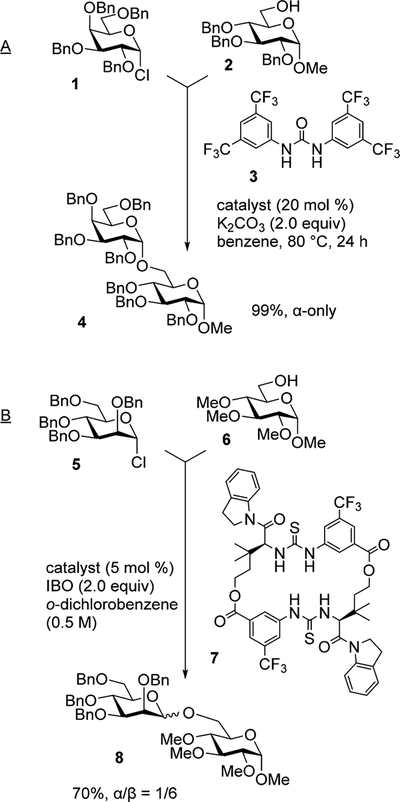
Examples of Urea and Thiourea-Based Organocatalytic Reactions
Very recently, Jacobsen and co-workers studied a series of chiral thiourea catalysts for the activation of glycosyl chlorides.175 In contrast to the previous example, the reaction affords disaccharides with high β-stereoselectivity, even in the absence of the neighboring participating group. The direct access to the formation of β-mannosides is another advantageous application of this reaction. For example, as depicted in Scheme 2B, activation of donor 5 with the chiral thioureaderived catalyst 7 for reaction with glycosyl acceptor 6 in the presence of isobutylene oxide (IBO) afforded disaccharide 8 in high β-stereoselectivity and yield. IBO is used as an electrophilic trap to scavenge HCl produced in these reactions. The reaction mechanism has been studied and some features, such as stereospecific inversion, in combination with the independence from the stereochemical relationship between electrophile and nucleophile suggest the SN2-like nature of the displacement.
In addition, over the recent years there has been a noticeable shift in focus of the mechanistic glycosylation chemistry field toward studying stereoelectronics and conformation of the starting material and key reaction intermediates.74,75,77,79,80,82,84,91,100,172,223,277–290 While the stereoelectronic and conformational effects on reactivity have been studied extensively, the impact of these effects on stereoselectivity remains elusive. Although some model studies helped to establish general trends,75,82,277–280,290,291 practical application of the conformational factors to stereocontrol of glycosylation is still limited. Reagent- or additive-controlled glycosylations and reactions with reagent-dependent switchable selectivity are becoming active areas of research.105,292–299
2.1.4. Special Cases and Indirect Methods.
While some sugar series follow general trends, there are classes of compounds and linkages that require special methods. These special cases of glycosylation include the following major classes of compounds. 2-Deoxysugars,300,301 that are discussed in a separate review in this special issue.302 2-Amino-2-deoxy sugars303 require additional steps and a careful selection of suitable protecting groups at C-2, most commonly 2,2,2-trichloroethoxycarbonyl (Troc) or phthaloyl (Phth), for the synthesis of 1,2-trans and azide for the synthesis of 1,2-cis linked glycosides. The difficulty of the direct β-mannosylation304 was addressed by developing a variety of indirect approaches such as C-2 oxidation–reduction, C-2 inversion, anomeric alkylation, and intramolecular aglycone delivery (vide infra).305,306 Crich and co-workers discovered that 4,6-O-benzylidene protected donors provide excellent β-manno stereoselectivity.76,87,219–221 The HAD method developed by Demchenko provides nearly complete β-selectivity in mannosylation at room temperature.213 Other useful approaches to the synthesis of β-mannosides include Kim’s o-carboxybenzyl leaving group approach152 and van der Marel’s C-5 carboxylate approach.307–310
An area of intramolecular glycosylation has also been developed to enhance the production of difficult glycosidic linkages. A better stereocontrol is achieved by tethering the reaction counterparts and restricting the glycosyl acceptor attack.311–318 The best known example, intramolecular aglycone delivery (IAD), was introduced by Barresi and Hindsgaul.319 Over the years, IAD has evolved into a powerful means to perform glycosylations of complex targets with high efficiency and yields.320–323 The major improvement of this approach has emerged with the implementation of a 2-naphthylmethyl group (Nap) as a tether group.323 A representative example is depicted in Scheme 3. The treatment of a mixture of donor 9 and acceptor 10 with 2,3-dichloro-5,6-dicyano-p-benzoquinone (DDQ) produces a mixed acetal that can be directly glycosidated in the presence of MeOTf and 2,6-di-tert-butyl-4-methylpyridine (DTBMP) followed by acetylation to give disaccharide 11 in an excellent yield of 90% and complete β-selectivity.323 Initially investigated for the synthesis of β-mannosides, α-glucosides, and β-arabinofuranosides,323 this approach was extended to the synthesis of β-rhamnosides324 and other challenging targets.315,325–331
Scheme 3.
Synthesis of β-Mannosides via Intramolecular Aglycone Delivery
The synthesis of 1,2-trans furanosides can be achieved with 2-O-acylated glycosyl donors.332,333 The synthesis of 1,2-cis furanosides is more difficult due to high conformational flexibility of the five-membered ring and lack of the anomeric effect. Recent advancements make use of glycosyl donors with the furanose ring locked into a single conformation. This was achieved with 2,3-anhydro,334,335 3,5-O-(di-tert-butylsilylene),336,337 or 3,5-O-tetraisopropyldisiloxanylidene338 protection. Young and co-workers successfully applied the HAD approach to 1,2-cis glycofuranosylation.218
In spite of extensive efforts and notable progress, the chemical synthesis of α-sialosides also remains challenging.339–344 Destabilizing electron-withdrawing carboxylate and the lack of a substituent at C-3 often drive sialylation reactions toward competitive elimination. This side-reaction leads to the formation of a 2,3-dehydro derivative. In addition, the lack of a participating group means that stereoselectivity of sialylations can be low. To overcome these problems, a variety of leaving groups, participating auxiliaries, and activation conditions for sialylations have been developed. In recent years, it became evident that the remote N-substituent at C-5 may have a strong effect both on stereoselectivity of sialylations and the reactivity of sialyl donors.342 A particular advance has been made with 4,5-O,N-oxazolidinone derivatives,238–240 and more recently with 5-isothiocyanate,345 that provide high yields and stereoselectivities in sialylations and help to suppress the competing elimination. An investigation of the effect of remote picoloyl groups at C-4 in the presence of excess of triflic acid offered new mechanistic insights into the sialic acid chemistry.216 This methodology has been extended to the synthesis of 7,8-dipicoloylated donors bearing benzoyl protection at the other positions.217
A number of methods that do not include a formal glycosylation step have been developed.346,347 Since these indirect procedures include multistep syntheses, practical application of these techniques is envisaged for the synthesis of glycosidic linkages that cannot be easily accessed by conventional technologies. O’Doherty developed a wellrounded methodology for Pd(0)-catalyzed glycosylations, wherein carbohydrate chirality centers are installed postglycosylationally. The de novo asymmetric synthesis methodology was instrumental for obtaining many mono-, di-, and oligosaccharide derivatives by means of palladium-catalyzed reactions.348–351
2.2. Oligosaccharide Synthesis
Glycosylation is only part of the challenge synthetic chemists confront during the synthesis of oligomeric sequences. A traditional stepwise approach requires additional manipulations after each glycosylation step. This multistep reaction cycle is then repeated again until oligosaccharide of the desired chain length is obtained. This becomes increasingly inefficient at the advanced stages of the assembly,95,352 often leads to a dramatic drop in yield, and as a consequence, lesser availability of glycans. Many advanced strategies that streamline oligosaccharide assembly by minimizing or even eliminating leaving or protecting group manipulations between coupling steps are based either on chemoselective or on selective activation of leaving groups.95 One-pot strategies help to expedite the oligosaccharide synthesis further. The one-pot sequences typically consist of the glycosylation steps only, but a minimal number of deprotection steps may also be included. Since all the sequential reactions are performed in a single flask (pot), the purification is only performed at the stage of the final product and purification of the intermediates is not required.
2.2.1. Conventional Linear and Convergent Block Synthesis.
A traditional stepwise approach requires additional synthetic steps for the conversion of the disaccharide intermediate into the second-generation glycosyl donor or acceptor. Modified disaccharides are then coupled with a glycosyl donor (or acceptor) to obtain a trisaccharide. This reaction sequence is then repeated again until oligosaccharide of the desired chain length is obtained. Despite the need for additional protecting group manipulations between the glycosylation steps, the linear approach is still in common use and a relevant example, the synthesis of the blood-group determinant H-type II pentasaccharide 23 is depicted in Scheme 4.353 Galactosyl phosphate 12 is glycosylated with acceptor 13 in the presence of trimethylsilyl trifluoromethanesulfonate (TMSOTf), followed by removal of the temporary levulinoyl (Lev) protecting group. The sequence is repeated with TCAI and phosphate donors, as well as Lev and 2-azidomethylbenzoyl (AMB) removable protecting groups, to afford the target pentasaccharide in 60% overall yield. Numerous improvements of this basic concept include the use of solid-supported synthesis354 or fluorous protecting groups355 that significantly facilitate separation of products from the reactants (vide infra).
Scheme 4.
Conventional Linear Oligosaccharide Synthesis with Alternating Glycosylation and Deprotection Steps
The convergent building block approach is a faster way to obtain larger oligosaccharides.356–358 In accordance with this strategy, oligosaccharide fragments are presynthesized and then converged by means of a glycosylation reaction. Additional protection/deprotection steps may still be required but the overall assembly is faster due to the use of oligomeric building blocks. The block synthesis is particularly useful for the purpose of the introduction of a “difficult” linkage at an earlier stage of the saccharide assembly.359 Convergent block synthesis also streamlines the formation of oligosaccharide sequences containing two or more repeat units.
A relevant recent example, the synthesis of ganglioside GP3, developed by Kiso and co-workers is illustrated in Scheme 5.360 The synthesis of this complex structure was designed to avoid the introduction of “difficult” units including ceramide, α-galacto, and unusual internal α-sialo linkages. Tetrasaccharides 24 and 25, both of which were obtained using a convergent [2 + 2] glycosylation strategy, were coupled in the presence of N-iodosuccinimide (NIS) and trifluoromethanesulfonic acid (TfOH) at 0 °C. As a result, an octasaccharide was obtained in 91% yield. The latter was reprotected and converted into TCAI donor 26 that was coupled with glycosyl ceramide acceptor 27 in the presence of TMSOTf affording the target ganglioside 28 in 77% yield. The recent synthetic effort in the area of convergent assembly field49,361–368 has culminated in the synthesis of a large mycobacterial arabinogalactan oligosaccharide containing 92 monosaccharide residues (92-mer) by Ye and co-workers.369
Scheme 5.
Convergent Block Synthesis of Ganglioside GP3
2.2.2. Expeditious Strategies for Oligosaccharide Synthesis.
Expeditious strategies streamline oligosaccharide assembly by minimizing or even completely eliminating manipulations between coupling steps.95 All of these approaches can be classified into the following major categories. First, chemoselective approaches wherein the reactivity of building blocks is modulated by the protecting groups. Second, selective approaches that are based on selective activation of certain leaving groups. Third, preactivation-based approaches that can be used with any protecting and leaving groups. Fourth, regioselectivity-based approaches rely on the differential reactivity of different acceptor groups.
Fraser-Reid’s seminal work on armed-disarmed approach showed that the building block reactivity can be modulated through the choice of protecting groups.370,371 Thus, benzylated (electronically activated, armed) building blocks are significantly more reactive than their acylated (Bz, disarmed) counterparts (Scheme 6A). Usually, protecting groups in both reaction components and careful selection of mild reaction conditions have to be taken into consideration to allow direct chemoselective activation of the armed glycosyl donor over the disarmed glycosyl acceptor. The convenience of this approach is that the same leaving group can be used for all building blocks in the sequence. However, “protecting groups do more than protect,”372 and this can affect the stereochemical outcome and limit the scope of the method. For instance, the classical armed-disarmed approach can only lead to the formation of cis–transpatterned oligosaccharide sequences.
Scheme 6.
(A) Chemoselective and (B) Selective Activation Approaches to Expeditious Oligosaccharide Synthesis
In recent years, the scope of the original armed-disarmed concept has been expanded,373 and a number of efforts to quantify or even predict the reactivity of building blocks have been reported by Fraser-Reid,222,374 Ley,375 Wong,376 and others.377 Wong’s study also revealed a number of building blocks that extend beyond the traditional armed-disarmed boundary. Boons showed that 2,3-O-carbonate protected glycosyl donors are less reactive than disarmed acylated derivatives.378 Subsequently, Demchenko reported that 2-Bn-3,4,6-tri-Bz protected donors are even less reactive than their disarmed per-Bz counterparts (superdisarmed). This unexpected protecting group effect was explained by the existence of the O2/O5 cooperative effect that takes into consideration the stabilization of reaction intermediates rather than only the electronics of the starting material.379 In this case, the destabilization of the glycosyl cation is due to the electronpoor environment of O-5 and the lack of anchimeric assistance.
Two concepts for superarming glycosyl donors have also emerged, further expanding the original scope of the armed-disarmed approach. First, Bols showed that superarming can be achieved by changing the equatorial-rich 4C1 conformation to an axial-rich skew-boat conformation by creating steric congestion with TBDMS protecting groups at the C-2, −3, and −4 positions.84,285–288 These donors showed a hefty 20-fold increase in reactivity over the armed per-benzylated counterparts because the conformational change simplifies transition of the starting material into the oxacarbenium ion that is most stable in the all-axial half-chair arrangement.75,277,278,280,291 Second, Demchenko reported building blocks wherein the superarming was achieved via the O2/O5 cooperative effect. Glycosyl donors equipped with the superarming 2-Bz-3,4,6-tri-Bn pattern were 10-fold more reactive than their armed counterparts.380–382 In this case, the stabilization of the glycosyl cation is possible both from the electron-rich O-5 and from 2-Bz via the anchimeric assistance. With the two different approaches to superarm glycosyl donors, conformational and anchimeric, Bols and Demchenko jointly developed a 2-Bz-3,4-di-TBS-protected glycosyl donor. Glycosylations with the hybrid donors were swift, high yielding, and β-selective.383,384 This study showed that the conformational arming is a powerful tool to increase the reactivity and to achieve excellent yields. The anchimeric arming effects are weaker, but the participation ensures complete 1,2-trans selectivity.
Another general concept to expedite oligosaccharide synthesis is to achieve selective activation of different leaving groups, and it is practically independent of the nature of the protecting groups (Scheme 6B). One example presented below has a unique alignment of six different leaving groups, which were selectively activated affording hexasaccharide 39 in only five steps (Scheme 7).385 First, thiocyanate glycoside donor 29 was activated with Cu(OTf)2 over S-thiazolinyl (STaz) acceptor 30 in 89% yield. Subsequently, disaccharide 31 was coupled with S-benzoxazolyl (SBox) glycosyl donor 32 in the presence of benzyl bromide to achieve the trisaccharide 33 in 67% yield. The latter was coupled with fluoride acceptor 34 in the presence of MeOTf to produce tetrasaccharide 35 in 87% yield. Tetrasaccharide 35 was then reacted with SEt acceptor 36 in the presence of AgClO4/Cp2ZrCl2 to afford the pentasaccharide 37 in 84% yield. Lastly, the coupling of O-pentenyl acceptor 38 with the pentasaccharide 37 using MeOTf as an activator produced hexasaccharide 39 in 72% yield.
Scheme 7.
Hexasaccharide Synthesis in Five Selective Activation Steps
Among all known selective activation strategies,95 Ogawa’s orthogonal concept is arguably the most advantageous.386,387 This technique used two chemically distinct glycosylation reactions, and the selective activation of two orthogonal leaving groups is then reiterated (Scheme 6B). The classic variation of the orthogonal activation involves building blocks bearing S-phenyl and fluoro leaving groups.388 As shown in Scheme 8, phenyl thioglycoside 40 is selectively activated over fluoride acceptor 41 in the presence of NIS/AgOTf. The fluoro leaving group of disaccharide 42 is then activated over thioglycoside acceptor 43 in the presence of Cp2Hf2Cl2/AgOTf. This selective activation sequence is then reiterated to provide tetrasaccharide 44. Ideally, the orthogonal approach allows for an unlimited number of reiterations of the two orthogonal leaving groups, which is conceptually very attractive. In practice, however, the yields, which are typically inversely correlated to the size of the glycosyl donor involved, decreased dramatically at the later stage of the assembly. A number of complementary combinations of orthogonal leaving groups and conceptual modifications have been implemented.385,387,389–399
Scheme 8.
Orthogonal Activation of Phenylthio Glycosides and Fluorides
A number of concepts for selective activation have been introduced.145,398,400 For example, in the two-step activation approach both glycosyl donor and glycosyl acceptor initially bear the same type of leaving group. In order to couple these two reactants, a different leaving group is introduced into the glycosyl donor. Upon the selective activation of the donor, this two-step activation sequence can be reiterated. Discovered for thioglycoside conversion into bromides,356 this approach was extended to other systems.371,401–403 For example, Danishefsky’s reiterative assembly approach involving glycal precursors that are converted into 1,2-anhydrosugars with dimethyldioxirane (DMDO)404 clearly illustrated the versatility of this strategy.137,405–407 Thus, 1,2-anhydrosugar 47 generated from glycal 46 could be activated over glycal acceptor 48 in the presence of ZnCl2 to afford 1,2-trans-linked disaccharide 49 in 81% (Scheme 9). The epoxidation-glycosylation sequence can be then reiterated to yield larger oligosaccharides.
Scheme 9.
Glycal-Epoxide Method for Iterative Oligosaccharide Synthesis
More recently, the versatility of the two-step activation was demonstrated by a one-pot preactivation procedure,408–410 according to which S-tolyl glycosides are converted in situ into a reactive intermediate. These preactivation types of couplings cannot be formally classified as oligosaccharide synthesis via selective activations, and it occupies its own niche.66,229,230,232,237,260,411–416 This strategy is particularly advantageous in conjunction with the one-pot oligosaccharide synthesis that will be discussed below.
A number of useful expeditious approaches are based on regioselectivity of different acceptor groups. Thus, a two-directional strategy for glycan synthesis makes use of a building block capable of reacting first as a glycosyl donor and then as an acceptor. For example, building block 50 is first glycosidated with the reactive glycosyl acceptor 51 and then glycosylated directly at the deactivated position (synthesis of 54, Scheme 10).417 Hydroxyl deactivation can be achieved by introducing electron-withdrawing groups at surrounding positions. The use of temporary masking moieties (trityl, silyl) that can act as protecting groups in the first step and then be removed directly during glycosylation has become a logical extension of this technique.418,419 The use of the glycosyl donor/acceptor unit on the solid support is another efficient way to “deactivate” the hydroxyl moiety in comparison to the solution-based acceptor (vide infra).420
Scheme 10.
Two-Directional Approach for the Synthesis of Pentasaccharide 54
2.2.3. Oligosaccharide Synthesis in One Pot.
One-pot strategies allow to streamline glycan synthesis because all glycosylations are performed in a single flask (pot) and do not require purification of intermediates.421–423 All one-pot strategies are based on the following five major concepts. The first approach discovered by Kahne and co-workers,424 remains the only pure one-pot concept because the synthesis is performed with all reaction components present in the reaction flask from the beginning. In all other approaches, the reactants are added sequentially, typically upon the consumption of the first batch of compounds. The fact that all reactants are present from the beginning implies that fine-tuning of all reaction components is required. In accordance with this concept, the most reactive leaving group reacts with the most reactive hydroxyl first. Subsequent reaction between the second-ranked reactive leaving group and second-ranked hydroxyl takes place after the first step has been completed, etc. The concept of the conformational superarming developed by Bols et al.287,288 was also applied to a one-pot synthesis with all three reaction components present from the beginning.287,384
The second approach is based on chemoselective activation wherein the reactivity of the glycosyl donor and acceptor is differentiated by varying the electronic properties of protecting groups.375–377 A relevant example is shown in Scheme 11 (synthesis of 59) wherein the sequential activation of 55, 56, and 57 was based on their relative reactivity, which was found to be 17000/162.8/13.1, respectively.376 In contrast to the first concept, building block 57 is added only after the reaction between 55 and 56 is completed, etc.
Scheme 11.
One-Pot Synthesis of Tetrasaccharide 59 via Chemoselective Activation
The third approach is based on selective activation of one leaving group over another. Since the number of leaving groups that can be aligned for multistep sequential activation is still limited only a few examples are known. Highlighted herein is the synthesis of a linear tetrasaccharide derivative 62 that was accomplished in 73% yield over three sequential glycosylation steps.425 This was achieved by the stepwise activation of SBox donor 60 over S-ethyl glycoside 61. The S-ethyl moiety of the disaccharide intermediate was then activated over STaz acceptor 30. Finally, the STaz leaving group of the trisaccharide intermediate was activated for the reaction with glycosyl acceptor 2 (Scheme 12).
Scheme 12.
One-Pot Synthesis of Tetrasaccharide 62 via Sequential Selective Activation of Building Blocks Equipped with Different Leaving Groups
The fourth approach is based on preactivation, and hence it is practically independent of the building block reactivity. A representative example illustrated in Scheme 13 deals with a straightforward synthesis of the tumor-associated carbohydrate antigen Globo-H hexasaccharide.66 Thus, preactivation of fucosyl donor 63 at −78 °C with p-TolSCl and AgOTf was followed by the addition of acceptor 64 along with a hindered base 2,4,6-tri(t-butyl)-pyrimidine (TTBP). The temperature was then increased to −20 °C, and the trisaccharide intermediate was formed. The reaction mixture was cooled again to −78 °C followed by the addition of AgOTf and p-TolSCl. After that, galactose acceptor 65 and TTBP were added, and the reaction mixture was warmed to −20 °C. When acceptor 65 has disappeared, the temperature was lowered to −78 °C and the sequence was reiterated for glycosylation of lactose acceptor 66. The resulting Globo H hexasaccharide α−67 was formed in 47% yield based on the four-component reaction that required only 7 h to complete the assembly.
Scheme 13.
Preactivation-Based One-Pot Synthesis of Globo-H Hexasaccharide 67
The fifth concept for one-pot oligosaccharide synthesis relies on the differentiation between various hydroxyl groups, such as primary versus secondary or equatorial versus axial, have been explored.426
2.3. Supported and Tagged Oligosaccharide Synthesis
Further breakthroughs in the area of synthetic chemistry came with the development of supported or tagged organic synthesis techniques. As a consequence, the last two decades have also witnessed dramatic improvements in the area of supported oligosaccharide synthesis. Supported synthesis is very attractive as it allows for the rapid synthesis of oligosaccharide sequences without the necessity of purifying (and characterizing) the intermediates. Another important advantage of supported oligosaccharide synthesis is that it simplifies reagent excess removal. It can be achieved either by filtration if insoluble polymer or other solid phase supports are used or, alternatively, by fractionation, extraction, or precipitation if soluble polymer supports or other supports/tags are employed.
2.3.1. Synthesis on Solid Phases.
Solid-phase synthesis using insoluble polymer supports (beads)96,97 has been widely used in the preparation of many classes of molecules of interest.96,97,427,428 Preparations of oligopeptides429 and oligonucleotides430 have been reported using insoluble supports. Merrifield431 was the first to report the synthesis of peptide chains using polystyrene beads. The introduction of solid phases into the carbohydrate synthesis is credited to Fréchet and Schuerch who reported the first oligosaccharide synthesis on solid support.432 Since those pioneering studies, the solid-phase synthesis has been widely utilized in a routine preparation of oligosaccharides and glycopeptides, and it is attracting renewed attention in connection with combinatorial chemistry433 and automation.354,434
The two main strategies used for solid-phase synthesis of oligosaccharide are called donor-bound and acceptor-bound. In the first approach depicted in Scheme 14A, the acceptor is bound to the resin either through the anomeric position or one of the positions away from the anomeric center. This approach has an important conceptual advantage by using highly reactive solution-based monosaccharide donor. As a result, the yields remain high, even at the advanced stages of the assembly. With the increasing size of the oligosaccharide, the solid phase bound reaction sites extend further into solution phase, which also contributes to high yields that are achieved by means of this strategy.
Scheme 14.
Glycosylation on Polymer Support
The second concept, the donor-based approach depicted in Scheme 14B, relies on the donor bound to the polymer support. After the glycosylation has occurred, the temporary protecting group on the acceptor is turned into a suitable leaving group and the chain elongation steps can be reiterated. In principle, the chain elongation can be continued directly, if a suitable set of orthogonal leaving groups is chosen. However, the main disadvantage of the donor-bound approach relates to the origins of the glycosylation mechanism. Glycosyl donors are much more prone to side reactions than are glycosyl acceptors. Donor that underwent a side reaction, or simply was hydrolyzed, cannot conduct further chain elongation and this will ultimately terminate the oligosaccharide sequencing. Also, the templated approach outlined in Scheme 13C, wherein both components are connected to the same polymer support has been investigated. Two-directional techniques, combining conventions of approaches A and B, are also known.63,420
Polymer beads or resins are the most commonly used supports for solid-phase synthesis. Polystyrene beads crosslinked with 1% divinylbenzene found broad acceptance in all fields since their introduction by Merrifield (Figure 3A).431 Initially invented for peptide synthesis applications, the resin was successfully introduced into the solid phase synthesis of oligosaccharides.432 The high loading capacity and the compatibility with many reaction conditions have been crucial for the popularity of polystyrene-based resins. Since then, different solid supports with different swelling characteristics have been explored: polystyrene grafted with different lengths of polyethylene glycol (PEG) groups led to the development of Tentagel (Figure 3B), Hypogel, and Argogel.
Figure 3.
Solid supports for oligosaccharide synthesis: (A) Merrifield’s resin, (B) Tentagel, and (C) JandaJel.
These resins are able to swell efficiently in both polar and nonpolar solvents and are capable of higher loading capacity. Another approach made use of modifying the cross-linker by employing a tetrahydrofuran-derived bridge (Figure 3C).435 This resin has been commercialized with the trade name of JandaJel. Although polystyrene resins are fairly inert, it is noteworthy that some of these resins tend to partially decompose in the presence of large amounts of TMSOTf.435 To address possible instability of polymeric resins, nonswelling porous materials have also been evaluated for solid-supported oligosaccharide synthesis, and controlled-pore glass436 and nanoporous gold437,438 are two such materials to mention (vide infra).
The linker plays a central role in the synthesis of oligosaccharides using solid-phases. Due to its labile nature, the linker itself has to be taken into account for orthogonality in respect to all protecting (or leaving) groups that will be manipulated during the various steps. For the same reason, various linkers stable under many different conditions have been developed for carbohydrate synthesis.354,439 In addition to known and widely used protecting group-derived linkers, such as succinoyl, alkoxybenzyl, and silyl-based linkers, a new wave of photoreactive, metathesis, or hydrogenation-removable linkers had emerged.44,440–455 In the subsequent effort to develop new linkers with a versatile installation and/or removal profile, recent developments included Reichardt’s spacer/linker,452 as well as Seeberger’s “Lenz linker,”456 safety catch linker,457 and photocleavable linker.458 Some examples of recently developed linkers are summarized in Figure 4. More recently, Seeberger at al. developed a traceless photocleavable linker that is capable of producing oligosaccharides with the free reducing end.459 The linker offered stability and yields comparable to the parent structure, making it a suitable choice for future applications. The cleavage is achieved using a flow photoreactor, shown to be far more efficient than the classical batch reactors.460
Figure 4.
Recently introduced linkers for polymer-supported oligosaccharide synthesis.
As mentioned, most of the solid-phase syntheses involve glycosyl acceptor-bound approach. One of the classical examples of this approach involves Schmidt’s synthesis of a branched saccharide 73 depicted in Scheme 15.461 Lactose derivative 68 was attached glycosidically to the carboxypolystyrene resin support in the presence of TMSOTf. The chain was then extended by sequential removal of the orthogonal protecting groups fluorenylmethoxycarbonyl (Fmoc) with triethyl amine Et3N and Lev with hydrazine acetate. Upon cleavage from the resin, achieved by the treatment with NaOMe/MeOH, and subsequent global acetylation with Ac2O/pyridine, hexasaccharide 73 was obtained in 43% overall yield.
Scheme 15.
Acceptor-Bound Approach to the Synthesis of Oligosaccharide 73
More recently, Boons et al. reported the synthesis of all-α-linked oligosaccharide 79 using chiral auxiliary mediated 1,2-cis glycosides on polymer support.186 As depicted in Scheme 16, glucosyl donor 74 was attached glycosidically to the hydroxypolystyrene resin support in the presence of TMSOTf. The chain was then extended by sequential removal of the orthogonal protecting groups Fmoc (with piperidine) and allyloxycarbonyl (Alloc) with Pd(PPh3)4. Upon cleavage from the resin and subsequent reprotection, pentasaccharide 79 was obtained in 25% overall yield.
Scheme 16.
Chiral Auxiliary-Assisted Synthesis of 1,2-cis-Linked Oligosaccharide 79
Most of the known syntheses involve a glycosyl acceptorbound approach, but examples involving glycosyl donor bound have also emerged. As reported by Danishefsky et al.,462 glycal 80 was attached to a Merrifield resin via a silyl linkage in the presence of diisopropylethylamine (DIPEA, Scheme 17). The polymer-bound glycal was then epoxidized with DMDO, and the resulting 1,2-anhydro sugar was glycosidated with acceptor 80 in the presence of ZnCl2 to provide the immobilized disaccharide. This synthesis was reiterated until the desired oligosaccharide was obtained. The latter was then cleaved off by the treatment with Bu4NF/AcOH to afford pentasaccharide 82 in 58% yield. Another similar example of the donor-bound approach include the synthesis of the Leb blood group antigen354,463 and selective activation of the SBox donor over solution phase thioglycoside acceptor.464
Scheme 17.
Donor-Bound Synthesis of Pentasaccharide82
The application of orthogonal strategy, which is another example of a donor-bound approach in polymer supported synthesis, was introduced by Ogawa.465 A more recent example of this approach is illustrated in Scheme 18. As reported by Kanie et al.,391,392 polymer-bound donor 83 was activated selectively over fluoride acceptor 84 in the presence of dimethyl(methylthio)sulfonium trifluoromethanesulfonate (DMTST). The immobilized glycosyl fluoride was then activated over S-phenyl acceptor 85 in the presence of Cp2Hf(OTf)2. Finally, the immobilized S-phenyl trisaccharide was glycosidated with octanol in the presence of DMTST. The resulting oligosaccharide was cleaved off and all eight diastereomers of 86 were separated by HPLC to provide a useful combinatorial library.391
Scheme 18.
Orthogonal Synthesis of a Combinatorial Library on Solid Phase
Short peptide chains immobilized on the solid support have been investigated as templates for streamlining the oligosaccharide synthesis by Fairbanks et al.466–468 and Warriner.469 As shown by Warriner, conjugate 87 containing the hydroxyproline-linked glycosyl donor and acceptor pair with the glycine unit in between produced (1 → 4)-linked disaccharide 89 in high yields (Scheme 19). A differential and highly substrate orientation-dependent stereoselectivity was observed by employing differently sequenced templates, such as 88.
Scheme 19.
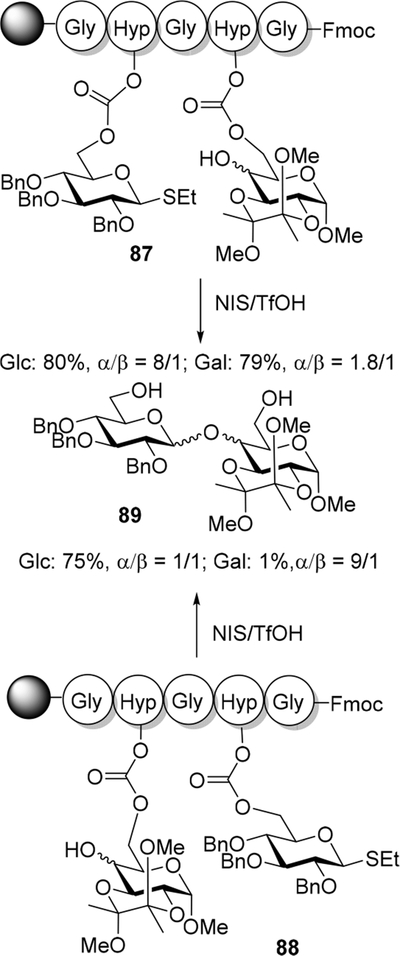
Peptide-Templated Oligosaccharide Synthesis on Polymer Support
The application of emerging nanomaterials to organic synthesis has created the basis of the STICS (surface-tethered iterative carbohydrate synthesis) technology, which is a functionalized “stick” made of chemically stable high surface area nanoporous gold that allows performance of cost-efficient and simple synthesis of oligosaccharide chains.438 Nanoporous gold can be prepared by dealloying Ag from Au–Ag alloy or from Au–Ag alloy electrodeposited onto a gold surface in the presence of nitric acid.470–473 As depicted in Scheme 20, a stack on NPG plates, carrying acceptor 91 anchored to the gold surface with a thiolate linker, is assembled in a Teflon-shelved reactor. The oligosaccharide assembly is accomplished by alternating the glycosylation, deprotection, washing, and drying steps. Thus, 6-O-TBDPS protected S-benzoxazolyl (SBox) glycosyl donor 90 was coupled to the immobilized acceptor 91 in the presence of MeOTf. Then, after a rinse, the tethered disaccharide intermediate was treated with Bu4NF to remove the silyl group to afford the second generation glycosyl acceptor. After being dried in vacuum, the latter was reacted with SBox donor 60. At the end of the synthesis, the oligosaccharide can be cleaved off from the gold surface offering a useful potential alternative both for directed and combinatorial synthesis.
Scheme 20.
STICS: Surface-Tethered Iterative Carbohydrate Synthesis
2.3.2. Tagged Synthesis (Soluble Polymer Supports, Ionic, Fluorous).
Soluble polymer supports, many of which are based on a polyethylene glycol core, have also found their application in oligosaccharide synthesis. This method has emerged to address problems of the resin-supported synthesis associated with slow reactions and reactivity mismatch between unreactive solid-phase based and highly reactive solution-based reactants.474,475 These supports, and everything attached to it, are freely soluble in the reaction media but could be precipitated by the addition of diethyl ether or other suitable solvent and recovered by filtration.476–478 Alternatively, nanofiltration or a size-exclusion separation offer other possible alternatives for separation of polymer-bound molecules and the rest of the reaction components.479 An elegant synthesis that combines advantages of the soluble polymer-supported technology and convergent building block strategy was applied to the synthesis of hexasaccharide 100 (Scheme 21).480 In this application, fluorenylmethoxycarbonyl (Fmoc) and diethylisopropylsilyl (DEIPS) are used as temporary substituents that could be removed with Et3N and TBAF, respectively, without affecting the linker. The polymer-bound intermediates obtained, such as 98, could be purified by recrystallization from absolute ethanol.
Scheme 21.
Synthesis of Dimeric Lex Hexasaccharide Using Soluble Polymer Support
Among other improvements of the supported oligosaccharide synthesis, fluorous tags incorporating a long per-fluorinated alkyl chain allow the separation of all fluorinated from nonfluorinated species by partitioning between perfluorohexanes and methanol (or toluene). The synthesis of oligosaccharide 105 is shown in Scheme 22.355 Triol 101 was protected at the O-2, O-3, and O-4 positions with fluorous protecting groups, using DCC/DMAP-mediated coupling with the fluorous acid 102. The resulting “tagged” compound was detritylated with CSA (camphorsulfonic acid) and LiCl to provide acceptor 104. The latter was glycosylated with glycosyl donor 103 in the presence of TMSOTf in EtOC4F9–diethyl ether to provide the respective tagged disaccharide. Desilylation with HF in pyridine followed by glycosylation were reiterated until the desired pentasaccharide 105 was obtained. More recently, less heavily fluorinated tags and compounds have found a broad application in automated synthesis (vide infra).
Scheme 22.
Fluorous Tag-Assisted Synthesis of Pentasaccharide 105
Another promising technique for tagged oligosaccharide synthesis that makes use of an ionic-liquid support has recently emerged.481,482 Ionic liquid-supported assembly also expedites oligosaccharide synthesis by eliminating the need for chromatographic purification of the intermediates. After the desired reaction of the tagged compound has been completed, the reaction mixture is concentrated. The excess of organic reagents is removed by extraction with low polarity solvents in which the tagged compounds are insoluble. Using the same principle, the inorganic reagents are eliminated with aqueous washings to afford the pure target compound tagged with the ionic liquid. This approach is illustrated by a synthesis that incorporates elements of an orthogonal strategy making use of alternating activations of STol and F leaving groups and the convergent approach depicted in Scheme 23.483,484 (1-Methylimdazoliumhexafluorophospho) acetyl ionic liquid tag was introduced via the corresponding 6-chloroacetylated starting material by reaction with N-methylimidazole and potassium hexafluorophosphate. The tagged mannosyl fluoride donor 106 was glycosylated with thioglycoside acceptor 107 to afford the IL-tagged disaccharide 110. Meanwhile, the analogous disaccharide 111 was produced using thioglycoside 108 as the donor and fluoride 109 as acceptor. Each disaccharide was split into portions, and the tag was removed from one portion. This gave a library of two disaccharide donors (110 and 111) and two disaccharide acceptors (112 and 113) that were converged to produce two tetrasaccharides. One of the tetrasaccharides was untagged to produce glycosyl acceptor 114. Finally, the synthesis is concluded with a [4 + 4] glycosylation between the tagged tetrasaccharide fluoride donor and thioglycoside acceptor 114 to afford the final mannan octasaccharide 115. Gouhier and co-workers485 reported efficient 1,2-cis glycosylations using ionic liquid-supported thioglycoside in a two-directional419,420 manner.
Scheme 23.
Convergent/Orthogonal Ionic Liquid-Tagged Synthesis of Mannans
3. AUTOMATED SYNTHESIS OF OLIGOSACCHARIDES
All traditional oligosaccharides contain multiple glycosidic linkages. This linkage is obtained by a glycosylation reaction, which, in spite of significant progress overviewed in section 2.1 remains challenging due to the requirement to achieve stereocontrol and suppress side reactions. Beyond that, as overviewed in section 2.2, oligosaccharide synthesis offers further challenges that may require further manipulations between each glycosylation step. Due to significant advances, the chemical synthesis of many glycans can now be streamlined by using various methods and strategies in solution. Solid-phase and tag-assisted syntheses, which were overviewed in section 2.3, eliminate the need for purifying intermediates and simplify the removal of excess reagents. Following significant advancements in the preparation of peptides429,486 and oligonucleotides,430 since 1971 solid-phase synthesis has become a viable means for the preparation of oligosaccharides.
However, there are significant differences between glycosylations in solution and solid-phase synthesis that particularly affect glycosylation. Among a plethora of leaving groups developed, a vast majority of glycosylations in solution make use of thioglycosides487–490 and TCAI.125,263,264,491,492 Solid phase synthesis commonly demands highly reactive TCAI, PTFAI,265,493,494 or phosphates.148,495–499 A series of novel S-and O-imidates have been tested in reactions on solid phases, but their comparison with more common donors showed no drastic difference.438,464,500–502 The use of thioglycosides as donors in solid phase has also been reported (vide supra), but their relatively low reactivity profile and the requirement for stoichiometric promoters limit their application. Only recently, the use of thioglycosides in solid phases has been brought to practical realization.503
The discoveries made over the course of traditional synthesis, wherein all manipulations are performed manually, have laid the basis for considering their automation as an aid in synthesis manipulations. Automation introduces an idea of operational simplicity, attractive for transferable methods, and the development of accessible methods for glycan production is essential for further innovations and practical applications in all areas of glycosciences. The development of automated oligosaccharides synthesizers offers a potential of revolutionizing the way oligosaccharides are produced. Hence, the development of a broadly useful technology for scalable and transformative automation has emerged as a timely and significant area of research.
Many automation platforms make use of a computer interface and liquid handling equipment. This helps to minimize the human error factor and improve the reproducibility of results and transferability to other platforms.504,505 The underpinning idea of automation is that a successful automated sequence is recorded as a computer program that can then be reproduced with a “press of a button”. In addition, many automation platforms implement some tool for real-time reaction monitoring, which, in turn, helps reduce the reaction time and the amount of reagents and solvents needed. This section is dedicated to the overview of major research efforts dedicated to the refinement and implementation of various automated platforms that have emerged in the past decade following early efforts to automate solution-phase manual synthesis by Wong376,506,507 and Takahashi508 and Seeberger’s peptide synthesizer-based platform for automated synthesis on solid phase.509,510 Discussed below is the development of “the first fully automated solid-phase oligosaccharide synthesizer” by Seeberger et al., initially in its experimental form,456 that in 2014 was marketed as Glyconeer 2.1. Also discussed are other automation efforts, primarily by Takahashi,511,512 Pohl,513 Demchenko and Stine,514 and Nokami and co-workers515 that have been also emerging during about the same time-period.
3.1. Early Developments
As aforementioned, Wong et al. assigned relative reactivity values (RRVs) to a wide library of building blocks that were then used for oligosaccharide assembly in one-pot.376 The determination of RRVs was made with tolylthio glycoside donors activated in the presence of an NIS/TfOH promoter system under standardized reaction conditions. The reactivity data was then compiled into a computer program named Optimer376 that was used to synthesize various oligosaccharides.516–518 Refer to Scheme 10 for a relevant example of a reactivity-based oligosaccharide synthesis in one pot. Not being strictly automated, this approach brought up an idea of standardizing the reactions and using computers in quantifying and even predicting the reactivity of different building blocks. Fraser-Reid,374 Ley,375,519,520 and others521 also created relative reactivity scales for oligosaccharide synthesis.
Takahashi et al. investigated a number of platforms for the automation of solution-based oligosaccharide synthesis in onepot. While the Wong approach was strictly chemoselective, in applications executed by Takahashi, selective activation of different leaving groups was employed. In 2000, they adapted a semiautomated parallel synthesis instrument Quest-210 by Argonaut Technologies to the one-pot synthesis of linear and branched oligosaccharides.508
Thus, for the synthesis of trisaccharide 119 shown in Scheme 24, bromide donor 116 was selectively activated over thioglycoside acceptor 117 in the presence of AgOTf. The anomeric thiophenyl leaving group of the resulting disaccharide intermediate was then activated by the addition of NIS, TfOH, and glycosyl acceptor 118 to afford trisaccharide 119 in 79% yield over two steps. Takahashi and co-workers further extended this effort to a number of automation platforms, such as L-COS by Moritex, that allowed one to automate temperature control, stirring, and rate of reagent addition for deprotection and glycosylation steps.511,522,512,523 The synthesizer could be supplemented with Combi Flash automated chromatograph to purify the final products.
Scheme 24.
Solution Phase Automation of the Oligosaccharide Synthesis in One Pot Using Parallel Synthesizer Quest 210a
aImage used with permission from Professor John Rimoldi.
3.2. Peptide Synthesizer-Based Automation
The automated approach Seeberger and co-workers relied on is the acceptor-bound one, where donor and promoter are in liquid phase.509 Since the early developments are already discussed in detail in other review articles,25,498,510,523–525 we will only briefly overview the key milestones and achievements. The main focus in this discussion will be placed on the dedicated effort and progress toward the synthesis of difficult glycosidic linkages. The instrument introduced by Seeberger and co-workers was derived from an Applied Biosystems Inc. Model 433A peptide synthesizer. It was modified to allow for performing reactions at low temperatures that were deemed necessary for the oligosaccharide assembly.509 The solid support chosen was Merrifield resin, well-known in the peptide world, for its good chemical inertness and ideal swelling properties in solvents utilized in glycan assembly. As it has been discussed previously, the choice of the linker is critical since it should resist conditions required during the synthesis. An olefin-type linker was chosen for its versatility and good behavior in both acidic and basic media, as well as the mild cleavage conditions. In the first synthesis depicted in Scheme 25, octenediol-functionalized resin 121 was glycosylated with TCAI donor 120 (10-fold excess) in the presence of TMSOTf. The ester group was then cleaved using Zemplen conditions to generate the disaccharide acceptor. The glycosylation and deprotection steps were repeated until the oligomers of the desired length, up to decasaccharide, had been achieved. Each step was performed in two iterations, to avoid the formation of deletion sequences, and hence maximize the yield and simplify the final purification. The linker was then removed using Grubbs’ catalyst to afford penta-, hepta-, and decasaccharides 122a–122c equipped with the anomeric pentenyl moiety. The high promise of the automated approach was evident immediately. Thus, heptasaccharide 122b was synthesized in 24 h in 42% overall yield. In comparison, whereas their previous manual synthesis was less efficient (9% overall yield in 14 days).443
Scheme 25.
Synthesis of Oligosaccharides 122a–122c Using a Modified Peptide Synthesizer
After this first milestone and with the intention of extending the scope of the new technology, the subsequent efforts performed by Seeberger et al. focused on the synthesis of oligosaccharides containing various challenging linkages.458,526–528 This included sialic acids,529 furanosides,530 1,2-cis glycosides,67 glycopeptides,460 and branched oligosaccharides.509 The expertise acquired in the development of this methodology for the synthesis of various glycosidic linkages and sequences led to an impressive synthesis of Globo-H hexasaccharide.67 As shown in Scheme 26, phosphate donor 123, was used to glycosylate hydroxylated resin 121 using TMSOTf as a promoter. The temporary Fmoc substituent at C-4 was removed using piperidine leading to the formation of the polymer-bound disaccharide acceptor. Fmoc is commonly used in oligosaccharide synthesis because it is highly stable in acidic conditions common for glycosylation, and it is easily removable in mildly basic conditions. In this particular application, the cleavage product of Fmoc, dibenzofluorene, is a convenient marker to monitor the progress of the reaction via colorimetric assay.531 The synthetic sequence consists of glycosylation steps with two or three iterations, using either glycosyl phosphate (123–126) or glycosyl PTFAI donors (127 and 128) followed by the deprotection of the Fmoc group with piperidine.
Scheme 26.
Automated Synthesis of Globo H Hexasaccharide
The final product 129 was cleaved off the solid support using ethylene in the presence of Grubbs’ catalyst532 in 30% yield. The stereoselectivity of the 1,2-cis glycosylation step was enhanced by using diethyl ether, which is known to favor the formation of axial products (vide supra). As aforementioned, Globo H is an important synthetic target of high biomedical significance for the development of anticancer vaccines.22,25,533–537 The biological importance of the Globo-H antigen is so widespread throughout the scientific community that many synthetic approaches have been developed.63–66,68
Seeberger and co-workers also developed reaction conditions to achieve β-mannosylation on a solid phase using an automated approach.538 They started from the methodology developed by Crich539 involving 4,6-O-benzylidene-protected mannosyl donors bearing a sulfoxide leaving group. In the original procedure, the donor is preactivated with Tf2O and then reacted with the nucleophile. To adjust the procedure to the automated synthesis, the solvent adopted was dichloromethane, and the preactivation was abolished. Unfortunately, although the selectivity of the test reaction was high, the yields were only moderate at best. On this basis, the next method of interest was the o-carboxybenzyl donor developed by Kim.152 After the initial study in the solution phase that revealed high yields and selectivities, the selected donor was tested on solid phase to synthesize a series of di- and trisaccharides. The stereoselectivity fluctuated from 3.5:1 to 9:1 in favor of the desired diastereomer, showing a partial erosion of the selectivity compared to that achieved in reactions in solution. Further, to facilitate the elongation of a sequence containing a β-mannosidic linkage, the donor was equipped with a triisopropylsilyloxymethyl ether (Tom) at C-3.540 This protecting group is removed under the same mild conditions as those that make the silyl protecting group ideal for synthetic application. The Tom substituent, however, is much less bulky than conventional silyl protecting groups, which is strategically significant for β-mannosylation.541 The donor was successfully used in the synthesis of a trisaccharide containing multiple β-linkages in excellent yield and good selectivity (Scheme 27). Mannose trisaccharide 133 was isolated in 50% yield as a mixture of anomers (8:1:1.3), and the pure β,β-linked product was isolated by HPLC. Van der Marel, Codee, and their co-workers have successfully applied a similar approach to the synthesis of ManA oligosaccharides.542
Scheme 27.
Automated Synthesis of β-Mannosides
3.3. Fluorous-Tag-Assisted Automated Synthesis
Fluorous-tag-assisted technology has emerged as a new and attractive approach to oligosaccharide synthesis with good prospects for automation. As discussed previously, extensively fluorinated species and highly fluorinated protecting groups allow for the separation of the fluorine-containing components, typically glycosyl acceptors, from the nonfluorinated glycosyl donors, with the principle of different phase partitioning between per-fluoroalkenes and methanol.355 On the other hand, Seeberger showed that the chemistry of solution-based microreactors, developed in the late 1990’s, could be applied to carbohydrate chemistry.543 The benefits of using a microreactor include: safety, a much greater control of the reaction temperature, and compatibility with various analytical techniques. Microreactors are amenable to automation, and the syntheses can be scaled up by increasing the number of reactors.
By merging these two technologies, fluorous-tagged synthesis and chemistry in microreactors, the synthesis of a homotetramer 136 was accomplished as depicted in Scheme 28.497 Three different syringe pumps delivered the solutions through the inlets into the mixing zone. The concentration can be controlled by the concentration of the original solution and the flow-rate at which each reagent is delivered into the system. The reaction occurs inside the reaction loop. Glycosyl phosphate donor 134 was first glycosidated with fluorous tag 135 in the presence of TMSOTf.
Scheme 28.
Fluorous Tag Supported Synthesis of a Tetrasaccharide 322 in a Microreactor
This was followed by the removal of the Fmoc group with piperidine and TBAF to afford the fluorous monosaccharide acceptor. Tetrabutylammonium fluoride proved necessary for removal of the 6-O-TMS byproducts. The latter was glycosylated with donor 134, and the deprotection-glycosylation sequence was repeated until the desired compound has been obtained. The product was then cleaved off from the fluorous support by the treatment with Grubbs’ catalyst to provide tetrasaccharide 136. The reaction can be followed by pairing the reactor with different detection systems including UV–vis detectors, IR, or mass spectrometers. The reaction times for the glycosylations were 20 s for the formation of the disaccharide and 60 s each for the tri- and tetrasaccharides. The yields for the reactions after purification were 97, 90, and 95% for the di-, tri-, and tetrasaccharides, respectively.
The Pohl group applied the fluorous-tag-assisted glycosylation approach to developing an alternative automation technology. This was accomplished by using a commercially available automated liquid handler and the fluorous solid phase extraction (FSPE) technique (Scheme 29).513 The handler was modified to accommodate cartridges for the FSPE. In this approach, the fluorous-tagged glycosyl acceptor 138 was glycosylated using an excess of TCAI donor 137 in the presence of TMSOTf as the promoter. The obtained tagged disaccharide was then separated using an automated three-step FSPE. This consists of loading into a separation column, and elution of all fluorine-free components using 20% solution of water in methanol. At last, the retained fluorinated molecules are released from the solid-phase using methanol or THF, which are fluorophilic solvents.
Scheme 29.
Automated Synthesis of Pentamannose 140 Using Fluorous Supporta
aImage used with permission from Victoria Kohout (Professor Nicola Pohl’s group).
This procedure can be automated by using commercially available devices capable of applying a positive pressure at the top of the column or, alternatively, vacuum at the exit of the eluate. After purification, the disaccharide was treated sequentially with TBAF and hydrazine to remove TMS and Lev protecting groups, respectively. The resulting triol acceptor 139 was triglycosylated using TCAI donor 120, to afford the desired pentasaccharide 140 in an excellent yield of 92%.
In an effort to pair an automated purification to the automated solution-phase synthesizer, Pohl’s group worked on HPLC as the preferred instrument to accomplish this purpose. An alternate-pump system that differs from a direct-pump design because it is based on recycling the analyte through two identical columns using a 10-port switch valve was utilized.544 The advantage of this alternate-pump design is that peak broadening is avoided. The broadening is caused by the internal volume of the mobile-phase solvent pump the analyte goes through, when pumped back into systems with direct-pump design. The valve switches between two different positions, A and B, as shown in Figure 5. Starting from position A, the compound elutes through the first column and the UV detector. When the analyte reaches the half of the second column, the system switches to position B, so that the second column is directly connected with the first one. When the compound travels back to column 1, halfway through column length, the system switches back to position A, and the system is now back to the original set up, with the UV detector between columns 1 and 2. Thus, the analyte passes through the detector every odd-numbered column, so after every run through column 1, for its purity to be assessed.
Figure 5.
Split-valve setup for the alternate-pump system.
After choosing the purification setup, the most suitable stationary phase was selected. Three different phases were considered: the commonly used C5, a phenyl hexyl, and a pentafluorophenyl (PFP) modified silica. The latter two were found superior in the separation of both monosaccharides and oligosaccharides with methanol as an organic modifier. In particular, after numerous tests, the PFP-modified silica was found to be more suitable for the separation of acylated monosaccharides and aromatic group-protected compounds, whereas the phenyl hexyl-modified silica worked better toward acyl protected oligosaccharides, respectively.545 This new methodology was used to purify the product of a reaction conducted in the automated synthesizer. The authors detected that sugars equipped with achiral linkers proved to be the most challenging compounds to purify through manual separation. In this case, the product was successfully purified using a PFP-modified stationary phase and seven effective columns.
Over the recent years, the Pohl group has applied the fluorous-tag-assisted automated synthesis to the synthesis of a number of glycan sequences.546–549 Among this is the synthesis of manno oligosaccharides connected via challenging β-linkages. This approach was based on the C-5 carboxylated mannosyl donor methodology developed by van der Marel for manual reactions.307 At first, the synthesis of 1,4-linked β-oligomanno-sides was automated using alternative glycosylation, TBS-deprotection steps to achieve the mannuronic hexasaccharide 144 sequence (Scheme 30).547 After each glycosylation and deprotection step, a FSPE is performed before reiterating the procedure to elongate the chain.
Scheme 30.
Automated Synthesis of β-Mannuronan and β-Mannan
As shown in Scheme 30, mannuronic acid donor 141 was used to glycosylate fluorous-tagged glycosyl acceptor 142 in the presence of TMSOTf as the promoter. The resulting disaccharide was treated with TBAF and acetic acid to remove the TBS protecting group and was subsequently purified using the automated FSPE. The sequence was repeated three times with the automated purification. The fourth iteration, followed by the benchtop purification, afforded the tagged compound 142. The latter was reinjected into the synthesizer, the TBS group was removed using tetrabutylammonium fluoride, and the resulting compound 143 was purified using FSPE. At the end of the assembly, the carboxyl groups are reduced with DIBAL-H using the automated platform to afford the desired β-linked hexamannose 144. More recently, Tang and Pohl applied a similar approach to the synthesis of other positional isomers of mannans.549 For the synthesis of 1,2- and 1,3 linked oligomers, glycosyl donors bearing an easily removable temporary PMB substituent at the respective positions were employed. At the end of the sequencing, the mannuronates were reduced with lithium triethylborohydride before the final benzyl removal leading to excellent yields. In the case of the synthesis of 1,6-linked mannans, the reduction of the carboxylic group is performed before the subsequent glycosylation instead of the protecting group removal.549 Excellent stereoselectivity for the glycosylation of all positions has been achieved; however, the elongation of the 1,2-, 1,3-, and 1,6-linked oligomannans beyond trisaccharides proved to be difficult. The reasons for this are not clear, but it could relate to the increased steric demand as the size of the acceptor increases.
This approach was also applied to the synthesis of branched, all-mannosylated N-linked glycan structures.546 The core N-glycan structure is characterized by the presence of a β-mannoside carrying two α-mannosides at O-3 and O-6 (refer to Figure 1). As shown in Scheme 31, the formation of the difficult linkage is addressed using the strategy of the C-5 carboxylate methodology (vide supra). The branching point has a PMB to mask O-3 and the carboxylic group working both as directing and protecting group. The automated sequence consists of the glycosidation of donor 145 with the fluorous tag 146. p-Methoxybenzyl group is removed in the presence of CAN, followed by the automatic purification of the tagged monosaccharide using the FSPE. Further benchtop purification to eliminate the undesired α-isomer afforded mannuronate 147 in 78% yield. The latter was reduced to obtain free hydroxyl at the C-6 position, and the product was purified. The subsequent glycosylation performed with six equivalents of donor allowed for bis-mannosylation. Benchtop Zemplen reaction afforded trisaccharide 148 in 50% yield. The synthesis was completed by removing the benzyl group and the fluorous tag.
Scheme 31.
Automated Sequence to the Branched Oligomannan Fragment from N-Glycans
3.4. Glyconeer 2.1 as a Dedicated Oligosaccharide Synthesizer
After proving that a peptide synthesizer-based apparatus may be a viable platform for oligosaccharide synthesis, Seeberger and co-workers took one step further. In 2012, they reported the “first fully automated solid-phase oligosaccharide synthesizer”.456 This dedicated apparatus is a sophisticated system, consisting of a syringe pump-driven part and a solenoid valve-driven part. The reaction vessel is double-jacketed to allow for the circulation of the cryogenic fluid. It is connected to the inlet tubes to avoid splashing of the solution injected and to allow for washing the vessel walls. The bottom of the vessel is equipped with a porous glass filter and pipelines that can be directed to waste or to a fraction collector. An exhaust opens only if a positive pressure of argon is used. This also helps to ensure the compete isolation from external atmosphere. The system is built with two syringe pumps, but only one is used.
It is filled exclusively with 1,2-dichloroethane to avoid solvent contamination. Four rotary valves are designated to regulate the delivery of building blocks and reagents for activation and deprotection. The solenoid valves are used to deliver solvents, mix reactions solutions, and manage the waste delivered from the reaction vessel. In addition to the parts already described, a cryostat operating between −50 °C and −90 °C and a fraction collector are important features of the synthesizer. The instrument is paired with a computer that helps to design, record, and control glycosylation and deprotection protocols. This setup provides complete automation for reactions, temperature control, cleavage, and collection of the final product. The complexity and the number of channels available, combined with the positive pressure of Argon throughout the whole system, make the Glyconeer 2.1 the most complete and versatile synthesizer currently available, allowing for achieving a significant variety of reaction conditions. The versatility of the new system was tested by performing the synthesis of a range of oligomers, including a high mannose-type branched glycan 153 as illustrated in Scheme 32. The new linker 150 was also developed for this purpose. This linker helps to ensure better stability during the glycosylation conditions.
Scheme 32.
Automated Synthesis of N-Glycan Core Using the Dedicated Synthesizer
The chitobiose portion of the core pentasaccharide sequence was assembled first, using glycosyl donor 149 for both units. After the two glycosylation-deprotection cycles, a challenging β-mannosyl residue was introduced by utilizing glycosyl donor 131 equipped with the 2-(hydroxycarbonyl)benzyl leaving group originally developed by Kim and co-workers. Subsequent treatment with TBAF to remove the silyl protecting group at C-3 and a selective opening of the benzylidene group afforded the desired 3,6-diol, which was subjected to bis-mannosylation using glycosyl donor 151 to afford a branched pentasaccharide. Cleavage from the solid support was performed using MeONa, affording the precursor 152 as a mixture of two anomers (α/β = 1/3) in 3.5% overall yield. Preparative HPLC separation was used to isolate the desired product, which underwent global deprotection using hydrogenation to afford the final product in 78% yield.
Subsequently, relying on a similar technology, Seeberger et al. obtained an α-(1 → 6)-linked oligomannan sequence containing 30 monosaccharide residues (triantamer).550 To achieve this challenging target, a modified Merrifield resin 155 carrying a photocleavable linker was used. The solid support was repeatedly glycosylated using phosphate donor 154 in the presence of TMSOTf as a promoter (Scheme 33). To avoid the formation of many deletion sequences and to make the final separation easier, the unreacted hydroxyls were capped with Ac2O in pyridine. Piperidine in dimethylformamide was used for the cleavage of the Fmoc protecting group from C-6 to afford the next generation glycosyl acceptor. The presence of benzoyl esters on the other positions allowed for complete stereoselectivity of the glycosylation reactions and high yields. The 29-mer resulting from 28 iterations of the glycosylation-capping-deprotection sequence was then glycosylated with donor 156, equipped with a spacer to perform a very effective cap-and-tag purification. Therefore, upon removal of the oligosaccharide 158 from the solid support, a conjugation step to magnetic beads through the ε-aminocaproic ester spacer was performed. The purification step consisted of a magnetic separation of the tagged 30-mer 159, followed by release using Zemplen conditions also to remove benzoyl protecting groups. Finally, hydrogenation was performed to free the terminal amine of the linker from the Cbz group, resulting in the fully unprotected 30-mer 160, obtained in 1% yield, which corresponds to 96% yield per synthetic step.
Scheme 33.
Automated Synthesis of Manno Triantamer 160
In the further development of the Glyconeer synthesizer, Seeberger et al. successfully synthesized mannosyl 50-mer 162 (penindamer), the longest sequence ever obtained with a solid phase automated approach.551 The approach is similar to the one used for the synthesis of the 30-mer, although an important methodological advancement has emerged with the implementation of the ethylthio glycoside as the glycosyl donor (Scheme 34). In this application, the glycosyl donor 161 was activated with NIS in the presence of TfOH at −40 °C. The temperature was immediately ramped up to −20 °C, and the reaction was completed in 20 min. The study of the most suitable building block highlighted a donor carrying a permanent benzoyl group at position 2, to ensure neighboring group participation and therefore high selectivity. C3 and C4 are protected with arming benzyls370 and position C6 is carrying a temporary Fmoc group, removed with Et3N in DMF every iteration. To facilitate the purification process, which revealed to be challenging for deletion sequences longer than n-5, a capping step was introduced after every glycosylation step. Furthermore, in the latest cycles, from 46 to 50, a second glycosylation was added to the sequence to ensure even better conversion during the elongation. Since these additional steps are expensive in terms of time, a 25-mer was synthesized as a proof of concept, to show that the capping steps become necessary only in the latest stages of the sequence. The approach proved to be successful allowing an easy separation of the desired product from the shorter oligomers and a higher average yield for each step. The purification was achieved by HPLC before the deprotection steps and later on using dialysis and size-exclusion chromatography.
Scheme 34.
Automated Synthesis a 50-mer 162 Using Glyconeer 2.1a
aImage used with permission from Professor Todd Lowary.
For expanding the scope of the automated oligosaccharide synthesis, the Seeberger group also worked on refining reaction conditions for the formation of other challenging glycosidic linkages. For example, a number of efforts were dedicated to the formation of sialylated oligosaccharides. Previously, sialic acid containing disaccharides were presynthesized and then used as building blocks in the convergent solid phase synthesis.529 More recently,499 the use of more sophisticated sialyl building blocks based on the 4,5-oxazolidinone chemistry238–240 allowed for direct sialylation in the synthesizer. These new sialyl donors were also equipped with chloroacetyl protecting groups at positions C-7 and C-8, and position C-9 was protected with Fmoc. A similar protecting group pattern, along with the phosphate leaving group, showed good levels of reactivity in sialylation reactions in solution developed by Wong and Wu.552 After optimizing the glycosylation conditions and reaction temperature, this approach was successfully applied to the automated synthesis of α-(2,6)-linked sialosides. A representative example is shown in Scheme 35, wherein the target disaccharide was synthesized from building blocks 161 and 162. The immobilized disaccharide 165 was obtained from the reaction of the photocleavable linker 155 with donor 163 in the presence of TMSOTf.
Scheme 35.
Automation of the Sialylation Reaction
Capping of the unreacted linker with acetic anhydride in pyridine, followed by removal of the Fmoc protecting group with triethylamine (TEA) in dichloromethane, afforded the immobilized acceptor. Phosphate sialyl donor 164 was then activated in the presence of TMSOTf. Finally, the photocleavage provided the target compound 165 in 10% overall yield. The yields for the formation of α-(2,3)-linkages were lower. Another approach to sialooligosaccharides involved a chemoenzymatic synthesis.553 In accordance with their strategy, a desired oligosaccharide sequence was assembled using the synthesizer first. After the cleavage from the solid support, the target compound underwent the entire protecting group removal followed by enzymatic sialylation. This step was accomplished in the presence of α-(2,3)-sialyltransferase from Pasturella Multocida that was originally introduced by the Chen group.554 As a result, the desired α-(2,3)-linked products were isolated in 78–89% yields.553
Seeberger and co-workers also studied the automated synthesis of 1,2-cis-linked residues that are abundant both in microbial glycans and in the mammalian glycome. In particular, reactions assisted by the remote group participation were of particular interest to this application. An overview of compounds 170–176, synthesized using the Glyconeer 2.1, is depicted in Figure 6.
Figure 6.
Representative 1,2-cis-linked oligosaccharides synthesized using Glyconeer 2.1
A systematic study of differently protected galactosyl and glucosyl donors was performed.555 The highest stereoselectivity was obtained with the galactosyl donor carrying acetates at the C-3 and C-4 positions. Glucosyl donor required esters at the C-3 or C-6, and depending on the desired propagation site, either a removable Fmoc carbonate or more permanent acetate were used. A representative example is the all α-linked oligomer 169 depicted in Scheme 36, achieved from glucosyl donors 166, 167, and 168. Thus, donor 166 was glycosylated in the presence of NIS and triflic acid to the photocleavable linker. The Fmoc protecting group was removed with triethylamine in DMF to obtain the immobilized monosaccharide acceptor.
Scheme 36.
Automation of 1,2-cis Glycosylation
The sequence was repeated to obtain the disaccharide. Then donor 167 was glycosylated in the previous conditions, and Fmoc protecting group was removed, affording the immobilized trisaccharide. Finally, donor 168 was reacted with the trisaccharide acceptor and photocleavage was performed to afford the final tetrasaccharide 169 in 20% overall yield and with excellent α selectivity.
Among other useful methodologies for the synthesis of 1,2-cis-linked oligosaccharides is the solid-phase synthesis of β-mannosides developed by Codee and co-workers.542 Glyconeer 2.1 was used as a platform for automation of glycosidation of mannuronic acid donor 177 equipped with a N-phenyl-trifluoroacetimidoyl leaving group. Glycosylations promoted with TfOH at −40 °C produced oligosaccharides in high yields and complete β-selectivity. Thus, as depicted in Scheme 37, a 1,2-cis-linked dodecasaccharide 179 was synthesized in 11% overall yield. Donor 177 was first coupled to linker 178, and each glycosylation step was repeated twice with about 90% coupling efficiency. The Lev protecting group removal was achieved with hydrazine acetate in a mixture of pyridine and acetic acid. Upon completion of the assembly, cleavage from the solid support was performed using a metathesis reaction with ethylene in the presence of Grubbs I catalyst. Complete selectivity of the target compound was proven by NMR.
Scheme 37.
Automated Synthesis of β-Manno-Linked Dodecasaccharide 179
Within a plethora of applications for the Glyconeer 2.1 automated synthesizer, there has been the synthesis of a number of oligosaccharides containing furanosyl residues. The first result accomplished was the synthesis of a series of linear and branched oligoarabinofuranides,530 as depicted in Scheme 38. Thus, ethylthio glycosyl donor 180 is glycosidated with linker acceptor 150, followed by removal of Fmoc group at C-5 in the presence of piperidine in DMF. The donor 181, used for branching, is coupled to the immobilized monosaccharide in the presence on NIS and triflic acid, followed by treatment with piperidine in dimethylformamide to remove both Fmoc protecting groups. The resulting disaccharide was treated with donor 180 in the presence of NIS and TfOH, followed by a deprotection step, in two iterations, to obtain the immobilized pentasaccharide. Finally, treatment with sodium methoxide in methanol and catalytic hydrogenation afforded the target compound 182 in 63% yield. The synthesis was completed in only 42 h. The first application of the use of furanose building blocks in solid phase was the synthesis of oligoxylanopyranosides.556 These structures are based on a linear series of β-(1,4) linked xylosides with the furanoses as branches in selected position. The oligosaccharides obtained in good yield are used to study the binding preference of antixylan monoclonal antibody557 on microarray systems.558
Scheme 38.
Synthesis of the Branched Hexasaccharide Composed of Multiple Arabinofuranosyl Residues
The other two series of compounds synthesized by Seeberger and co-workers are types I and II arabinogalactan (AG).559,560 These are present in plant cells, and they can be useful to study arabinogalactan-directed antibodies binding specificity. Type I is present in pectic polysaccharide as a decoration of the main backbone and characterized by β-(1,4) linkages connecting Gal units for the linear chain, and the branching is achieved by α-(1,3) bonds between arabinofuranosides and galactosides.561 Type II, on the other hand, is present as a highly branched polysaccharide attached to a hydroxyproline-rich peptide structure. The linear backbone of the glycan is based on β-(1,3) linkages, while the branching occurs through β-(1,6) bonds.562 The arabinofuranoses present on the branching are connected by α-(1,3) linkages as in the case of the type I AG. The target compounds were obtained in good-to-excellent yields. The effort in the assembly of various arabinofuranosides containing oligosaccharides culminated in the formation of 2 complex structures containing the former and mannopyrano-sides.563 These oligosaccharides are present on the cell surface of the Mycobacterium tuberculosis564 and constitute a synthetic challenge for their complexity. Three different building blocks are required for the assembly of the product. They are all ethylthio glycosides and protected with Fmoc on the position of elongation and branching.
Another important application of this dedicated system is to the synthesis of different families of GAGs (glycosaminogly-cans). These compounds are connected to a transmembrane core protein, with the function of transducing signals to the interior of the cells from extracellular environment.17 The first target was chondroitin sulfate, containing β-d-glucuronic acid and N-acetyl-β-d-galactosamine, presenting various sites of acetylation and sulfation. The advantage of the solid phase in the preparation of this polysaccharide is the establishing of a general method that with a few building blocks allows reaching a wide number of targets, hence the possibility of better understanding their biological relevance.
The selected chondroitin sulfate-A and chondroitin sulfate-C hexasaccharides are similar in structure and differ only in the site of sulfation along the chain. As in cases previously described here, donors contain the phosphate leaving group, the selected protecting group for the chain elongation is Fmoc, allowing mild cleavage conditions, while Lev esters mask the hydroxyl used for the introduction of sulfates. The amino group in the galactosyl building block 183 carries a trichloroacetate as a protecting group and the linker 155, already utilized by Seeberger and coworkers, is UV labile. The synthetic sequence is based on the coupling step with alternating GalNAc 183 and GlcA 184 building blocks followed by deprotection of the Fmoc group. The acetylation at the end of the chain, the Lev group removal, and the sulfation are also performed using solid phase protocols, affording the desired compound 185 in good yield (Scheme 39).
Scheme 39.
Synthesis of a Chondroitin Sulfate
The second target was dermatan sulfate, which is a polysaccharide composed by a disaccharide repeating unit, consisting of N-acetyl-β-d-galactosamine and l-iduronic acid.565 Seeberger et al. developed a synthesis of a di- and a tetrasaccharide using the Fmoc protection at the oligosaccharide propagation position and the Lev ester at the future sulfation sites. Galactosamine is readily available in a small number of steps, while iduronic acid requires a more complex synthesis.566 Both donors are equipped with a phosphate leaving group, and the linker utilized is the photocleavable one found in many other automated assemblies developed by the group. The yield of the two compounds obtained, a disaccharide and a tetrasaccharide, are high and consistent even when the larger acceptor is involved, averaging both 93% for each step.567
Other families of GAGs studied by Seeberger and co-workers include oligo-N-acetyllactosamine and keratan sulfate.563 The automated glycan assembly was employed to achieve a fast and facile access to a large library of compounds. For this purpose, the photocleavable linker and three orthogonal protecting groups (Fmoc, Lev, and Nap) have been utilized. The orthogonal protecting groups gave a streamlined access to keratan sulfate oligosaccharides with differential sulfation sites. The obtained products were printed on microarrays and used to study the interaction with viral receptors. One of the keratan sulfate tetrasaccharides was identified as a specific interaction partner of receptor AAVrh10.
Codee and co-workers reported the synthesis of different chains of hyaluronic acid (HA), another common class of GAGs.542 HA is a major component of connective tissue and extracellular matrix. Besides structural functions, HA has a role in inflammatory response, cell–cell adhesion, and recognition. Being able to access fragments of HA would be beneficial for studying its interaction with protein CD44, related to tumors proliferation. Common challenge for all GAG syntheses is the low reactivity of building blocks that has been addressed by applying them in large excess. As depicted in Scheme 40, the assembly started with PTFAI glucosamine donor 186 that was coupled with linker 178 in the presence of TfOH. The chain is then elongated with the removal of the temporary Lev protecting group and subsequent glycosylation with disaccharide donor 187. After repeating the glycosylation-deprotection cycle, the products are released through olefin metathesis and purified using HPLC to afford the desired hepta-, undeca-, and pentadecasaccharide in 26, 32, and 18% yield, respectively.
Scheme 40.
Synthesis of Hyaluronic Acid Fragments
To show the versatility and the wide range of application the automated glycan assembly system is suitable for, Seeberger and co-workers developed a sequence where peptide and oligosaccharide solid phase syntheses are coupled.460 Homogeneous glycopeptides are extremely valuable because regularly these compounds are isolated in heterogeneous mixtures that make difficult the determination of the structure–activity relationship. Normally the strategies for construction of a glycopeptide require the preformation of glycosylated amino acids in the solution phase.368,568 The presented approach is advantageous because it utilizes a simple building block, readily available and with minimum synthetic requirements. Elongation of the peptide chain proceeds through Fmoc approach, using HBTU as coupling reagent and piperidine to remove the protecting group. Serine and threonine side chains are protected as tert-butyl or trityl ether to be removed before the glycosylation step, achieved using TMSOTf.
To illustrate the versatility of the approach, three glycopeptides were synthesized, including compounds with 1,2-cis linkages, requiring elongation on the glycan side and with more than one glycosylation site. All the syntheses were performed in good yields and selectivity and established the Glyconeer as a promising system to address the challenges in glycopeptides assembly (Scheme 41). The possibility of accessing large and complex oligosaccharides is particularly powerful in terms of understanding the specificity of various enzymes. The knowledge acquired through the synthesis of furanose-containing oligosaccharides was useful to study the xylan-degrading enzyme since the arabinoxylans are suitable for a large number of applications, including biofuels and nutritional and pharmaceutical functions. The synthetic approach is based on the Fmoc strategy for the elongation of the linear chain and using fully orthogonal Nap and 2-(azidomethyl)benzoyl (Azmb) for the branching. After incubation with the enzyme, the fragments were studied using LC–MS.569
Scheme 41.
Glycopeptide Synthetic Sequence
A similar strategy has been used to study the hydrolysis of mixed-linked glucan chains by lichenase enzyme. This family of glycans is composed by linear 1,3- and 1,4-linked glucans, which form a gel-like material, important for the structural functions of the cells. Although the synthetic approach is similar to the general one used by Seeberger and co-workers, the formation of the 1,3-linkages was particularly challenging, requiring two glycosylation steps to avoid the formation of the deletion sequence. Again, the oligosaccharides were incubated with the enzyme and the digestion product analyzed via LC-MS, revealing new important features of the behavior of the enzyme.570
The synthesis of oligosaccharide libraries has become one of the most useful applications of Glyconeer 2.1. In addition to the aforementioned examples, Seeberger and co-workers have recently synthesized libraries of homo- and heterooligomers of mannose, glucose, and glucosamine. The purpose of the library was to understand the correlation between the oligomer conformation and their macroscopic properties.571 A combination of the automated glycan assembly and computational studies revealed a significant structural diversity within a series of synthetic oligomers, even within the ones comprising the same structural constituents albeit with a different position of the glycosidic linkages. The study clearly showcases the power of the automated synthesis as a tool for a better understanding of the biological significance of oligosaccharides.
Pfrengle and co-workers also contributed to the field by synthesizing numerous libraries of plant-related oligosaccharides.556,569,572 Two significant examples include the assembly of arabinoxylans and galactoxyloglucans, both being epitopes for monoclonal antibodies that could be used as probes to study the cell wall properties. The approach for the synthesis of both libraries is similar. The backbone is assembled using dibutyl phosphate donors, and the branching is achieved using ethyl thioarabinofuranosides or galactosyl phosphates. The xylogluco disaccharides were presynthesized prior to the automation step to bypass the challenge of introducing 1,2-cis linkage at the later stage of the synthesis.
As depicted in Scheme 42, the assembly of the galactosylated xyloglucan 200 involved the reiteration of the glycosylation and deprotection steps with glucose building block 197. The leaving group was activated with TMSOTf, and the temporary Fmoc group was removed with triethylamine in dimethylformamide. The immobilized trisaccharide was then glycosylated with the preassembled disaccharide 198 to obtain the xylose-decorated sequence. At last, the oligosaccharide was further elongated using galactosyl donor 199, and the target was cleaved and deprotected to afford the desired hexasaccharide 200 in 7% overall yield.
Scheme 42.
Synthesis of a Representative Galactosylated Xyloglucan for Generating of Oligosaccharide Libraries
3.5. HPLC-Assisted Oligosaccharide Synthesis
Demchenko, Stine, and their co-workers developed a new experimental setup based on an unmodified HPLC instrument. The system consisted of an Omnifit column containing preswelled beads of the TentaGel-NH2 polymer. The column was then connected to the HPLC system consisting of a ternary reciprocating pump, a UV detector with variable range, and a computer to operate the instrument through regular HPLC management software.514 The glycosyl acceptor was already loaded on the resin prior to the insertion into the column, and two different solutions containing glycosyl donor and promoter were mixed in the pump head and then the activated donor was delivered to the column. The reaction time needed for such a protocol was short, typically 30–60 min, and afterward the system was purged with fresh solvent leaving the clean resin carrying the disaccharide, which could be further elongated through deprotection-glycosylation cycles. The efficacy and the versatility of the HPLC approach has to be proven, but the first application revealed its potential.
As shown in Scheme 43, the synthesis of pentasaccharide 201 was successfully accomplished starting from the TentaGel-NH2 resin preloaded with acceptor 202. However, the loading could also be performed directly using the HPLC sequence. Donor 201, equipped with benzoyl ester in a neighboring position to ensure stereoselectivity and Fmoc protecting group at C-6 for chain elongation, was pumped into the system together with a solution of TMSOTf as promoter. After 1 h of recirculation of the solution, the system was washed with dichloromethane, followed by the deprotection of Fmoc performed with piperidine in DMF for 5 min, and again a sequential purging step using dichloromethane. The glycosylation-washing-deprotection-washing sequence was repeated until oligosaccharide of the desired length was obtained. After that, the product was cleaved from the solid support by using a recirculating solution of NaOMe in methanol-dichloromethane to afford pentasaccharide 203 in 62% yield in 7 h total time (vs 14 days for manual synthesis).
Scheme 43.
HPLC-Assisted Automated Oligosaccharide Synthesis
The most recent contribution by Demchenko and Stine is the use of autosampler in a new HPLC system as solution for delivering the promoter in the glycosylation step.502 Autosamplers in modern HPLC have the advantage of being easily programmable to enhance automation of the polymer-supported synthesis. The study covered many aspects, starting from the efficiency of different solid phases, revealing JandaJel to be the most attractive for HPLC-mediated synthesis. The effectiveness of different leaving groups ranging from reactive O-imidates and phosphate to less reactive thioimidates and thioglycosides was investigated. The chosen TCAI allowed one to obtain pentasaccharide 206 in 67% yield over three glycosylation steps and two deprotection steps (Scheme 44).
Scheme 44.
Use of an Autosampler As the Mode for Reagent Delivery for the HPLC-Based Automation
To address some drawbacks of the solid phase synthesis using polymer supports, Demchenko and Stine introduced the surface-tethered iterative carbohydrate synthesis (STICS, vide supra).438 For the purpose of the automation experiment, small pieces of nanoporous gold were integrated in the Omnifit column,437 and the synthesis was conducted as in polymer-supported HPLC-based synthesis. The immobilization of the glycosyl acceptor 208 on the support is achieved using sulfur-containing linkers, such as lipoic acid, and the glycan assembly is performed. The HPLC pump was used to circulate donor 207 through the Omnifit column containing nanoporous gold chips (Scheme 45). To investigate the effect of the spacer, C4, C8, and C8OC8 were considered, and the series of parallel experiments showed that longer chain spacers between the glycosyl acceptor and the lipoic acid anchor increase the yield of disaccharide 209 from 60% to 90%.437
Scheme 45.
HPLC-Assisted Surface-Tethered Synthesis of Disaccharides 209
3.6. Electrochemical Activation Platform for Automation
Chalcogenoglycosides that can be activated by electrochemical methods573–578 served as a novel automation platform introduced by Nokami and co-workers.515 The glycosylation step is based on electrochemical activation of thioglycoside donors with the formation of the corresponding glycosyl triflate as the reactive intermediate. A dedicated synthesizer was developed specifically for this application, using commercially available components. Thus, the instrument was equipped with a chiller and a cooling bath, a power supply for constant current electrolysis, and a syringe pump. The assembly and all the hardware are controlled using the LabVIEW software. The reaction occurs in a H-type divided cell, with a carbon-felt anode and a platinum plate cathode. The glycosyl donor is activated in the anodic chamber, and the acceptor is added using the syringe pump.
In the original application, the synthesis of a series of β-(1 →6)-linked N-acetylglucosamino glycans were assembled. As depicted in Scheme 46, the optimized aryl thioglycoside donor 210 was preactivated via anodic oxidation at −80 °C and 1.0 F/mol at 1.73 V for 40 min, resulting in the formation of the anomeric triflate 211 which reacted with the glycosyl acceptor 212 at −50–60 °C for 30 min. The obtained disaccharide 213 was then ready for activation, since the reaction proceeds with the growth of the glycan on the donor side, and the illustrated preactivation-glycosylation steps were repeated to synthesize the pentasaccharide 214 in 31% overall yield, with an average of 75% yield per cycle. The whole assembly required 10 h.515
Scheme 46.
Automated Solution Phase Synthesis Using Electrochemical Activationa
aThe annotated image is used with permission from Professor Toshiki Nokami.
Given the potential of such a method, which has the advantages of both the solution-phase and the automated synthesis, Nokami and co-workers recently developed a few additional applications for the electrochemical activation of chalcogenides.579–582 One target reported by Nokami was TGM-chitotriomycin,579,580,582 a molecule of interest for the development of safer pesticides due to its selectivity in the inhibition of fungal and entomic glucosaminidases. This 1,2-trans linked glucosamino glycan was assembled using a similar approach, affording a tetrasaccharide product in 41% overall yield. Another molecule of interest was a GPI anchor core trisaccharide, an oligomannoside of interest to show the advantages of novel strategies for oligosaccharide synthesis.581 The study started with the evaluation of the oxidation potential of different building blocks, all characterized by a participating group at the C-2 or the C-6, such as acetyl or pivaloyl. The studied compounds were compared to the 4-fluorophenyl 2,3,4,6-tetra-O-benzyl-1-thio-α-d-mannopyranoside, and to better understand the changes in the potential, DFT calculations were performed. To verify the selectivity of the selected donors, a test was performed with the assembly of different disaccharides using the electrochemical preactivation strategy (vide supra). Anodic oxidation was performed at −80 °C in the presence of Bu4NOTf with 1.00 F/mol of electricity. The proposed mechanism involves the formation of the anomeric triflate, which is then displaced by the neighboring group to form an acyloxonium ion, which undergoes substitution to afford the desired product. This was applied to the assembly of the core trisaccharide of GPI anchor oligosaccharide as shown in Scheme 47. The sequence was completed to provide trisaccharide 220 in 40% overall yield.
Scheme 47.
Electrochemical Approach to GPI Anchor’S CoreTrisaccharide
4. CONCLUSIONS AND OUTLOOK
To keep pace with the expanding areas of glycosciences, it is critical to make glycans more accessible to the general chemical, biomedical, and industrial audiences. The advancement of automation strategies and their broader adoption will be crucial to meeting this need. Fundamental new developments will be required both in the generalization of the automation strategies and in the optimization of methods for glycoside synthesis and oligosaccharide assembly needed for reliable implementation into automation. Manual strategies for oligosaccharide synthesis in solution require specialist knowledge of all aspects of carbohydrate chemistry and fine-tuning of reactivity levels and reaction conditions. Manual polymer- or tag-supported synthesis helps to streamline the synthesis and purification but still requires specialized knowledge of carbohydrate synthesis. The automated platform developed by Seeberger introduces an idea of operational simplicity; however, it requires a sophisticated and expensive synthesizer and dedicated and appropriately trained personnel.
More recent developments of automation platforms make use of common laboratory equipment, including parallel synthesizers syringe pumps, microreactors, and HPLC components. These approaches offer a promise to deliver simple automation using commonly available and relatively inexpensive equipment. The modular character of these synthesizers allows for endless opportunities to implement existing accessories, including reagent delivery modules and detecting systems that can be operated by standard computer software. Some automation platforms already are capable of reaction monitoring in real-time helping to reduce the amount of reagents needed and the reaction time. Although viability of these new approaches and platforms has been demonstrated, many, if not all, automation platforms are still in need of major refinement. Further development of existing and new platforms for the automated synthesis is becoming a significant area of research.
One of the greatest unsolved challenges is the need for dedicated automation-amenable reaction conditions. Many aspects of the automated synthesis including polymer supports and tags, large scale synthesis amenability, availability of affordable “off-the-shelf” reagent kits, catalytic, stereoselective and operationally simple glycosylations, streamlined synthesis, or broader commercial availability of building blocks still need to be improved to expedite the synthesis of glycans. Broad availability of synthetic glycan sequences and libraries and/or affordable and accessible tools and technologies for automation will greatly enhance study of the roles of carbohydrates in biological and disease pathways. The produced libraries of synthetic compounds can be readily integrated with the currently available glycan microarray technologies.
The full potential of automated techniques is yet to be explored, and the versatility has to be improved to reach the diversity of manual, solution phase techniques. While most automated platforms are still in development, manual synthesis in solution will remain as an important tool to obtain complex oligosaccharides or particularly challenging sequences.
ACKNOWLEDGMENTS
The authors are indebted to the National Institute of General Medical Sciences for supporting their work on developing automated oligosaccharide synthesis platforms and applications (Grants GM111835 and GM120673).
Biography
Matteo Panza graduated from the Università degli Studi di Milano (Italy) with a B.S. in chemistry in 2012 and a M.S. in chemical sciences in 2014. He moved to St. Louis to start the Ph.D. program at the University of Missouri–St Louis in 2015, where he joined the laboratory of Professor Alexei Demchenko. He is currently a Ph.D. candidate, and his research focuses on automated techniques for solid phase oligosaccharide synthesis.
Salvatore Pistorio graduated from the Università degli Studi di Catania (Italy) with a Master’s degree in Pharmaceutical Chemistry in 2011. He moved to St. Louis (USA) in 2012, where he joined the laboratory of Professor Alexei Demchenko at the University of Missouri–St. Louis. During his graduate studies, he conducted research focused on the development of a new strategy for the automation of oligosaccharide synthesis on solid supports. In 2016, he was awarded his Ph.D. in Organic Chemistry, after which he joined Monsanto (St. Louis) as a Process Chemist. In 2018, he moved back to Catania where he is a Downstream Process Tech Transfer Specialist at the animal health company, Zoetis.
Keith Stine received his B.S. degree in chemistry with honors from Fairleigh Dickinson University in Madison, New Jersey, in 1984. He also received a B.A. degree in Mathematics and Computer Science. He earned his Ph.D. from MIT in 1988, working with Professor Carl W. Garland. After a postdoctoral position at University of California–Los Angeles in the laboratory of Professor Charles M. Knobler, he joined the Department of Chemistry at University of Missouri–Saint Louis in 1990. He was promoted to Associate Professor in 1996 and to full Professor in 2008. His research interests include the surface modification of gold nanostructures with a focus on their prospective applications in bioanalytical chemistry such as in immunoassays, sensors, or in separations. He is also interested in the field of supported synthesis of carbohydrates using nanoporous gold and related materials.
Alexei Demchenko graduated from the Mendeleev University of Chemical Technology of Russia with a Diploma in Chemical Engineering (1988) before joining the laboratory of the late Professor Nikolay Kochetkov at the Zelinsky Institute of Organic Chemistry in Moscow. In 1993, he was awarded a Ph.D. in organic chemistry, and after two postdoctoral years under Professor Kochetkov, he joined Professor Geert-Jan Boons’ group at the University of Birmingham (U.K.) as a BBSRC postdoctoral research fellow. In 1998, he moved with Professor Boons to the Complex Carbohydrate Research Center, University of Georgia (USA), as a research associate. In 2001, he joined the faculty at the University of Missouri–St. Louis as an Assistant Professor, where he was promoted to the rank of Associate Professor with tenure (2007) and Professor (2011). In 2014, Alexei Demchenko was appointed Curators’ Distinguished Professor of Chemistry and Biochemistry. His research interests are in the area of synthetic carbohydrate chemistry that include novel glycosylation methods, stereocontrol of the glycosidic bond formation, strategies for expeditious assembly of complex oligosaccharides, and solid phase automated synthesis.
Footnotes
Notes
The authors declare no competing financial interest.
REFERENCES
- (1).Stick RV; Williams SJ Carbohydrates: The Essential Molecules of Life, 2nd ed.; Elsevier: Amsterdam, 2009. [Google Scholar]
- (2).Benoff S Carbohydrates and fertilization: an overview. Mol. Hum. Reprod 1997, 3, 599–637. [DOI] [PubMed] [Google Scholar]
- (3).Varki A; Cummings RD; Esko JD; Freeze HH; Bertozzi CR; Stanley P; Hart GW; Etzler ME Essentials of glycobiology, 2nd ed.; CSH Laboratory Press: New York, 2009. [PubMed] [Google Scholar]
- (4).Cipolla L; Araújo AC; Bini D; Gabrielli L; Russo L; Shaikh N Discovery and design of carbohydrate-based therapeutics. Expert Opin. Drug Discovery 2010, 5, 721–737. [DOI] [PubMed] [Google Scholar]
- (5).Witczak ZJ Carbohydrates as new and old targets for future drug design In Carbohydrates in Drug Design; Witczak ZJ, Nieforth KA, Eds.; Marcel Dekker, Inc.: New York, 1997; pp 1–37. [Google Scholar]
- (6).Carbohydrate-Based Drug Discovery; Wong CH, Ed.; Wiley-VCH: Weinheim, 2003. [Google Scholar]
- (7).Carbohydrate Drug Design; Klyosov AA, Witczak ZJ, Platt D, Eds.; ACS: Washington, D.C., 2006; Vol. 932. [Google Scholar]
- (8).Duus JO; Gotfredsen CH; Bock K Carbohydrate structural determination by NMR spectroscopy: Modern methods and limitations. Chem. Rev 2000, 100, 4589–4614. [DOI] [PubMed] [Google Scholar]
- (9).Wormald MR; Petrescu AJ; Pao YL; Glithero A; Elliott T; Dwek RA Conformational studies of oligosaccharides and glycopeptides: complementarity of NMR, X-ray crystallography, and molecular modeling. Chem. Rev 2002, 102, 371–386. [DOI] [PubMed] [Google Scholar]
- (10).Seah H; Basu A Carbohydrate-carbohydrate interactions In Encyclopedia of Chemical Biology; Begley T, Ed.; John Wiley & Sons, 2008. [Google Scholar]
- (11).Jin S; Cheng Y; Reid S; Li M; Wang B Carbohydrate recognition by boronolectins, small molecules, and lectins. Med. Res. Rev 2009, 30, 171–257. [DOI] [PMC free article] [PubMed] [Google Scholar]
- (12).Cheng Y; Li M; Wang S; Peng H; Reid S; Ni N; Fang H; Xu W; Wang B Carbohydrate biomarkers for future disease detection and treatment. Sci. China: Chem 2010, 53, 3–20. [DOI] [PMC free article] [PubMed] [Google Scholar]
- (13).Dube DH; Bertozzi CR Glycans in cancer and inflammation-potential for therapeutics and diagnostics. Nat. Rev. Drug Discovery 2005, 4, 477–488. [DOI] [PubMed] [Google Scholar]
- (14).Murrey HE; Hsieh-Wilson LC The chemical neurobiology of carbohydrates. Chem. Rev 2008, 108, 1708–1731. [DOI] [PMC free article] [PubMed] [Google Scholar]
- (15).Chaubard JL; Krishnamurthy C; Yi W; Smith DF; Hsieh-Wilson LC Chemoenzymatic probes for detecting and imaging fucose-alpha(1–2)-galactose glycan biomarkers. J. Am. Chem. Soc 2012, 134, 4489–4492. [DOI] [PMC free article] [PubMed] [Google Scholar]
- (16).Poletti L; Lay L Chemical contributions to understanding heparin activity: synthesis of related sulfated oligosaccharides. Eur. J. Org. Chem. 2003, 2003, 2999–3024. [Google Scholar]
- (17).Linhardt RJ; Toida T Role of glycosaminoglycans in cellular communication. Acc. Chem. Res. 2004, 37, 431–438. [DOI] [PubMed] [Google Scholar]
- (18).Kotra LP; Mobashery S A renaissance of interest in aminoglycoside antibiotics. Curr. Org. Chem. 2001, 5, 193–205. [Google Scholar]
- (19).Ito Y; Manabe S Other glycoconjugates: Synthesis of enediyne antibiotic oligosaccharides In Glycoscience: Chemistry and Chemical Biology; Fraser-Reid B, Tatsuta K, Thiem J, Eds.; Springer: Berlin, 2001; Vol. 3; pp 2441–2470. [Google Scholar]
- (20).Lucas AH; Reason DC Polysaccharide vaccines as probes of antibody repertoires in man. Immunol. Rev. 1999, 171, 89–104. [DOI] [PubMed] [Google Scholar]
- (21).Kuberan B; Linhardt RJ Carbohydrate based vaccines. Curr. Org. Chem. 2000, 4, 653–677. [Google Scholar]
- (22).Danishefsky SJ; Allen JR From the laboratory to the clinic: a retrospective on fully synthetic carbohydrate-based anticancer vaccines. Angew. Chem., Int. Ed. 2000, 39, 836–863. [DOI] [PubMed] [Google Scholar]
- (23).Pozsgay V Oligosaccharide-protein conjugates as vaccine candidates against bacteria. Advances in Carbohydrate Chemistry and Biochemistry 2001, 56, 153–199. [DOI] [PubMed] [Google Scholar]
- (24).Galonic DP; Gin DY Chemical glycosylation in the synthesis of glycoconjugate antitumour vaccines. Nature 2007, 446, 1000–1007. [DOI] [PMC free article] [PubMed] [Google Scholar]
- (25).Seeberger PH; Werz DB Synthesis and medical applications of oligosaccharides. Nature 2007, 446, 1046–1051. [DOI] [PubMed] [Google Scholar]
- (26).Alonzi DS; Neville DCA; Lachmann RH; Dwek RA; Butters TD Glucosylated free oligosaccharides are biomarkers of endoplasmic-reticulum α-glucosidase inhibition. Biochem. J. 2008, 409, 571–580. [DOI] [PubMed] [Google Scholar]
- (27).Janković M Glycans as biomarkers: status and perspectives. J. Med. Biochem. 2011, 30, 213–223. [Google Scholar]
- (28).Drake PM; Cho W; Li B; Prakobphol A; Johansen E; Anderson NL; Regnier FE; Gibson BW; Fisher SJ Sweetening the pot: adding glycosylation to the biomarker discovery equation. Clin. Chem. 2010, 56, 223–236. [DOI] [PMC free article] [PubMed] [Google Scholar]
- (29).Leymarie N; Zaia J Effective use of mass spectrometry for glycan and glycopeptide structural analysis. Anal. Chem. 2012, 84, 3040–3048. [DOI] [PMC free article] [PubMed] [Google Scholar]
- (30).Katrlík J;Švitel J; Gemeiner P; Kožár T; Tkac J Glycan and lectin microarrays for glycomics and medicinal applications. Med. Res. Rev 2010, 30, 394–418. [DOI] [PubMed] [Google Scholar]
- (31).Fujitani N; Furukawa J -i.; Araki, K.; Fujioka, T.; Takegawa, Y.; Piao, J.; Nishioka, T.; Tamura, T.; Nikaido, T.; Ito, M.; Nakamura, Y.; Shinohara, Y. Total cellular glycomics allows characterizing cells and streamlining the discovery process for cellular biomarkers. Proc. Natl. Acad. Sci. U. S. A. 2013, 110, 2105–2110. [DOI] [PMC free article] [PubMed] [Google Scholar]
- (32).Reis HO; Silva L; Gomes C; David L; Osorio H Alterations in glycosylation as biomarkers for cancer detection. J. Clin. Pathol. 2010, 63, 322–329. [DOI] [PubMed] [Google Scholar]
- (33).Adamczyk B; Tharmalingam T; Rudd PM Glycans as cancer biomarkers. Biochim. Biophys. Acta, Gen. Subj 2012, 1820, 1347–1353. [DOI] [PubMed] [Google Scholar]
- (34).Ruhaak LR; Miyamoto S; Lebrilla CB Developments in the identification of glycan biomarkers for the detection of cancer. Mol. Cell. Proteomics 2013, 12, 846–855. [DOI] [PMC free article] [PubMed] [Google Scholar]
- (35).Lebrilla CB; An HJ The prospects of glycan biomarkers for the diagnosis of diseases. Mol. BioSyst. 2009, 5, 17–20. [DOI] [PubMed] [Google Scholar]
- (36).Meany DL; Zhang Z; Sokoll LJ; Zhang H; Chan DW Glycoproteomics for prostate cancer detection: changes in serum PSA glycosylation patterns. J. Proteome Res. 2009, 8, 613–619. [DOI] [PMC free article] [PubMed] [Google Scholar]
- (37).Futakawa S; Nara K; Miyajima M; Kuno A; Ito H; Kaji H; Shirotani K; Honda T; Tohyama Y; Hoshi K; Hanzawa Y; Kitazume S; Imamaki R; Furukawa K; Tasaki K; Arai H; Yuasa T; Abe M; Arai H; Narimatsu H; Hashimoto Y A unique N-glycan on human transferrin in CSF: a possible biomarker for iNPH. Neurobiol. Aging 2012, 33, 1807–1815. [DOI] [PubMed] [Google Scholar]
- (38).Coss KP; Byrne JC; Coman DJ; Adamczyk B; Abrahams JL; Saldova R; Brown AY; Walsh O; Hendroff U; Carolan C; Rudd PM; Treacy EP IgG N-glycans as potential biomarkers for determining galactose tolerance in Classical Galactosaemia. Mol. Genet. Metab. 2012, 105, 212–220. [DOI] [PubMed] [Google Scholar]
- (39).Moremen KW; Tiemeyer M; Nairn AV Vertebrate protein glycosylation: diversity, synthesis and function. Nat. Rev. Mol. Cell Biol. 2012, 13, 448–462. [DOI] [PMC free article] [PubMed] [Google Scholar]
- (40).Helenius A; Aebi M Intracellular functions of N-linked glycans. Science 2001, 291, 2364–2369. [DOI] [PubMed] [Google Scholar]
- (41).Wang Z; Chinoy ZS; Ambre SG; Peng W; McBride R; de Vries RP; Glushka J; Paulson JC; Boons GJ A general strategy for the chemoenzymatic synthesis of asymmetrically branched N-glycans. Science 2013, 341, 379–383. [DOI] [PMC free article] [PubMed] [Google Scholar]
- (42).Walczak MA; Hayashida J; Danishefsky SJ Building biologics by chemical synthesis: practical preparation of di- and triantennary N-linked glycoconjugates. J. Am. Chem. Soc. 2013, 135, 4700–4703. [DOI] [PMC free article] [PubMed] [Google Scholar]
- (43).Aussedat B; Vohra Y; Park PK; Fernandez-Tejada A; Alam SM; Dennison SM; Jaeger FH; Anasti K; Stewart S; Blinn JH; Liao HX; Sodroski JG; Haynes BF; Danishefsky SJ Chemical synthesis of highly congested gp120 V1V2 N-glycopeptide antigens for potential HIV-1-directed vaccines. J. Am. Chem. Soc. 2013, 135, 13113–13120. [DOI] [PMC free article] [PubMed] [Google Scholar]
- (44).Wu X; Grathwohl M; Schmidt RR Efficient solid-phase synthesis of a complex, branched N-glycan hexasaccharide: use of a novel linker and temporary-protecting-group pattern. Angew. Chem., Int. Ed. 2002, 41, 4489–4493. [DOI] [PubMed] [Google Scholar]
- (45).Jonke S; Liu K.-g.; Schmidt RR Solid-phase oligosaccharide synthesis of a small library of N-glycans. Chem. - Eur. J 2006, 12, 1274–1290. [DOI] [PubMed] [Google Scholar]
- (46).Eller S; Schuberth R; Gundel G; Seifert J; Unverzagt C Synthesis of pentaantennary N-glycans with bisecting GlcNAc and core fucose. Angew. Chem., Int. Ed. 2007, 46, 4173–4175. [DOI] [PubMed] [Google Scholar]
- (47).Unverzagt C; Eller S; Mezzato S; Schuberth R A double regio- and stereoselective glycosylation strategy for the synthesis of N-glycans. Chem. - Eur. J 2008, 14, 1304–1311. [DOI] [PubMed] [Google Scholar]
- (48).Huang W; Wang D; Yamada M; Wang LX Chemoenzymatic synthesis and lectin array characterization of a class of N-glycan clusters. J. Am. Chem. Soc. 2009, 131, 17963–17971. [DOI] [PMC free article] [PubMed] [Google Scholar]
- (49).Shivatare SS; Chang SH; Tsai TI; Ren CT; Chuang HY; Hsu L; Lin CW; Li ST; Wu CY; Wong CH Efficient convergent synthesis of bi-, tri-, and tetra-antennary complex type N-glycans and their HIV-1 antigenicity. J. Am. Chem. Soc. 2013, 135, 15382–15391. [DOI] [PubMed] [Google Scholar]
- (50).Song X; Ju H; Zhao C; Lasanajak Y Novel strategy to release and tag N-glycans for functional glycomics. Bioconjugate Chem. 2014, 25, 1881–1887. [DOI] [PMC free article] [PubMed] [Google Scholar]
- (51).Li L; Liu Y; Ma C; Qu J; Calderon AD; Wu B; Wei N; Wang X; Guo Y; Xiao Z; Song J; Sugiarto G; Li Y; Yu H; Chen X; Wang PG Efficient chemoenzymatic synthesis of an N-glycan isomer library. Chem. Sci. 2015, 6, 5652–5661. [DOI] [PMC free article] [PubMed] [Google Scholar]
- (52).Falguières T; Maak M; von Weyhern C. v.; Sarr M; Sastre X; Poupon M-F; Robine S; Johannes L; Janssen K-P Human colorectal tumors and metastases express Gb3 and can be targeted by an intestinal pathogen-based delivery tool. Mol. Cancer Ther. 2008, 7, 2498–2508. [DOI] [PubMed] [Google Scholar]
- (53).Kawano T; Sugawara S; Hosono M; Tatsuta T; Ogawa Y; Fujimura T; Taka H; Murayama K; Nitta K Globotriaosylcer-amide-expressing Burkitt’s lymphoma cells are committed to early apoptotic status by rhamnose-binding lectin from catfish eggs. Biol. Pharm. Bull. 2009, 32, 345–353. [DOI] [PubMed] [Google Scholar]
- (54).Johansson D; Kosovac E; Moharer J; Ljuslinder I; Brännström T; Johansson A; Behnam-Motlagh P Expression of verotoxin-1 receptor Gb3 in breast cancer tissue and verotoxin-1 signal transduction to apoptosis. BMC Cancer 2009, 9, DOI: 10.1186/1471-2407-9-67. [DOI] [PMC free article] [PubMed] [Google Scholar]
- (55).Aerts JM; Groener JE; Kuiper S; Donker-Koopman WE; Strijland A; Ottenhoff R; van Roomen C; Mirzaian M; Wijburg FA; Linthorst GE; Vedder AC; Rombach SM; Cox-Brinkman J; Somerharju P; Boot RG; Hollak CE; Brady RO; Poorthuis BJ Elevated globotriaosylsphingosine is a hallmark of Fabry disease. Proc. Natl. Acad. Sci. U. S. A. 2008, 105, 2812–2817. [DOI] [PMC free article] [PubMed] [Google Scholar]
- (56).Li Y; Zhou D; Xia C; Wang PG; Levery SB Sensitive quantitation of isoglobotriaosylceramide in the presence of isobaric components using electrospray ionization-ion trap mass spectrometry. Glycobiology 2007, 18, 166–176. [DOI] [PubMed] [Google Scholar]
- (57).Okuda T; Nakakita S.-i.; Nakayama K.-i. Structural characterization and dynamics of globotetraosylceramide in vascular endothelial cells under TNF-α stimulation. Glycoconjugate J. 2010, 27, 287–296. [DOI] [PubMed] [Google Scholar]
- (58).Nagano K; Yoshida Y; Isobe T Cell surface biomarkers of embryonic stem cells. Proteomics 2008, 8, 4025–4035. [DOI] [PubMed] [Google Scholar]
- (59).Gottschling S; Jensen K; Warth A; Herth FJF; Thomas M; Schnabel PA; Herpel E Stage-specific embryonic antigen-4 is expressed in basaloid lung cancer and associated with poor prognosis. Eur. Respir. J. 2013, 41, 656–663. [DOI] [PubMed] [Google Scholar]
- (60).Malecki M; Anderson M; Beauchaine M; Seo S; Tambokane X TRA-1–60+, SSEA-4+, Oct4A+, Nanog+ clones of pluripotent stem cells in the embryonal carcinomas of the ovaries. J. Stem Cell Res. Ther. 2012, 2, DOI: 10.4172/2157-7633.1000130. [DOI] [PMC free article] [PubMed] [Google Scholar]
- (61).Ragupathi G; Koide F; Livingston PO; Cho YS; Endo A; Wan Q; Spassova MK; Keding SJ; Allen J; Ouerfelli O; Wilson RM; Danishefsky SJ Preparation and evaluation of unimolecular pentavalent and hexavalent antigenic constructs targeting prostate and breast cancer: a synthetic route to anticancer vaccine candidates. J. Am. Chem. Soc. 2006, 128, 2715–2725. [DOI] [PubMed] [Google Scholar]
- (62).Chang W-W; Lee CH; Lee P; Lin J; Hsu C-W; Hung J-T; Lin J-J; Yu J-C; Shao L.-e.; Yu J; Wong C-H; Yu AL Expression of Globo H and SSEA3 in breast cancer stem cells and the involvement of fucosyl transferases 1 and 2 in Globo H synthesis. Proc. Natl. Acad. Sci. U. S. A. 2008, 105, 11667–11672. [DOI] [PMC free article] [PubMed] [Google Scholar]
- (63).Zhu T; Boons GJ A two-directional and highly convergent approach for the synthesis of the tumor-associated antigen Globo-H. Angew. Chem., Int. Ed. 1999, 38, 3495–3497. [DOI] [PubMed] [Google Scholar]
- (64).Allen JR; Allen JG; Zhang XF; Williams LJ; Zatorski A; Ragupathi G; Livingston PO; Danishefsky SJ A second generation synthesis of the MBr1(Globo-H) breast tumor antigen: new application of the n-pentenyl glycoside method for achieving complex carbohydrate protein linkages. Chem. - Eur. J 2000, 6, 1366–1375. [DOI] [PubMed] [Google Scholar]
- (65).Bosse F; Marcaurelle LA; Seeberger PH Linear synthesis of the tumor-associated carbohydrate antigens Globo-H, SSEA-3, and Gb3. J. Org. Chem. 2002, 67, 6659–6670. [DOI] [PubMed] [Google Scholar]
- (66).Wang Z; Zhou L; El-Boubbou K; Ye XS; Huang X Multi-component one-pot synthesis of the tumor-associated carbohydrate antigen Globo-H based on preactivation of thioglycosyl donors. J. Org. Chem. 2007, 72, 6409–6420. [DOI] [PMC free article] [PubMed] [Google Scholar]
- (67).Werz DB; Castagner B; Seeberger PH Automated synthesis of the tumor-associated carbohydrate antigens Gb-3 and Globo-H: incorporation of a-galactosidic linkages. J. Am. Chem. Soc. 2007, 129, 2770–2771. [DOI] [PubMed] [Google Scholar]
- (68).Jeon I; Iyer K; Danishefsky SJ A practical total synthesis of Globo-H for use in anticancer vaccines. J. Org. Chem. 2009, 74, 8452–8455. [DOI] [PMC free article] [PubMed] [Google Scholar]
- (69).Handbook of Chemical Glycosylation: Advances in Stereoselectivity and Therapeutic Relevance; Demchenko AV, Ed.; Wiley-VCH: Weinheim, Germany, 2008. [Google Scholar]
- (70).Lemieux RU Some implications in carbohydrate chemistry of theories relating to the mechanisms of replacement reactions. Adv. Carbohydr. Chem. Biochem. 1954, 9, 1–57 and references therein.. [DOI] [PubMed] [Google Scholar]
- (71).Capon B Mechanism in carbohydrate chemistry. Chem. Rev. 1969, 69, 407–496. [Google Scholar]
- (72).Gervay J; Nguyen TN; Hadd MJ Mechanistic studies on the stereoselective formation of glycosyl iodides: first characterization of glycosyl iodides. Carbohydr. Res. 1997, 300, 119–125. [Google Scholar]
- (73).Nukada T; Berces A; Zgierski MZ; Whitfield DM Exploring the mechanism of neighboring group assisted glycosylation reactions. J. Am. Chem. Soc. 1998, 120, 13291–13295. [Google Scholar]
- (74).Nguyen HM; Chen YN; Duron SG; Gin DY Sulfide-mediated dehydrative glycosylation. J. Am. Chem. Soc. 2001, 123, 8766–8772. [DOI] [PubMed] [Google Scholar]
- (75).Ayala L; Lucero CG; Romero JAC; Tabacco SA; Woerpel KA Stereochemistry of nucleophilic substitution reactions depending upon substituent: evidence for electrostatic stabilization of pseudoaxial conformers of oxocarbenium ions by heteroatom substitution. J. Am. Chem. Soc. 2003, 125, 15521–15528. [DOI] [PubMed] [Google Scholar]
- (76).Crich D; Chandrasekera NS Mechanism of 4,6-O-benzylidene-directed b-mannosylation as determined by a-deuterium kinetic isotope effects. Angew. Chem., Int. Ed. 2004, 43, 5386–5389 and references therein.. [DOI] [PubMed] [Google Scholar]
- (77).Boebel TA; Gin DY Probing the mechanism of sulfoxidecatalyzed hemiacetal activation in dehydrative glycosylation. J. Org. Chem. 2005, 70, 5818–5826. [DOI] [PubMed] [Google Scholar]
- (78).Li Z; Gildersleeve J Mechanistic studies and methods to prevent aglycon transfer of thioglycosides. J. Am. Chem. Soc. 2006, 128, 11612–11619. [DOI] [PubMed] [Google Scholar]
- (79).Jensen HH; Bols M Stereoelectronic substituent effects. Acc. Chem. Res. 2006, 39, 259–265. [DOI] [PubMed] [Google Scholar]
- (80).Whitfield DM Computational studies of the role of glycopyranosyl oxacarbenium ions in glycobiology and glycochemistry. Adv. Carbohydr. Chem. Biochem. 2009, 62, 83–159. [DOI] [PubMed] [Google Scholar]
- (81).Mydock LK; Demchenko AV Mechanism of chemical O-glycosylation: from early studies to recent discoveries. Org. Biomol. Chem. 2010, 8, 497–510. [DOI] [PubMed] [Google Scholar]
- (82).Beaver MG; Woerpel KA Erosion of stereochemical control with increasing nucleophilicity: O-glycosylation at the diffusion limit. J. Org. Chem. 2010, 75, 1107–1118. [DOI] [PMC free article] [PubMed] [Google Scholar]
- (83).Crich D Mechanism of a chemical glycosylation reaction. Acc. Chem. Res. 2010, 43, 1144–1153. [DOI] [PubMed] [Google Scholar]
- (84).Pedersen CM; Marinescu LG; Bols M Glycosyl donors in “unusual” conformations – influence on reactivity and selectivity. C. R. Chim. 2011, 14, 17–43. [Google Scholar]
- (85).Nokami T; Shibuya A; Manabe S; Ito Y; Yoshida J a- and b-Glycosyl sulfonium ions: generation and reactivity. Chem. - Eur. J 2009, 15, 2252–2255. [DOI] [PubMed] [Google Scholar]
- (86).Huang M; Retailleau P; Bohe L; Crich D Cation clock permits distinction between the mechanisms of a- and b-O- and b-C-glycosylation in the mannopyranose series: evidence for the existence of a mannopyranosyl oxocarbenium ion. J. Am. Chem. Soc. 2012, 134, 14746–14749. [DOI] [PMC free article] [PubMed] [Google Scholar]
- (87).Huang M; Garrett GE; Birlirakis N; Bohe L; Pratt DA; Crich D Dissecting the mechanisms of a class of chemical glycosylation using primary 13C kinetic isotope effects. Nat. Chem 2012, 4, 663–667. [DOI] [PMC free article] [PubMed] [Google Scholar]
- (88).Crich D Methodology development and physical organic chemistry: a powerful combination for the advancement of glycochemistry. J. Org. Chem. 2011, 76, 9193–9209. [DOI] [PMC free article] [PubMed] [Google Scholar]
- (89).Kaeothip S; Yasomanee JP; Demchenko AV Glycosidation of thioglycosides in the presence of bromine: mechanism, reactivity, and stereoselectivity. J. Org. Chem. 2012, 77, 291–299. [DOI] [PubMed] [Google Scholar]
- (90).Kononov LO; Malysheva NN; Orlova AV; Zinin AI; Laptinskaya TV; Kononova EG; Kolotyrkina NG Concentration dependence of glycosylation outcome: a clue to reproducibility and understanding the reasons behind. Eur. J. Org. Chem. 2012, 2012, 1926–1934. [Google Scholar]
- (91).Whitfield DM Plausible transition states for glycosylation reactions. Carbohydr. Res. 2012, 356, 180–190. [DOI] [PubMed] [Google Scholar]
- (92).Whitfield DM Complications of modeling glycosylation reactions: can the anomeric conformation of a donor determine the glycopyranosyl oxacarbenium ring conformation? Carbohydr. Res. 2012, 356, 191–195. [DOI] [PubMed] [Google Scholar]
- (93).Ranade SC; Demchenko AV Mechanism of chemical glycosylation: focus on the mode of activation and departure of anomeric leaving groups. J. Carbohydr. Chem. 2013, 32, 1–43. [Google Scholar]
- (94).Leng WL; Yao H; He JX; Liu XW Venturing beyond Donor-Controlled Glycosylation: New Perspectives toward Anomeric Selectivity. Acc. Chem. Res. 2018, 51, 628–639. [DOI] [PubMed] [Google Scholar]
- (95).Smoot JT; Demchenko AV Oligosaccharide synthesis: from conventional methods to modern expeditious strategies. Adv. Carbohydr. Chem. Biochem. 2009, 62, 161–250. [DOI] [PubMed] [Google Scholar]
- (96).Fruchtel JS; Jung G Organic chemistry on solid supports. Angew. Chem., Int. Ed. Engl. 1996, 35, 17–42. [Google Scholar]
- (97).Winter M Supports for Solid-Phase Organic Synthesis In Combinatorial Peptide and Nonpeptide Libraries: A Handbook; Jung G, Ed.; VCH: Wienheim, 1996; pp 465–510. [Google Scholar]
- (98).Bochkov AF; Zaikov GE Chemistry of the O-Glycosidic Bond: Formation and Cleavage; Pergamon Press: Oxford, 1979. [Google Scholar]
- (99).Adero PO; Amarasekara H; Wen P; Bohè L; Crich D The experimental evidence in support of glycosylation mechanisms at the SN1–SN2 interface. Chem. Rev. 2018, 10.1021/acs.chemrev.8b00083. [DOI] [PMC free article] [PubMed] [Google Scholar]
- (100).Nukada T; Berces A; Whitfield DM Can the stereochemical outcome of glycosylation reactions be controlled by the conformational preferences of the glycosyl donor? Carbohydr. Res. 2002, 337, 765–774. [DOI] [PubMed] [Google Scholar]
- (101).Kochetkov NK; Klimov EM; Malysheva NN; Demchenko AV A new stereospecific method for 1,2-cisglycosylation. Carbohydr. Res. 1991, 212, 77–91. [DOI] [PubMed] [Google Scholar]
- (102).Kochetkov NK; Klimov EM; Malysheva NN; Demchenko AV Stereospecific 1,2-cis-glycosylation: a modified thiocyanate method. Carbohydr. Res. 1992, 232, C1–C5. [DOI] [PubMed] [Google Scholar]
- (103).Cato D; Buskas T; Boons G-J Highly efficient stereospecific preparation of Tn and TF building blocks using thioglycosyl donors and the Ph2SO/Tf2O promotor system. J. Carbohydr. Chem. 2005, 24, 503–516. [Google Scholar]
- (104).Hoang KLM; Liu X-W The intriguing dual-directing effect of 2-cyanobenzyl ether for a highly stereospecific glycosylation reaction. Nat. Commun. 2014, 5, 5051. [DOI] [PubMed] [Google Scholar]
- (105).Issa JP; Bennett CS A reagent-controlled SN2-glycosylation for the direct synthesis of beta-linked 2-deoxy-sugars. J. Am. Chem. Soc. 2014, 136, 5740–5744. [DOI] [PubMed] [Google Scholar]
- (106).Mydock LK; Kamat MN; Demchenko AV Direct synthesis of diastereomerically pure glycosyl sulfonium salts. Org. Lett. 2011, 13, 2928–2931. [DOI] [PMC free article] [PubMed] [Google Scholar]
- (107).Michael A On the synthesis of helicin and phenolglucoside. Am. Chem. J. 1879, 1, 305–312. [Google Scholar]
- (108).Fischer E Über die glucoside der alkohole. Ber. Dtsch. Chem. Ges. 1893, 26, 2400–2412. [Google Scholar]
- (109).Koenigs W; Knorr E Über einige derivate des traubenzuckers und der galactose. Ber. Dtsch. Chem. Ges. 1901, 34, 957–981. [Google Scholar]
- (110).Igarashi K The Koenigs-Knorr reaction. Adv. Carbohydr. Chem. Biochem. 1977, 34, 243–283. [Google Scholar]
- (111).Zemplen G; Gerecs A Action of mercury salts on acetohalogenosugars. IV. Direct preparation of alkyl biosides of the a-series. Ber. Dtsch. Chem. Ges. B 1930, 63, 2720–2729. [Google Scholar]
- (112).Helferich B; Wedemeyer KF Preparation of glucosides from acetobromoglucose. Ann. 1949, 563, 139–145. [Google Scholar]
- (113).Helferich B; Zirner J Synthesis of tetra-O-acetyhexoses with a free 2-hydroxyl group. Synthesis of disaccharides. Chem. Ber. 1962, 95, 2604–2611. [Google Scholar]
- (114).Bernstein S; Conrow RB Steroid conjugates. VI. An improved Koenigs-Knorr synthesis of aryl glucuronides using cadmium carbonate, a new and effective catalyst. J. Org. Chem. 1971, 36, 863–870. [DOI] [PubMed] [Google Scholar]
- (115).Helferich B; Schmitz-Hillebrecht E A new method for the synthesis of glucosides of the phenols. Ber. Dtsch. Chem. Ges. B 1933, 66, 378–383. [Google Scholar]
- (116).Toshima K; Tatsuta K Recent progress in O-glycosylation methods and its application to natural-products synthesis. Chem. Rev. 1993, 93, 1503–1531. [Google Scholar]
- (117).Davis BG Recent developments in oligosaccharide synthesis.J. Chem. Soc., Perkin Trans 2000, 1, 2137–2160. [Google Scholar]
- (118).Ferrier RJ; Hay RW; Vethaviyasar N A potentially versatile synthesis of glycosides. Carbohydr. Res. 1973, 27, 55–61. [Google Scholar]
- (119).Nicolaou KC; Seitz SP; Papahatjis DP A mild and general method for the synthesis of O-glycosides. J. Am. Chem. Soc. 1983, 105, 2430–2434. [Google Scholar]
- (120).Garegg PJ; Henrichson C; Norberg T A reinvestigation of glycosidation reactions using 1-thioglycosides as glycosyl donors and thiophilic cations as promoters. Carbohydr. Res. 1983, 116, 162–165. [Google Scholar]
- (121).Oscarson S General Synthetic Methods: Reactions at the Anomeric Center: S-glycosylation In Glycoscience: Chemistry and Chemical Biology; Fraser-Reid B, Tatsuta K, Thiem J, Eds.; Springer: Berlin, 2001; Vol. 1; pp 643–671. [Google Scholar]
- (122).Bochkov AF; Kochetkov NK A new approach for the synthesis of oligosaccharides. Carbohydr. Res. 1975, 39, 355–357. [Google Scholar]
- (123).Kochetkov NK; Backinowsky LV; Tsvetkov YE Sugar thio orthoesters as glycosylating agents. Tetrahedron Lett. 1977, 18, 3681–3684. [Google Scholar]
- (124).Pougny JR; Jacquinet JC; Nassr M; Duchet D; Milat ML; Sinay P A novel synthesis of 1,2-cis-disaccharides. J. Am. Chem. Soc. 1977, 99, 6762–6763. [DOI] [PubMed] [Google Scholar]
- (125).Schmidt RR; Michel J Facile synthesis of a- and b-O-glycosyl imidates; Preparation of glycosides and disaccharides. Angew. Chem., Int. Ed. Engl. 1980, 19, 731–732. [Google Scholar]
- (126).Mukaiyama T; Nakatsuka T; Shoda SI An efficient glucosylation of alcohol using 1-thioglucoside derivative. Chem. Lett. 1979, 8, 487–490. [Google Scholar]
- (127).Hanessian S; Bacquet C; Lehong N Chemistry of the glycosidic linkage. Exceptionally fast and efficient formation of glycosides by remote activation. Carbohydr. Res. 1980, 80, c17–c22. [Google Scholar]
- (128).Woodward RB; Logusch E; Nambiar KP; Sakan K; Ward DE; Au-Yeung BW; Balaram P; Browne LJ; Card PJ; Chen CH Asymmetric total synthesis of erythromycin. 3. Total synthesis of erythromycin. J. Am. Chem. Soc. 1981, 103, 3215–3217. [Google Scholar]
- (129).Mukaiyama T; Murai Y; Shoda S.-i. An efficient method for glucosylation of hydroxy compounds using glucopyranosyl fluoride. Chem. Lett. 1981, 10, 431–432. [Google Scholar]
- (130).Boursier M; Descotes G Activation of the anomeric carbon of sugars by the carbonate group and applications in glycosidic synthesis.C. R. Acad. Sci. Ser. 2 1989, 308, 919–921. [Google Scholar]
- (131).Koide K; Ohno M; Kobayashi S A new glycosylation reaction based on a ″remote activation concept″: glycosyl 2-pyridinecarboxylate as a novel glycosyl donor. Tetrahedron Lett. 1991, 32, 7065–7068. [Google Scholar]
- (132).Kunz H; Zimmer J Glycoside synthesis via electrophile-induced activation of N-allyl carbamates. Tetrahedron Lett. 1993, 34, 2907–2910. [Google Scholar]
- (133).Kochetkov NK; Klimov EM; Malysheva NN Novel highly stereospecific method of 1,2-cis-glycosylation. Synthesis of a-D-glucosyl-D-glucoses. Tetrahedron Lett. 1989, 30, 5459–5462. [Google Scholar]
- (134).Briner K; Vasella A Glycosylidene carbenes a new approach to glycoside synthesis. Part 1. Preparation of glycosylidene-derived diaziridines and diazirines. Helv. Chim. Acta 1989, 72, 1371–1382. [Google Scholar]
- (135).Marra A; Sinay P A novel stereoselective synthesis of N-acetyl-a-neuraminosyl-galactose disaccharide derivatives, using anomeric S-glycosyl xanthates. Carbohydr. Res. 1990, 195, 303–308. [Google Scholar]
- (136).Friesen RW; Danishefsky SJ On the controlled oxidative coupling of glycals: A new strategy for the rapid assembly of oligosaccharides. J. Am. Chem. Soc. 1989, 111, 6656–6660. [Google Scholar]
- (137).Halcomb RL; Danishefsky SJ On the direct epoxidation of glycals: application of a reiterative strategy for the synthesis of b-linked oligosaccharides. J. Am. Chem. Soc. 1989, 111, 6661–6666. [Google Scholar]
- (138).Kondo H; Ichikawa Y; Wong CH b-Sialyl phosphite and phosphoramidite: synthesis and application to the chemoenzymatic synthesis of CMP-sialic acid and sialyl oligosaccharides. J. Am. Chem. Soc. 1992, 114, 8748–8750. [Google Scholar]
- (139).Martin TJ; Schmidt RR Efficient sialylation with phosphite as leaving group. Tetrahedron Lett. 1992, 33, 6123–6126. [Google Scholar]
- (140).Kahne D; Walker S; Cheng Y; van Engen D Glycosylation of unreactive substrates. J. Am. Chem. Soc. 1989, 111, 6881–6882. [Google Scholar]
- (141).Brown DS; Ley SV; Vile S Preparation of cyclic ether acetals from 2-benzenesulphonyl derivatives: a new mild glycosidation procedure. Tetrahedron Lett. 1988, 29, 4873–4876. [Google Scholar]
- (142).Mehta S; Pinto BM Phenylselenoglycosides as novel, versatile glycosyl donors. selective activation over thioglycosides. Tetrahedron Lett. 1991, 32, 4435–4438. [Google Scholar]
- (143).Fraser-Reid B; Konradsson P; Mootoo DR; Udodong U Direct elaboration of pent-4-enyl glycosides into disaccharides. J. Chem. Soc., Chem. Commun. 1988, 823–825. [Google Scholar]
- (144).Marra A; Esnault J; Veyrieres A; Sinay P Isopropenyl glycosides and congeners as novel classes of glycosyl donors: theme and variations. J. Am. Chem. Soc. 1992, 114, 6354–6360. [Google Scholar]
- (145).Boons GJ; Isles S Vinyl glycosides in oligosaccharide synthesis. Part 1: A new latent-active glycosylation strategy. Tetrahedron Lett. 1994, 35, 3593–3596. [Google Scholar]
- (146).Huchel U; Schmidt C; Schmidt RR Synthesis of hetaryl glycosides and their glycosyl donor properties. Eur. J. Org. Chem. 1998, 1998, 1353–1360 and references therein.. [Google Scholar]
- (147).Gervay J; Hadd MJ Anionic additions to glycosyl iodides: highly stereoselective syntheses of b-C-, N-, and O-glycosides. J. Org. Chem. 1997, 62, 6961–6967. [Google Scholar]
- (148).Plante OJ; Andrade RB; Seeberger PH Synthesis and use of glycosyl phosphates as glycosyl donors. Org. Lett. 1999, 1, 211–214. [DOI] [PubMed] [Google Scholar]
- (149).Stick RV; Tilbrook DMG; Williams SJ The selective activation of telluro- over seleno- b-D-glucopyranosides as glycosyl donors: a reactivity scale for various telluro, seleno and thio sugars. Aust.J. Chem. 1997, 50, 237–240. [Google Scholar]
- (150).Hinklin RJ; Kiessling LL Glycosyl sulfonylcarbamates: new glycosyl donor with tunable reactivity. J. Am. Chem. Soc. 2001, 123, 3379–3380. [DOI] [PubMed] [Google Scholar]
- (151).Davis BG; Ward SJ; Rendle PM Glycosyldisulfides: a new class of solution and solid phase glycosyl donors. Chem. Commun. 2001, 189–190. [Google Scholar]
- (152).Kim KS; Kim JH; Lee YJ; Lee YJ; Park J 2-(Hydroxycarbonyl)benzyl glycosides: a novel type of glycosyl donors for highly efficient b-mannopyranosylation and oligosaccharide synthesis by latent-active glycosylation. J. Am. Chem. Soc. 2001, 123, 8477–8481. [DOI] [PubMed] [Google Scholar]
- (153).Demchenko AV; Malysheva NN; De Meo C SBenzoxazolyl (SBox) glycosides as novel, versatile glycosyl donors for stereoselective 1,2-cis glycosylation. Org. Lett. 2003, 5, 455–458. [DOI] [PubMed] [Google Scholar]
- (154).Demchenko AV; Pornsuriyasak P; De Meo C; Malysheva NN Potent, versatile, and stable: thiazolyl thioglycosides as glycosyl donors. Angew. Chem., Int. Ed. 2004, 43, 3069–3072. [DOI] [PubMed] [Google Scholar]
- (155).Adinolfi M; Barone G; Iadonisi A; Schiattarella M Iodine/triethylsilane as a convenient promoter system for the activation of disarmed glycosyl trichloro- and N-(phenyl)trifluoroacetimidates. Synlett 2002, 2002, 269–270. [Google Scholar]
- (156).Adinolfi M; Barone G; Iadonisi A; Schiattarella M Efficient activation of glycosyl N-(phenyl)trifluoroacetimidate donors with ytterbium(III) triflate in the glycosylation reaction. Tetrahedron Lett. 2002, 43, 5573–5577. [Google Scholar]
- (157).Li Y; Yang Y; Yu B An efficient glycosylation protocol with glycosyl ortho-alkynylbenzoates as donors under the catalysis of Ph3PAuOTf. Tetrahedron Lett. 2008, 49, 3604–3608. [Google Scholar]
- (158).Mamidyala SK; Finn MG Glycosylation using unprotected alkynyl donors. J. Org. Chem. 2009, 74, 8417–8420. [DOI] [PubMed] [Google Scholar]
- (159).Li Y; Yang X; Liu Y; Zhu C; Yang Y; Yu B Gold(I)-catalyzed glycosylation with glycosyl ortho-alkynylbenzoates as donors: general scope and application in the synthesis of a cyclic triterpene saponin. Chem. - Eur. J 2010, 16, 1871–1882. [DOI] [PubMed] [Google Scholar]
- (160).Yang W; Sun J; Lu W; Li Y; Shan L; Han W; Zhang W; Yu B Synthesis of kaempferol 3-O-(3″,6″-di-O-E-p-coumaroyl)-b-D-glucopyranoside, efficient glycosylation of flavonol 3-OH with glycosyl o-alkynylbenzoates as donors. J. Org. Chem. 2010, 75, 6879–6888. [DOI] [PubMed] [Google Scholar]
- (161).Li Y; Sun J; Yu B Efficient synthesis of lupane-type saponins via gold(I)-catalyzed glycosylation with glycosyl ortho-alkynylbenzoates as donors. Org. Lett. 2011, 13, 5508–5511. [DOI] [PubMed] [Google Scholar]
- (162).Ma Y; Li Z; Shi H; Zhang J; Yu B Assembly of Digitoxin by gold(I)-catalyzed glycosidation of glycosyl o-alkynylbenzoates. J. Org. Chem. 2011, 76, 9748–9756. [DOI] [PubMed] [Google Scholar]
- (163).Zhu Y; Yu B Characterization of the Isochromen-4-yl-gold(I) intermediate in the gold(I)-catalyzed glycosidation of glycosyl orthoalkynylbenzoates and enhacement of the catalytic efficiency thereof. Angew. Chem., Int. Ed. 2011, 50, 8329–8332. [DOI] [PubMed] [Google Scholar]
- (164).Yang F; Wang Q; Yu B ortho-Alkynylphenyl thioglycosides as a new type of glycosylation donors under the catalysis of Au(I) complexes. Tetrahedron Lett. 2012, 53, 5231–5234. [Google Scholar]
- (165).Tang Y; Li J; Zhu Y; Li Y; Yu B Mechanistic insights into the gold(I)-catalyzed activation of glycosyl ortho-alkynylbenzoates for glycosidation. J. Am. Chem. Soc. 2013, 135, 18396–18405. [DOI] [PubMed] [Google Scholar]
- (166).Mishra B; Neralkar M; Hotha S Stable alkynyl glycosyl carbonates: catalytic anomeric activation and synthesis of a tridecasaccharide reminiscent of Mycobacterium tuberculosis cell wall lipoarabinomannan. Angew. Chem., Int. Ed. 2016, 55, 7786. [DOI] [PubMed] [Google Scholar]
- (167).McKay MJ; Nguyen HM Recent advances in transition metal-catalyzed glycosylation. ACS Catal. 2012, 2, 1563–1595. [DOI] [PMC free article] [PubMed] [Google Scholar]
- (168).Williams R; Galan MC Recent advances in organocatalytic glycosylations. Eur. J. Org. Chem. 2017, 2017, 6247–6264. [Google Scholar]
- (169).Vibhute AM; Dhaka A; Athiyarath V; Sureshan KM A versatile glycosylation strategy via Au (III) catalyzed activation of thioglycoside donors. Chem. Sci. 2016, 7, 4259–4263. [DOI] [PMC free article] [PubMed] [Google Scholar]
- (170).Balmond EI; Coe DM; Galan MC; McGarrigle EM a-Selective organocatalytic synthesis of 2-deoxygalactosides. Angew. Chem., Int. Ed. 2012, 51, 9152–9155. [DOI] [PubMed] [Google Scholar]
- (171).Palo-Nieto C; Sau A; Galan MC Gold(I)-catalyzed direct stereoselective synthesis of deoxyglycosides from glycals. J. Am. Chem. Soc. 2017, 139, 14041–14044. [DOI] [PMC free article] [PubMed] [Google Scholar]
- (172).Gin D Dehydrative glycosylation with 1-hydroxy donors (reprinted from Glycochemistry: Principles, Synthesis, and Applications, pg 33–52, 2001). J. Carbohydr. Chem. 2002, 21, 645–665. [Google Scholar]
- (173).Nogueira JM; Issa JP; Chu A-HA; Sisel JA; Schum RS; Bennett CS Halide effects on cyclopropenium cation promoted glycosylation with deoxy sugars: highly α-selective glycosylations using a 3,3-dibromo-1,2-diphenylcyclopropene promoter. Eur. J. Org. Chem. 2012, 2012, 4927–4930. [Google Scholar]
- (174).Sun L; Wu X; Xiong DC; Ye XS Stereoselective Koenigs-Knorr glycosylation catalyzed by urea. Angew. Chem., Int. Ed. 2016, 55, 8041–8044. [DOI] [PubMed] [Google Scholar]
- (175).Park Y; Harper KC; Kuhl N; Kwan EE; Liu RY; Jacobsen EN Macrocyclic bis-thioureas catalyze stereospecific glycosylation reactions. Science 2017, 355, 162–166. [DOI] [PMC free article] [PubMed] [Google Scholar]
- (176).Ness RK; Fletcher HG; Hudson CS New tribenzoyl-D-ribopyranosyl halides and their reactions with methanol. J. Am. Chem. Soc. 1951, 73, 959–963. [Google Scholar]
- (177).Ness RK; Fletcher HG Evidence that the supposed 3,5-di-O-benzoyl-1,2-O-(1-hydroxybenzylidene)-a-D-ribose is actually 1,3,5-tri-O-benzoyl-a-D-ribose. J. Am. Chem. Soc. 1956, 78, 4710–4714. [Google Scholar]
- (178).Goodman L Neighboring-group participation in sugars. Adv. Carbohydr. Chem. Biochem. 1967, 22, 109–175. [DOI] [PubMed] [Google Scholar]
- (179).Smoot JT; Demchenko AV How the arming participating moieties can broaden the scope of chemoselective oligosaccharide synthesis by allowing the inverse armed-disarmed approach. J. Org. Chem. 2008, 73, 8838–8850. [DOI] [PMC free article] [PubMed] [Google Scholar]
- (180).Smoot JT; Pornsuriyasak P; Demchenko AV Development of an arming participating group for stereoselective glycosylation and chemoselective oligosaccharide synthesis. Angew. Chem., Int. Ed. 2005, 44, 7123–7126. [DOI] [PubMed] [Google Scholar]
- (181).Buda S; Gołębiowska P; Mlynarski J Application of the 2-nitrobenzyl group in glycosylation reactions: a valuable example of an arming participating group. Eur. J. Org. Chem. 2013, 2013, 3988–3991. [Google Scholar]
- (182).Tvaroska I; Bleha T Anomeric and exo-anomeric effects in carbohydrate chemistry. Adv. Carbohydr. Chem. Biochem. 1989, 47, 45–123. [Google Scholar]
- (183).Kim JH; Yang H; Boons GJ Stereoselective glycosylation reactions with chiral auxiliaries. Angew. Chem., Int. Ed. 2005, 44, 947–949. [DOI] [PubMed] [Google Scholar]
- (184).Kim JH; Yang H; Park J; Boons GJ A general strategy for stereoselective glycosylations. J. Am. Chem. Soc. 2005, 127, 12090–12097. [DOI] [PubMed] [Google Scholar]
- (185).Boltje TJ; Kim J-H; Park J; Boons G-J Stereoelectronic effects determine oxacarbenium vs b-sulfonium ion mediated glycosylations. Org. Lett. 2011, 13, 284–287. [DOI] [PMC free article] [PubMed] [Google Scholar]
- (186).Boltje TJ; Kim JH; Park J; Boons GJ Chiral-auxiliary-mediated 1,2-cis-glycosylations for the solid-supported synthesis of a biologically important branched α-glucan. Nat. Chem 2010, 2, 552–557. [DOI] [PMC free article] [PubMed] [Google Scholar]
- (187).Fang T; Mo K-F; Boons G-J Stereoselective assembly of complex oligosaccharides using anomeric sulfonium ions as glycosyl donors. J. Am. Chem. Soc. 2012, 134, 7545–7552. [DOI] [PMC free article] [PubMed] [Google Scholar]
- (188).Mensink RA; Boltje TJ Advances in Stereoselective 1,2-cis Glycosylation using C-2 Auxiliaries. Chem. - Eur. J 2017, 23, 17637–17653. [DOI] [PubMed] [Google Scholar]
- (189).Fascione MA; Adshead SJ; Stalford SA; Kilner CA; Leach AG; Turnbull WB Stereoselective glycosylation using oxathiane glycosyl donors. Chem. Commun. 2009, 5841–5843. [DOI] [PubMed] [Google Scholar]
- (190).Fascione MA; Webb NJ; Kilner CA; Warriner SL; Turnbull WB Stereoselective glycosylations using oxathiane spiroketal glycosyl donors. Carbohydr. Res. 2012, 348, 6–13. [DOI] [PubMed] [Google Scholar]
- (191).Cox DJ; Fairbanks AJ Stereoselective synthesis of aglycosides by neighboring group participation via an intermediate thiophenium ion. Tetrahedron: Asymmetry 2009, 20, 773–780. [Google Scholar]
- (192).van Boeckel CAA; Beetz T; van Aelst SF Substituent effects on carbohydrate coupling reactions promoted by insoluble silver salts. Tetrahedron 1984, 40, 4097–4107 and references therein.. [Google Scholar]
- (193).van Boeckel CAA; Beetz T Substituent effects in carbohydrate chemistry, Part II. Coupling reactions involving glucoand galacto-pyranosyl bromides promoted by insoluble silver salts. Recl. Trav. Chim. Pays-Bas 1985, 104, 171–173. [Google Scholar]
- (194).Ishikawa T; Fletcher HG The synthesis and solvolysis of some D-glucopyranosyl bromides having a benzyl group at C-2. J. Org. Chem. 1969, 34, 563–571. [DOI] [PubMed] [Google Scholar]
- (195).Eby R; Schuerch C The use of 1-O-tosyl-D-glucopyranose derivatives in a-D-glucoside synthesis. Carbohydr. Res. 1974, 34, 79–90 and references therein.. [Google Scholar]
- (196).Mukaiyama T; Suenaga M; Chiba H; Jona H Highly a-selective glycosylation with glycopyranosyl fluorides having diethylthiocarbamoyl group. Chem. Lett. 2002, 31, 56–57. [Google Scholar]
- (197).Demchenko AV; Rousson E; Boons GJ Stereoselective 1,2-cis-galactosylation assisted by remote neighboring group participation and solvent effects. Tetrahedron Lett. 1999, 40, 6523–6526. [Google Scholar]
- (198).Takatani M; Matsuo I; Ito Y Pentafluoropropionyl and trifluoroacetyl groups for temporary hydroxyl group protection in oligomannoside synthesis. Carbohydr. Res. 2003, 338, 1073–1081. [DOI] [PubMed] [Google Scholar]
- (199).Corey EJ; Carpino P Enantiospecific total synthesis of pseudopterosins A and E. J. Am. Chem. Soc. 1989, 111, 5472–5473. [Google Scholar]
- (200).Gerbst AG; Ustuzhanina NE; Grachev AA; Tsvetkov DE; Khatuntseva EA; Nifant’ev NE Effect of the nature of protecting group at O-4 on stereoselectivity of glycosylation by 4-O-substituted 2,3-di-O- benzylfucosyl bromides. Mendeleev Commun. 1999, 9, 114–116. [Google Scholar]
- (201).Yamanoi T; Nakamura K; Takeyama H; Yanagihara K; Inazu T New synthetic methods and reagents for complex carbohydrates. 8. stereoselective a-mannopyranoside and b-mannopyranoside formation from glycosyl dimethylphosphinothioates with the C-2 axial benzyloxyl group. Bull. Chem. Soc. Jpn. 1994, 67, 1359–1366. [Google Scholar]
- (202).De Meo C; Kamat MN; Demchenko AV Remote participation-assisted synthesis of b-mannosides. Eur. J. Org. Chem. 2005, 2005, 706–711. [Google Scholar]
- (203).Ustyuzhanina N; Komarova B; Zlotina N; Krylov V; Gerbst AG; Tsvetkov Y; Nifantiev NE Stereoselective aglycosylation with 3-O-acetylated D-gluco donors. Synlett 2006, 2006, 921–923. [Google Scholar]
- (204).Baek JY; Lee BY; Jo MG; Kim KS b-Directing effect of electron-withdrawing groups at O-3, O-4, and O-6 positions and a-directing effect by remote participation of 3-O-acyl and 6-O-acetyl groups of donors in mannopyranosylations. J. Am. Chem. Soc. 2009, 131, 17705–17713. [DOI] [PubMed] [Google Scholar]
- (205).Komarova BS; Orekhova MV; Tsvetkov YE; Nifantiev NE Is an acyl group at O-3 in glucosyl donors able to control astereoselectivity of glycosylation? The role of conformational mobility and the protecting group at O-6. Carbohydr. Res. 2014, 384, 70–86. [DOI] [PubMed] [Google Scholar]
- (206).Crich D; Cai W; Dai Z Highly diastereoselective amannopyranosylation in the absence of participating protecting groups.J. Org. Chem. 2000, 65, 1291–1297. [DOI] [PubMed] [Google Scholar]
- (207).Crich D; Jayalath P; Hutton TK Enhanced diastereoselectivity in B-mannopyranosylation through the use of sterically minimal propargyl ether protecting groups. J. Org. Chem. 2006, 71, 3064–3070. [DOI] [PMC free article] [PubMed] [Google Scholar]
- (208).Zulueta MM; Lin SY; Lin YT; Huang CJ; Wang CC; Ku CC; Shi Z; Chyan CL; Irene D; Lim LH; Tsai TI; Hu YP; Arco SD; Wong CH; Hung SC a-Glycosylation by D-glucosamine-derived donors: synthesis of heparosan and heparin analogues that interact with mycobacterial heparin-binding hemagglutinin. J. Am. Chem. Soc. 2012, 134, 8988–8995. [DOI] [PubMed] [Google Scholar]
- (209).Kalikanda J; Li Z Study of the stereoselectivity of 2-azido-2-deoxygalactosyl donors: remote protecting group effects and temperature dependency. J. Org. Chem. 2011, 76, 5207–5218. [DOI] [PubMed] [Google Scholar]
- (210).Ngoje G; Li Z Study of the stereoselectivity of 2-azido-2-deoxyglucosyl donors: protecting group effects. Org. Biomol. Chem. 2013, 11, 1879–1886. [DOI] [PubMed] [Google Scholar]
- (211).Yasomanee JP; Demchenko AV The effect of remote picolinyl and picoloyl substituents on the stereoselectivity of chemical glycosylation. J. Am. Chem. Soc. 2012, 134, 20097–20102. [DOI] [PubMed] [Google Scholar]
- (212).Yasomanee JP; Demchenko AV Hydrogen bond-mediated aglycone delivery (HAD): a highly stereoselective synthesis of 1,2-cis α-D-glucosides from common glycosyl donors in the presence of bromine. Chem. - Eur. J 2015, 21, 6572–6581. [DOI] [PubMed] [Google Scholar]
- (213).Pistorio SG; Yasomanee JP; Demchenko AV Hydrogen bond-mediated aglycone delivery: focus on β-mannosylation. Org. Lett. 2014, 16, 716–719. [DOI] [PubMed] [Google Scholar]
- (214).Yasomanee JP; Demchenko AV Hydrogen bond-mediated aglycone delivery: the synthesis of linear and branched α-glucans. Angew. Chem., Int. Ed. 2014, 53, 10453–10456. [DOI] [PubMed] [Google Scholar]
- (215).Ruei J-H; Venukumar P; Ingle AB; Mong K-KT C6 Picoloyl protection: a remote stereodirecting group for 2-deoxy-bglycoside formation. Chem. Commun. 2015, 51, 5394–5397. [DOI] [PubMed] [Google Scholar]
- (216).Escopy S; Geringer SA; De Meo C Combined effect of the picoloyl protecting group and triflic acid in sialylation. Org. Lett. 2017, 19, 2638–2641. [DOI] [PubMed] [Google Scholar]
- (217).Wu YF; Tsai YF Assistance of the C-7,8-picoloyl moiety for directing the glycosyl acceptors into the alpha-orientation for the glycosylation of sialyl donors. Org. Lett. 2017, 19, 4171–4174. [DOI] [PubMed] [Google Scholar]
- (218).Liu Q-W; Bin H-C; Yang J-S β-Arabinofuranosylation using 5-O-(2-quinolinecarbonyl) substituted ethyl thioglycoside donors. Org. Lett. 2013, 15, 3974–3977. [DOI] [PubMed] [Google Scholar]
- (219).Crich D; Cai W Chemistry of 4,6-O-benzylidene-D-glucopyranosyl triflates: Contrasting behavior between the gluco and manno series. J. Org. Chem. 1999, 64, 4926–4930. [DOI] [PubMed] [Google Scholar]
- (220).Crich D; Sun S Direct synthesis of b-mannopyranosides by the sulfoxide method. J. Org. Chem. 1997, 62, 1198–1199. [Google Scholar]
- (221).Crich D; Sun S Are glycosyl triflates intermediates in the sulfoxide glycosylation method? a chemical and 1H, 13C, and 19F NMR spectroscopic investigation. J. Am. Chem. Soc. 1997, 119, 11217–11223. [Google Scholar]
- (222).Fraser-Reid B; Wu Z; Andrews CW; Skowronski E; Bowen JP Torsional effects in glycoside reactivity: saccharide couplings mediated by acetal protecting groups. J. Am. Chem. Soc. 1991, 113, 1434–1435. [Google Scholar]
- (223).Jensen HH; Nordstrom LU; Bols M The disarming effect of the 4,6-acetal group on glycoside reactivity: torsional or electronic? J. Am. Chem. Soc. 2004, 126, 9205–9213. [DOI] [PubMed] [Google Scholar]
- (224).Benakli K; Zha C; Kerns RJ Oxazolidinone protected 2-amino-2-deoxy-D-glucose derivatives as versatile intermediates in stereoselective oligosaccharide synthesis and the formation of a-linked glycosides. J. Am. Chem. Soc. 2001, 123, 9461–9462. [DOI] [PubMed] [Google Scholar]
- (225).Kerns RJ; Zha C; Benakli K; Liang Y-Z Extended applications and potential limitations of ring-fused 2,3-oxazolidinone thioglycosides in glycoconjugate synthesis. Tetrahedron Lett. 2003, 44, 8069–8072. [Google Scholar]
- (226).Wei P; Kerns RJ Factors affecting stereocontrol during glycosidation of 2,3-oxazolidinone-protected 1-tolylthio-N-acetyl-D-glucosamine. J. Org. Chem. 2005, 70, 4195–4198. [DOI] [PubMed] [Google Scholar]
- (227).Wei P; Kerns RJ Chemoselective deprotection and functional group interconversion of ring-fused 2N,3O-oxazolidinones of N-acetyl-D-glucosamine. Tetrahedron Lett. 2005, 46, 6901–6905. [Google Scholar]
- (228).Boysen M; Gemma E; Lahmann M; Oscarson S Ethyl 2-acetamido-4,6-di-O-benzyl-2,3-N,O-carbonyl-2-deoxy-1-thio-b-D-glycopyranoside as a versatile GlcNAc donor. Chem. Commun. 2005, 24, 3044–3046. [DOI] [PubMed] [Google Scholar]
- (229).Geng Y; Zhang L-H; Ye X-S Stereoselectivity investigation on glycosylation of oxazolidinone protected 2-amino-2-deoxy-D-glucose donors based on pre-activation protocol. Tetrahedron 2008, 64, 4949–4958. [Google Scholar]
- (230).Geng Y; Zhang L-H; Ye X-S Pre-activation protocol leading to highly stereoselectivity-controllable glycosylations of oxazolidinone protected glucosamines. Chem. Commun. 2008, 597–599. [DOI] [PubMed] [Google Scholar]
- (231).Yang L; Ye XS A highly a-selective glycosylation for the convenient synthesis of repeating a-(1–>4)-linked N-acetyl-galactosamine units. Carbohydr. Res. 2010, 345, 1713–1721. [DOI] [PubMed] [Google Scholar]
- (232).Geng Y; Qin Q; Ye X-S Lewis acids as α-directing additives in glycosylations by using 2,3-O-carbonate-protected glucose and galactose thioglycoside donors based on preactivation protocol. J. Org. Chem. 2012, 77, 5255–5270. [DOI] [PubMed] [Google Scholar]
- (233).Manabe S; Ishii K; Ito Y N-Benzyl-2,3-oxazolidinone as a glycosyl donor for selective a-glycosylation and one-pot oligosaccharide synthesis involving 1,2-cis-glycosylation. J. Am. Chem. Soc. 2006, 128, 10666–10667. [DOI] [PubMed] [Google Scholar]
- (234).Manabe S; Ishii K; Ito Y N-Benzyl-2,3-trans-carbamate-bearing glycosyl donors for 1,2-cis-selective glycosylation reactions. Eur. J. Org. Chem. 2011, 2011, 497–516. [Google Scholar]
- (235).Crich D; Picione J Direct synthesis of the b-L-rhamnopyrano-sides. Org. Lett. 2003, 5, 781–784. [DOI] [PubMed] [Google Scholar]
- (236).Crich D; Jayalath P Stereocontrolled formation of bglucosides and related linkages in the absence of neighboring group participation: influence of a trans-fused 2,3-O-carbonate group. J. Org. Chem. 2005, 70, 7252–7259. [DOI] [PubMed] [Google Scholar]
- (237).Lu Y-S; Li Q; Zhang L-H; Ye X-S Highly direct a-selective glycosylations of 3,4-O-carbonate-protected 2-deoxy and 2,6-dideoxythioglycosides by preactivation protocol. Org. Lett. 2008, 10, 3445–3448. [DOI] [PubMed] [Google Scholar]
- (238).Tanaka H; Nishiura Y; Takahashi T Stereoselective synthesis of oligo-a-(2–8)-sialic acids. J. Am. Chem. Soc. 2006, 128, 7124–7125. [DOI] [PubMed] [Google Scholar]
- (239).Farris MD; De Meo C Application of 4,5-O,N-oxazolidinone protected thiophenyl sialosyl donor to the synthesis of a-sialosides. Tetrahedron Lett. 2007, 48, 1225–1227. [Google Scholar]
- (240).Crich D; Li W O-Sialylation with N-acetyl-5-N,4-O-carbonyl-protected thiosialoside donors in dichloromethane: facile and selective cleavage of the oxazolidinone ring. J. Org. Chem. 2007, 72, 2387–2391. [DOI] [PMC free article] [PubMed] [Google Scholar]
- (241).Paulsen H Selectivity and reactivity in oligosaccharide synthesis In Selectivity: A Goal for Synthetic Efficiency; Bartmann W, Trost BM, Eds.; Verlag Chemie: Weinheim, 1984; pp 169–190. [Google Scholar]
- (242).Uriel C; Gomez AM; Lopez JC; Fraser-Reid B Reciprocal donor-acceptor selectivity: the influence of the donor O-2 substituent in the regioselective mannosylation of myo-inositol orthopentanoate. Eur. J. Org. Chem. 2009, 2009, 403–411. [Google Scholar]
- (243).Jayaprakash KN; Lu J; Fraser-Reid B Synthesis of a lipomannan component of the cell-wall complex of Mycobacterium tuberculosis is based on Paulsen’s concept of donor/acceptor ″match″. Angew. Chem., Int. Ed. 2005, 44, 5894–5898. [DOI] [PubMed] [Google Scholar]
- (244).Uriel C; Gomez AM; Lopez JC; Fraser-Reid B Further insight into ‘matching’ of donors and acceptors via reciprocal donor acceptor selectivity (RDAS) studies. Synlett 2003, 2203–2207. [Google Scholar]
- (245).Mach M; Schlueter U; Mathew F; Fraser-Reid B; Hazen KC Comparing n-pentenyl orthoesters and n-pentenyl glycosides as alternative glycosyl donors. Tetrahedron 2002, 58, 7345–7354. [Google Scholar]
- (246).Fraser-Reid B; Lopez JC; Radhakrishnan KV; Nandakumar MV; Gomez AM; Uriel C One pot/two donors/one diol give one differentiated trisaccharide: powerful evidence for reciprocal donor-acceptor selectivity (RDAS). Chem. Commun. 2002, 2104–2105. [DOI] [PubMed] [Google Scholar]
- (247).Spijker NM; van Boeckel CAA Double stereo-differentiation in carbohydrate coupling reactions: the mismatched interaction of donor and acceptor as an unprecedented factor governing the a/b-ratio of glycoside formation. Angew. Chem., Int. Ed. Engl. 1991, 30, 180–183. [Google Scholar]
- (248).Kimura T; Sekine M; Takahashi D; Toshima K Chiral Brønsted acid mediated glycosylation with recognition of alcohol chirality. Angew. Chem., Int. Ed. 2013, 52, 12131–12134. [DOI] [PubMed] [Google Scholar]
- (249).Andersson F; Fugedi P; Garegg PJ; Nashed M Synthesis of 1,2-cis-linked glycosides using dimethyl(methylthio)sulfonium triflate as promoter and thioglycosides as glycosyl donors. Tetrahedron Lett. 1986, 27, 3919–3922. [Google Scholar]
- (250).Manabe S; Ito Y; Ogawa T Solvent effect in glycosylation reaction on polymer support. Synlett 1998, 1998, 628–630. [Google Scholar]
- (251).Schmidt RR; Rucker E Stereoselective glycosidations of uronic acids. Tetrahedron Lett. 1980, 21, 1421–1424. [Google Scholar]
- (252).Dohi H; Nishida Y; Tanaka H; Kobayashi K OMethoxycarbonylphenyl 1-thio-b-D-galactopyranoside, a non-mal-odorous thio glycosylation donor for the synthesis of globosyl a-(1–4)-linkages. Synlett 2001, 2001, 1446–1448. [Google Scholar]
- (253).Wulff G; Rohle G Results and problems of O-glycoside synthesis. Angew. Chem., Int. Ed. Engl. 1974, 13, 157–170. [DOI] [PubMed] [Google Scholar]
- (254).Demchenko A; Stauch T; Boons GJ Solvent and other effects on the stereoselectivity of thioglycoside glycosidations. Synlett 1997, 1997, 818–820. [Google Scholar]
- (255).Ishiwata A; Munemura Y; Ito Y Synergistic solvent effect in 1,2-cis-glycosides formation. Tetrahedron 2008, 64, 92–102. [Google Scholar]
- (256).Chao CS; Lin CY; Mulani S; Hung WC; Mong KK Neighboring-group participation by C-2 ether functions in glycosylations directed by nitrile solvents. Chem. - Eur. J 2011, 17, 12193–12202. [DOI] [PubMed] [Google Scholar]
- (257).Knoben H; Schlüter U; Redlich H Synthesis of N-unsubstituted, mono- and di-substituted carbohydrate-1-O-carbamates and their behaviour in glycoside syntheses. Carbohydr. Res. 2004, 339, 2821–2833. [DOI] [PubMed] [Google Scholar]
- (258).Jayakanthan K; Vankar YD Glycosyl trichloroacetylcarba-mate: a new glycosyl donor for O-glycosylation. Carbohydr. Res. 2005, 340, 2688–2692. [DOI] [PubMed] [Google Scholar]
- (259).Shirahata T; Matsuo J.-i.; Teruya S; Hirata N; Kurimoto T; Akimoto N; Sunazuka T; Kaji E; Omura S Improved catalytic and stereoselective glycosylation with glycosyl N-trichloroacetylcarbamate: application to various 1-hydroxy sugars. Carbohydr. Res. 2010, 345, 740–749. [DOI] [PubMed] [Google Scholar]
- (260).Wasonga G; Zeng Y; Huang X Pre-activation based stereoselective glycosylations: stereochemical control by additives and solvent. Sci. China: Chem 2011, 54, 66–73. [DOI] [PMC free article] [PubMed] [Google Scholar]
- (261).Satoh H; Hansen HS; Manabe S; van Gunsteren WF; Hunenberger PH Theoretical investigation of solvent effects on glycosylation reactions: stereoselectivity controlled by preferential conformations of the intermediate oxacarbenium-counterion complex.J. Chem. Theory Comput 2010, 6, 1783–1797. [DOI] [PubMed] [Google Scholar]
- (262).Liu C-YI; Mulani S; Mong K-KT Iterative one-pot α-glycosylation strategy: application to oligosaccharide synthesis. Adv. Synth. Catal. 2012, 354, 3299–3310. [Google Scholar]
- (263).Zhu X; Schmidt RR Glycoside synthesis from 1-oxygen-substituted glycosyl imidates In Handbook of Chemical Glycosylation; Demchenko AV, Ed.; Wiley-VCH: Weinheim, Germany, 2008; pp 143–185. [Google Scholar]
- (264).Schmidt RR; Jung KH Trichloroacetimidates In Carbohydrates in Chemistry and Biology; Ernst B, Hart GW, Sinay P, Eds.; Wiley-VCH: Weinheim, NY, 2000; Vol. 1; pp 5–59. [Google Scholar]
- (265).Yu B; Sun J Glycosylation with glycosyl N-phenyltrifluoroacetimidates (PTFAI) and a perspective of the future development of new glycosylation methods. Chem. Commun. 2010, 46, 4668–4678. [DOI] [PubMed] [Google Scholar]
- (266).Nakamura S; Nambu H; Hashimoto S Phosphates, phosphites and other O-P derivatives In Handbook of Chemical Glycosylation; Demchenko AV, Ed.; Wiley-VCH: Weinheim, Germany, 2008; pp 223–259. [Google Scholar]
- (267).Yang J; Cooper-Vanosdell C; Mensah EA; Nguyen HM Cationic palladium(II)-catalyzed stereoselective glycosylation with glycosyl trichloroacetimidates. J. Org. Chem. 2008, 73, 794–800. [DOI] [PubMed] [Google Scholar]
- (268).Mensah EA; Azzarelli JM; Nguyen HM Palladium-controlled β-selective glycosylation in the absence of the C(2)-ester participatory group. J. Org. Chem. 2009, 74, 1650–1657. [DOI] [PubMed] [Google Scholar]
- (269).Goswami M; Ellern A; Pohl NL Bismuth(V)-mediated thioglycoside activation. Angew. Chem., Int. Ed. 2013, 52, 8441–8445. [DOI] [PubMed] [Google Scholar]
- (270).Kabotso DEK; Pohl NLB Pentavalent bismuth as a universal promoter for S-containing glycosyl donors with a thiol additive. Org. Lett. 2017, 19, 4516–4519. [DOI] [PubMed] [Google Scholar]
- (271).Hotha S; Kashyap S Propargyl glycosides as stable glycosyl donors: anomeric activation and glycosyl syntheses. J. Am. Chem. Soc. 2006, 128, 9620–9621. [DOI] [PubMed] [Google Scholar]
- (272).Sureshkumar G; Hotha S Propargyl 1,2-orthoesters as glycosyl donors: stereoselective synthesis of 1,2-trans glycosides and disaccharides. Tetrahedron Lett. 2007, 48, 6564–6568. [Google Scholar]
- (273).Hashmi ASK Gold-catalyzed organic reactions. Chem. Rev. 2007, 107, 3180–3211. [DOI] [PubMed] [Google Scholar]
- (274).Yu B Gold(I)-Catalyzed Glycosylation with Glycosyl o-Alkynylbenzoates as Donors. Acc. Chem. Res. 2018, 51, 507–516. [DOI] [PubMed] [Google Scholar]
- (275).Reisman SE; Doyle AG; Jacobsen EN Enantioselective thiourea-catalyzed additions to oxocarbenium ions. J. Am. Chem. Soc. 2008, 130, 7198–7199. [DOI] [PMC free article] [PubMed] [Google Scholar]
- (276).Geng Y; Kumar A; Faidallah HM; Albar HA; Mhkalid IA; Schmidt RR Cooperative catalysis in glycosidation reactions with O-glycosyl trichloroacetimidates as glycosyl donors. Angew. Chem., Int. Ed. 2013, 52, 10089–10092. [DOI] [PubMed] [Google Scholar]
- (277).Romero JAC; Tabacco SA; Woerpel KA Stereochemical reversal of nuclephilic substitution reactions depending upon substituent: reactions of heteroatom-substituted six-membered-ring oxocarbenium ions through pseudoaxial conformers. J. Am. Chem. Soc. 2000, 122, 168–169. [Google Scholar]
- (278).Baghdasarian G; Woerpel KA Electrostatic effects on the reactions of cyclohexanone oxocarbenium ions. J. Org. Chem. 2006, 71, 6851–6858. [DOI] [PubMed] [Google Scholar]
- (279).Billings SB; Woerpel KA Nucleophilic substitution reactions of sulfur-substituted cyclohexanone acetals: an analysis of the factors controlling stereoselectivity. J. Org. Chem. 2006, 71, 5171–5178. [DOI] [PubMed] [Google Scholar]
- (280).Yang MT; Woerpel KA The effect of electrostatic interactions on conformational equlibria of multiply substituted tetrahydropyran oxocarbenium ions. J. Org. Chem. 2009, 74, 545–553. [DOI] [PMC free article] [PubMed] [Google Scholar]
- (281).Bérces A; Enright G; Nukada T; Whitfield DM The conformational origin of the barrier to the formation of neighboring group assistance in glycosylation reactions: a dynamical density functional theory study. J. Am. Chem. Soc. 2001, 123, 5460–5464. [DOI] [PubMed] [Google Scholar]
- (282).Nukada T; Berces A; Wang L; Zgierski MZ; Whitfield DM The two-conformer hypothesis: 2,3,4,6-tetra-O-methyl-mannopyranosyl and -glucopyranosyl oxacarbenium ions. Carbohydr. Res. 2005, 340, 841–852. [DOI] [PubMed] [Google Scholar]
- (283).Jensen HH; Lyngbye L; Bols M A free-energy relationship between the rate of acidic hydrolysis of glycosides and the pKa of isofagomines. Angew. Chem. 2001, 113, 3555–3557. [DOI] [PubMed] [Google Scholar]
- (284).Jensen HH; Bols M Steric effects are not the cause of the rate difference in hydrolysis of stereoisomeric glycosides. Org. Lett. 2003, 5, 3419–3421. [DOI] [PubMed] [Google Scholar]
- (285).Jensen HH; Pedersen CM; Bols M Going to extremes: “super” armed glycosyl donors in glycosylation chemistry. Chem. - Eur.J 2007, 13, 7576–7582. [DOI] [PubMed] [Google Scholar]
- (286).Pedersen CM; Nordstrom LU; Bols M Super armed” glycosyl donors: conformational arming of thioglycosides by silylation.J. Am. Chem. Soc. 2007, 129, 9222–9235. [DOI] [PubMed] [Google Scholar]
- (287).Pedersen CM; Marinescu LG; Bols M Conformationally armed glycosyl donors: reactivity quantification, new donors and one pot reactions. Chem. Commun. 2008, 2465–2467. [DOI] [PubMed] [Google Scholar]
- (288).Heuckendorff M; Pedersen CM; Bols M Quantifying electronic effects of common carbohydrate protecting groups in a piperidine model system. Chem. - Eur. J 2010, 16, 13982–13994. [DOI] [PubMed] [Google Scholar]
- (289).Beaver MG; Billings SB; Woerpel KA C-Glycosylation reactions of sulfur-substituted glycosyl donors: Evidence against the role of neighboring-group participation. J. Am. Chem. Soc. 2008, 130, 2082–2086. [DOI] [PubMed] [Google Scholar]
- (290).Garcia A; Sanzone JR; Woerpel KA Participation of alkoxy groups in reactions of acetals: violation of the reactivity/selectivity principle in a Curtin-Hammett kinetic scenario. Angew. Chem., Int. Ed. 2015, 54, 12087–12090. [DOI] [PMC free article] [PubMed] [Google Scholar]
- (291).Shenoy SR; Woerpel KA Investigations into the role of ion pairing in reactions of heteroatom-substituted cyclic oxocarbenium ions. Org. Lett. 2005, 7, 1157–1160. [DOI] [PubMed] [Google Scholar]
- (292).Doores KJ; Davis BG Reagent switchable stereoselective beta(1,2) mannoside mannosylation: OH-2 of mannose is a privileged acceptor. Org. Biomol. Chem. 2008, 6, 2692–2696. [DOI] [PubMed] [Google Scholar]
- (293).Pornsuriyasak P; Vetter C; Kaeothip S; Kovermann M; Balbach J; Steinborn D; Demchenko AV Coordination chemistry approach to the long-standing challenge of anomeric stereoselectivity. Chem. Commun. 2009, 6379–6381. [DOI] [PubMed] [Google Scholar]
- (294).Lu SR; Lai YH; Chen JH; Liu CY; Mong KK Dimethylformamide: an unusual glycosylation modulator. Angew. Chem., Int. Ed. 2011, 50, 7315–7320. [DOI] [PubMed] [Google Scholar]
- (295).Mulani SK; Hung WC; Ingle AB; Shiau KS; Mong KK Modulating glycosylation with exogenous nucleophiles: an overview. Org. Biomol. Chem. 2014, 12, 1184–1197. [DOI] [PubMed] [Google Scholar]
- (296).Kayastha AK; Jia XG; Yasomanee JP; Demchenko AV 6-O-Picolinyl and 6-O-picoloyl building blocks as glycosyl donors with switchable stereoselectivity. Org. Lett. 2015, 17, 4448–4451. [DOI] [PubMed] [Google Scholar]
- (297).Xiang S; Hoang KLM; He J; Tan YJ; Liu XW Reversing the stereoselectivity of a palladium-catalyzed O-glycosylation through an inner-sphere or outer-sphere pathway. Angew. Chem., Int. Ed. 2014, 54, 604–607. [DOI] [PubMed] [Google Scholar]
- (298).Yasomanee JP; Parameswar AR; Pornsuriyasak P; Rath NP; Demchenko AV 2,3-Di-O-picolinyl building blocks as glycosyl donors with switchable stereoselectivity. Org. Biomol. Chem. 2016, 14, 3159–3169. [DOI] [PubMed] [Google Scholar]
- (299).Wang L; Overkleeft HS; van der Marel GA; Codee JDC Reagent controlled stereoselective synthesis of alpha-glucans. J. Am. Chem. Soc. 2018, 140, 4632–4638. [DOI] [PMC free article] [PubMed] [Google Scholar]
- (300).Veyrieres A Special problems in glycosylation reactions: 2-deoxy sugars. In Carbohydrates in Chemistry and Biology; Ernst B, Hart GW, Sinay P, Eds.; Wiley-VCH: Weinheim, NY, 2000; Vol. 1; pp 367–406. [Google Scholar]
- (301).Marzabadi CH; Franck RW The synthesis of 2-deoxyglycosides: 1988–1999. Tetrahedron 2000, 56, 8385–8417. [Google Scholar]
- (302).Bennett CS; Galan MC Methods for 2-deoxyglycoside synthesis. Chem. Rev. 2018, this issue, in press. [DOI] [PMC free article] [PubMed] [Google Scholar]
- (303).Varki A Biological roles of oligosaccharides: all of the theories are correct. Glycobiology 1993, 3, 97–130. [DOI] [PMC free article] [PubMed] [Google Scholar]
- (304).Sasaki K; Tohda K Recent topics in β-stereoselective mannosylation. Tetrahedron Lett. 2018, 59, 496–503. [Google Scholar]
- (305).Crich D Chemistry of glycosyl triflates: synthesis of bmannopyranosides (Reprinted from Glycochemistry: Principles, Synthesis, and Applications, pg 53–75, 2001). J. Carbohydr. Chem. 2002, 21, 663–690. [Google Scholar]
- (306).El Ashry ESH; Rashed N; Ibrahim ESI Strategies of synthetic methodologies for constructing b-mannosidic linkage. Curr. Org. Synth. 2005, 2, 175–213. [Google Scholar]
- (307).van den Bos LJ; Dinkelaar J; Overkleeft HS; van der Marel GA Stereocontrolled synthesis of b-D-mannuronic acid esters: synthesis of an alginate trisaccharide. J. Am. Chem. Soc. 2006, 128, 13066–13067. [DOI] [PubMed] [Google Scholar]
- (308).Codee JDC; van den Bos LJ; de Jong A-R; Dinkelaar J; Lodder G; Overkleeft HS; van der Marel GA The stereodirecting effect of the glycosyl C5-carboxylate ester: stereoselective synthesis of b-mannuronic acid alginates. J. Org. Chem. 2009, 74, 38–47. [DOI] [PubMed] [Google Scholar]
- (309).Walvoort MTC; Lodder G; Mazurek J; Overkleeft HS; Codee JDC; van der Marel GA Equatorial anomeric triflates from mannuronic acid esters. J. Am. Chem. Soc. 2009, 131, 12080–12081. [DOI] [PubMed] [Google Scholar]
- (310).Walvoort MTC; Lodder G; Overkleeft HS; Codee JDC; van der Marel GA Mannosazide methyl uronate donors. Glycosylating properties and use in the construction of β-ManNAcA-containing oligosaccharides. J. Org. Chem. 2010, 75, 7990–8002. [DOI] [PubMed] [Google Scholar]
- (311).Jung KH; Muller M; Schmidt RR Intramolecular O-glycoside bond formation. Chem. Rev. 2000, 100, 4423–4442. [DOI] [PubMed] [Google Scholar]
- (312).Madsen J; Bols M Intramolecular glycosylation reaction. In Carbohydrates in Chemistry and Biology; Ernst B, Hart GW, Sinay P, Eds.; Wiley-VCH: Weinheim, NY, 2000; Vol. 1; pp 449–466. [Google Scholar]
- (313).Ziegler T The twenty first century view of chemical O-glycosylation In Handbook of Chemical Glycosylation; Demchenko AV, Ed.; Wiley-VCH: Weinheim, Germany, 2008; pp 469–496. [Google Scholar]
- (314).Fairbanks AJ Intramolecular aglycon delivery (IAD): The solution to 1,2-cis stereocontrol for oligosaccharide synthesis? Synlett 2003, 1945–1958. [Google Scholar]
- (315).Ishiwata A; Lee YJ; Ito Y Recent advances in stereoselective glycosylation through intramolecular aglycon delivery. Org. Biomol. Chem. 2010, 8, 3596–3608. [DOI] [PubMed] [Google Scholar]
- (316).Cumpstey I Intramolecular aglycon delivery. Carbohydr. Res. 2008, 343, 1553–1573. [DOI] [PubMed] [Google Scholar]
- (317).Bols M; Skrydstrup T Silicon-tethered reactions. Chem. Rev. 1995, 95, 1253–1277. [Google Scholar]
- (318).Jia XG; Demchenko AV Intramolecular glycosylation. Beilstein J. Org. Chem. 2017, 13, 2028–2048. [DOI] [PMC free article] [PubMed] [Google Scholar]
- (319).Barresi F; Hindsgaul O Synthesis of b-mannosides by intramolecular aglycon delivery. J. Am. Chem. Soc. 1991, 113, 9376–9377. [Google Scholar]
- (320).Stork G; Kim G Stereocontrolled synthesis of disaccharides via the temporary silicon connection. J. Am. Chem. Soc. 1992, 114, 1087–1088. [Google Scholar]
- (321).Bols M Stereocontrolled synthesis of a-glucosides by intramolecular glycosidation. J. Chem. Soc., Chem. Commun. 1992, 913–914,. [Google Scholar]
- (322).Seward CMP; Cumpstey I; Aloui M; Ennis SC; Redgrave AJ; Fairbanks AJ Stereoselective cis glycosylation of 2-O-allyl protected glycosyl donors by intramolecular aglycon delivery (IAD). Chem. Commun. 2000, 1409–1410,. [Google Scholar]
- (323).Ishiwata A; Munemura Y; Ito Y NAP ether mediated intramolecular aglycone delivery: a unified strategy for 1,2-cisglycosylation. Eur. J. Org. Chem. 2008, 2008, 4250–4263. [Google Scholar]
- (324).Lee YJ; Ishiwata A; Ito Y Stereoselective synthesis of β-L-rhamnopyranosides. J. Am. Chem. Soc. 2008, 130, 6330–6331. [DOI] [PubMed] [Google Scholar]
- (325).Ishiwata A; Ito Y Development of highly efficient and stereocontrolled O-glycosylation methodologies and its application to the construction of bacterial glycans. Trends Glycosci. Glycotechnol. 2009, 21, 266–289. [Google Scholar]
- (326).Ishiwata A; Kaeothip S; Takeda Y; Ito Y Synthesis of the highly glycosylated hydrophilic motif of extensins. Angew. Chem., Int. Ed. 2014, 53, 9812–9816. [DOI] [PubMed] [Google Scholar]
- (327).Ishiwata A; Ito Y Synthesis of docosasaccharide arabinan motif of mycobacterial cell wall. J. Am. Chem. Soc. 2011, 133, 2275–2291. [DOI] [PubMed] [Google Scholar]
- (328).Ishiwata A; Sakurai A; Nishimiya Y; Tsuda S; Ito Y Synthetic study and structural analysis of the antifreeze agent xylomannan from Upis ceramboides. J. Am. Chem. Soc. 2011, 133, 19524–19535. [DOI] [PubMed] [Google Scholar]
- (329).Ishiwata A; Ito Y Intramolecular aglycon delivery and its application to stereoselective synthesis of glycans. Yuki Gosei Kagaku Kyokaishi 2012, 70, 382–394. [Google Scholar]
- (330).Kaeothip S; Ishiwata A; Ito Y Stereoselective synthesis of Arabidopsis CLAVATA3 (CLV3) glycopeptide, unique protein post-translational modifications of secreted peptide hormone in plant. Org. Biomol. Chem. 2013, 11, 5892–5907. [DOI] [PubMed] [Google Scholar]
- (331).Ishiwata A; Ito Y Synthesis of bacterial cell envelope components In Glycochemical Synthesis: Strategies and Applications; Wiley, 2015; pp 361–406. [Google Scholar]
- (332).Gelin M; Ferrieres V; Plusquellec D A general and diastereoselective synthesis of 1,2-cis-hexofuranosides from 1,2-transthiofuranosyl donors. Eur. J. Org. Chem. 2000, 2000, 1423–1431. [Google Scholar]
- (333).Lowary TL D-Arabinofuranosides from mycobacteria: Synthesis and conformation (Reprinted from Glycochemistry: Principles, Synthesis, and Applications, pg 133–162, 2001). J. Carbohydr. Chem. 2002, 21, 691–722. [Google Scholar]
- (334).Gadikota RR; Callam CS; Lowary TL Stereocontrolled synthesis of 2,3-anhydro-b-D-lyxofuranosyl glycosides. Org. Lett. 2001, 3, 607–610. [DOI] [PubMed] [Google Scholar]
- (335).Bai Y; Lowary TL 2,3-Anhydrosugars in glycoside bond synthesis. Application to a-D-galactofuranosides. J. Org. Chem. 2006, 71, 9658–9671. [DOI] [PubMed] [Google Scholar]
- (336).Zhu X; Kawatkar S; Rao Y; Boons GJ Practical approach for the stereoselective introduction of b-arabinofuranosides. J. Am. Chem. Soc. 2006, 128, 11948–11957. [DOI] [PubMed] [Google Scholar]
- (337).Crich D; Pedersen CM; Bowers AA; Wink DJ On the use of 3,5-O-benzylidene and 3,5-O-(di-tert-butylsilylene)-2-O-benzy-larabinothiofuranosides and their sulfoxides as glycosyl donors for the synthesis of β-arabinofuranosides: importance of the activation method. J. Org. Chem. 2007, 72, 1553–1565. [DOI] [PMC free article] [PubMed] [Google Scholar]
- (338).Ishiwata A; Akao H; Ito Y Stereoselective synthesis of a fragment of mycobacterial arabinan. Org. Lett. 2006, 8, 5525–5528. [DOI] [PubMed] [Google Scholar]
- (339).Boons GJ; Demchenko AV Recent advances in O-sialylation. Chem. Rev. 2000, 100, 4539–4565. [DOI] [PubMed] [Google Scholar]
- (340).Ress DK; Linhardt RJ Sialic acid donors: chemical synthesis and glycosylation. Curr. Org. Synth. 2004, 1, 31–46. [Google Scholar]
- (341).Ikeda K; Sato M; Torisawa Y Some aspects of sialic acid modification. Curr. Med. Chem.: Anti-Infect. Agents 2004, 3, 339–350. [Google Scholar]
- (342).De Meo C Synthesis of N-5-derivatives of neuraminic acid and their application as sialosyl donors. ACS Symp. Ser. 2007, 960, 118–131. [Google Scholar]
- (343).De Meo C; Boons GJ; Demchenko AV Synthesis of glycosides of sialic acid: chemical aspects (scope and limitations) In Comprehensive Glycoscience - From Chemistry to Systems Biology; Kamerling JP, Ed.; Elsevier, 2007. [Google Scholar]
- (344).Muthana S; Cao H; Chen X Recent progress in chemical and chemoenzymatic synthesis of carbohydrates. Curr. Opin. Chem. Biol. 2009, 13, 573–581. [DOI] [PMC free article] [PubMed] [Google Scholar]
- (345).Mandhapati AR; Rajender S; Shaw J; Crich D The isothiocyanato moiety: an ideal protecting group for the stereoselective synthesis of sialic acid glycosides and subsequent diversification. Angew. Chem., Int. Ed. 2015, 54, 1275–1278. [DOI] [PMC free article] [PubMed] [Google Scholar]
- (346).Paquet F; Sinay P Intramolecular oximercuration-demercuration reaction: A new stereocontrolled approach to sialic acid containing disaccharides. Tetrahedron Lett. 1984, 25, 3071–3074. [Google Scholar]
- (347).Ohtake H; Ichiba N; Ikegami S A highly stereoselective construction of b-glycosyl linkages by reductive cleavage of cyclic sugar ortho esters. J. Org. Chem. 2000, 65, 8171–8179. [DOI] [PubMed] [Google Scholar]
- (348).Babu RS; Zhou M; O’Doherty GA De novo synthesis of oligosaccharides using a palladium-catalyzed glycosylation reaction. J. Am. Chem. Soc. 2004, 126, 3428–3429. [DOI] [PubMed] [Google Scholar]
- (349).Zhou M; O’Doherty GA De novo approach to 2-deoxy-aglycosides: asymmetric syntheses of digoxose and digitoxin. J. Org. Chem. 2007, 72, 2485–2493. [DOI] [PMC free article] [PubMed] [Google Scholar]
- (350).Guo H; O’Doherty GA De novo asymmetric synthesis of anthrax tetrasaccharide and related tetrasaccharide. J. Org. Chem. 2008, 73, 5211–5220. [DOI] [PubMed] [Google Scholar]
- (351).Zhou M; O’Doherty GA The de novo synthesis of oligosaccharides: application to the medicinal chemical study of Digitoxin. Curr. Top. Med. Chem. 2008, 8, 114–125. [DOI] [PubMed] [Google Scholar]
- (352).Demchenko AV Strategic approach to the chemical synthesis of oligosaccharides. Lett. Org. Chem. 2005, 2, 580–589. [Google Scholar]
- (353).Love KR; Andrade RB; Seeberger PH Linear synthesis of a protected h-type II pentasaccharide using glycosyl phosphate building blocks. J. Org. Chem. 2001, 66, 8165–8176. [DOI] [PubMed] [Google Scholar]
- (354).Seeberger PH; Haase WC Solid-phase oligosaccharide synthesis and combinatorial carbohydrate libraries. Chem. Rev. 2000, 100, 4349–4393. [DOI] [PubMed] [Google Scholar]
- (355).Miura T; Goto K; Waragai H; Matsumoto H; Hirose Y; Ohmae M; Ishida H; Satoh A; Inazu T Rapid oligosaccharide synthesis using a fluorous protective group. J. Org. Chem. 2004, 69, 5348–5353. [DOI] [PubMed] [Google Scholar]
- (356).Koto S; Uchida T; Zen S Syntheses of isomaltose, isomaltotetraose, and isomaltooctaose. Bull. Chem. Soc. Jpn. 1973, 46, 2520–2523. [Google Scholar]
- (357).Paulsen H Advances in selective chemical syntheses of complex oligosaccharides. Angew. Chem., Int. Ed. Engl. 1982, 21, 155–173. [Google Scholar]
- (358).Ogawa T; Yamamoto H; Nukada T; Kitajima T; Sugimoto M Synthetic approach to glycan chains of a glycoprotein and proteoglycan. Pure Appl. Chem. 1984, 56, 779–795. [Google Scholar]
- (359).Sardar MYR; Mandhapati AR; Park S; Wever WJ; Cummings RD; Chaikof EL Convergent Synthesis of Sialyl LewisX- O-Core-1 Threonine. J. Org. Chem. 2018, 83, 4963–4972. [DOI] [PMC free article] [PubMed] [Google Scholar]
- (360).Goto K; Sawa M; Tamai H; Imamura A; Ando H; Ishida H; Kiso M The total synthesis of starfish ganglioside GP3 bearing a unique sialyl glycan architecture. Chem. - Eur. J 2016, 22, 8323–8331. [DOI] [PubMed] [Google Scholar]
- (361).Demchenko AV; Boons GJ A highly convergent synthesis of a complex oligosaccharide derived from group B type III. J. Org. Chem. 2001, 66, 2547–2554. [DOI] [PubMed] [Google Scholar]
- (362).Backinowsky LV; Abronina PI; Shashkov AS; Grachev AA; Kochetkov NK; Nepogodiev SA; Stoddart JF An efficient approach towards the convergent synthesis of ″fully-carbohydrate″ mannodendrimers. Chem. - Eur. J 2002, 8, 4412–4423. [DOI] [PubMed] [Google Scholar]
- (363).Xue J; Guo Z Convergent synthesis of a GPI containing an acylated inositol. J. Am. Chem. Soc. 2003, 125, 16334–16339. [DOI] [PubMed] [Google Scholar]
- (364).Liu X; Kwon YU; Seeberger PH Convergent synthesis of a fully lipidated glycosylphosphatidylinositol anchor of Plasmodium falciparum. J. Am. Chem. Soc. 2005, 127, 5004–5005. [DOI] [PubMed] [Google Scholar]
- (365).Wang ZG; Warren JD; Dudkin VY; Zhang X; Iserloh U; Visser M; Eckhardt M; Seeberger PH; Danishefsky SJ A highly convergent synthesis of an N-linked glycopeptide presenting the H-type 2 human blood group determinant. Tetrahedron 2006, 62, 4954–4978. [Google Scholar]
- (366).Crich D; Wu B; Jayalath P Convergent synthesis of a b-(1–3)-mannohexaose. J. Org. Chem. 2007, 72, 6806–6815. [DOI] [PMC free article] [PubMed] [Google Scholar]
- (367).Rao Y; Boons G-J A highly convergent chemical synthesis of conformational epitopes of rhamnogalactan II. Angew. Chem., Int. Ed. 2007, 46, 6148–6151. [DOI] [PubMed] [Google Scholar]
- (368).Vohra Y; Buskas T; Boons G-J Rapid assembly of oligosaccharides: a highly convergent strategy for the assembly of a glycosylated amino acid derived from PSGL-1. J. Org. Chem. 2009, 74, 6064–6071. [DOI] [PMC free article] [PubMed] [Google Scholar]
- (369).Wu Y; Xiong DC; Chen SC; Wang YS; Ye XS Total synthesis of mycobacterial arabinogalactan containing 92 monosaccharide units. Nat. Commun. 2017, 8, 14851. [DOI] [PMC free article] [PubMed] [Google Scholar]
- (370).Mootoo DR; Konradsson P; Udodong U; Fraser-Reid B Armed″ and ″disarmed″ n-pentenyl glycosides in saccharide couplings leading to oligosaccharides. J. Am. Chem. Soc. 1988, 110, 5583–5584. [Google Scholar]
- (371).Fraser-Reid B; Udodong UE; Wu ZF; Ottosson H; Merritt JR; Rao CS; Roberts C; Madsen R n-Pentenyl glycosides in organic chemistry: a contemporary example of serendipity. Synlett 1992, 1992, 927–942 and references therein.. [Google Scholar]
- (372).Fraser-Reid B; Jayaprakash KN; López JC; Gómez AM; Uriel C Protecting groups in carbohydrate chemistry profoundly influence all selectivities in glycosyl couplings In Frontiers in Modern Carbohydrate Chemistry; ACS Symposium Series; Demchenko AV, Ed.; Oxford University Press, 2007; Vol. 960, pp 91–117. [Google Scholar]
- (373).Bandara MD; Yasomanee JP; Demchenko AV Application of armed, disarmed, superarmed and superdisarmed building blocks in stereocontrolled glycosylation and expeditious oligosaccharide synthesis In Selective Glycosylations: Synthetic Methods and Catalysts; Bennett CS, Ed.; Wiley, 2017; pp 29–58. [Google Scholar]
- (374).Wilson BG; Fraser-Reid B n-Pentenyl glycoside based methodology for determining the relative reactivities of variously protected pairs of glycosides. J. Org. Chem. 1995, 60, 317–320. [Google Scholar]
- (375).Douglas NL; Ley SV; Lucking U; Warriner SL Tuning glycoside reactivity: new tool for efficient oligosaccharides synthesis. J. Chem. Soc., Perkin Trans. 1 1998, 1, 51–65. [Google Scholar]
- (376).Zhang Z; Ollmann IR; Ye XS; Wischnat R; Baasov T; Wong CH Programmable one-pot oligosaccharide synthesis. J. Am. Chem. Soc. 1999, 121, 734–753. [Google Scholar]
- (377).Fridman M; Solomon D; Yogev S; Baasov T One-pot synthesis of glucosamine oligosaccharides. Org. Lett. 2002, 4, 281–283. [DOI] [PubMed] [Google Scholar]
- (378).Zhu T; Boons GJ Thioglycosides protected as trans-2,3-cyclic carbonates in chemoselective glycosylations. Org. Lett. 2001, 3, 4201–4203. [DOI] [PubMed] [Google Scholar]
- (379).Kamat MN; Demchenko AV Revisiting the armed-disarmed concept rationale: chemoselective activation of the S-benzoxazolyl glycosides in oligosaccharide synthesis. Org. Lett. 2005, 7, 3215–3218. [DOI] [PubMed] [Google Scholar]
- (380).Mydock LK; Demchenko AV Superarming the S-benzoxazolyl glycosyl donors by simple 2-O-benzoyl-3,4,6-tri-O-benzyl protection. Org. Lett. 2008, 10, 2103–2106. [DOI] [PMC free article] [PubMed] [Google Scholar]
- (381).Mydock LK; Demchenko AV Application of the superarmed glycosyl donor to chemoselective oligosaccharide synthesis. Org. Lett. 2008, 10, 2107–2110. [DOI] [PMC free article] [PubMed] [Google Scholar]
- (382).Premathilake HD; Mydock LK; Demchenko AV Superarming common glycosyl donors by simple 2-O-benzoyl-3,4,6-tri-O-benzyl protection. J. Org. Chem. 2010, 75, 1095–1100. [DOI] [PMC free article] [PubMed] [Google Scholar]
- (383).Heuckendorff M; Premathilake HD; Pornsuriyasak P; Madsen AØ; Pedersen CM; Bols M; Demchenko AV Superarming of glycosyl donors by combined neighboring and conformational effects. Org. Lett. 2013, 15, 4904–4907. [DOI] [PMC free article] [PubMed] [Google Scholar]
- (384).Bandara MD; Yasomanee JP; Rath NP; Pedersen CM; Bols M; Demchenko AV Conformationally superarmed S-ethyl glycosyl donors as effective building blocks for chemoselective oligosaccharide synthesis in one pot. Org. Biomol. Chem. 2017, 15, 559–563. [DOI] [PMC free article] [PubMed] [Google Scholar]
- (385).Kaeothip S; Demchenko AV On orthogonal and selective activation of glycosyl thioimidates and thioglycosides: application to oligosaccharide assembly. J. Org. Chem. 2011, 76, 7388–7398. [DOI] [PMC free article] [PubMed] [Google Scholar]
- (386).Paulsen H Progress in oligosaccharide synthesis through a new orthogonal glycosylation strategy. Angew. Chem., Int. Ed. Engl. 1995, 34, 1432–1434. [Google Scholar]
- (387).Kanie O Orthogonal strategy in oligosaccharide synthesis In Carbohydrates in Chemistry and Biology; Ernst B, Hart GW, Sinay P, Eds.; Wiley-VCH: Weinheim, NY, 2000; Vol. 1, pp 407–426. [Google Scholar]
- (388).Kanie O; Ito Y; Ogawa T Orthogonal glycosylation strategy in oligosaccharide synthesis. J. Am. Chem. Soc. 1994, 116, 12073–12074. [Google Scholar]
- (389).Demchenko AV; De Meo C semi-Orthogonality of O-pentenyl and S-ethyl glycosides: application for the oligosaccharide synthesis. Tetrahedron Lett. 2002, 43, 8819–8822. [Google Scholar]
- (390).Lopez JC; Agocs A; Uriel C; Gomez AM; Fraser-Reid B Iterative, orthogonal strategy for oligosaccharide synthesis based on the regioselective glycosylation of polyol acceptors with partially unprotected n-pentenyl-orthoesters: further evidence for reciprocal donor acceptor selectivity (RDAS). Chem. Commun. 2005, 5088–5090,. [DOI] [PubMed] [Google Scholar]
- (391).Ako T; Daikoku S; Ohtsuka I; Kato R; Kanie O A method of orthogonal oligosaccharide synthesis leading to a combinatorial library based on stationary solid-phase reaction. Chem. - Asian J 2006, 1, 798–813. [DOI] [PubMed] [Google Scholar]
- (392).Kanie O; Ohtsuka I; Ako T; Daikoku S; Kanie Y; Kato R Orthogonal glycosylation reactions on solid phase and synthesis of a library consisting of a complete set of fucosyl galactose isomers. Angew. Chem., Int. Ed. 2006, 45, 3851–3854. [DOI] [PubMed] [Google Scholar]
- (393).Pornsuriyasak P; Demchenko AV S-Thiazolinyl (STaz) glycosides as versatile building blocks for convergent selective, chemoselective, and orthogonal oligosaccharide synthesis. Chem. -Eur. J 2006, 12, 6630–6646. [DOI] [PubMed] [Google Scholar]
- (394).Lopez JC; Uriel C; Guillamon-Martin A; Valverde S; Gomez AM IPy2BF4-Mediated transformation of n-pentenyl glycosides to glycosyl fluorides: a new pair of semiorthogonal glycosyl donors. Org. Lett. 2007, 9, 2759–2762. [DOI] [PubMed] [Google Scholar]
- (395).Kaeothip S; Pornsuriyasak P; Rath NP; Demchenko AV Unexpected orthogonality of S-benzoxazolyl and S-thiazolinyl derivatives: application to expeditious oligosaccharide assembly. Org. Lett. 2009, 11, 799–802. [DOI] [PMC free article] [PubMed] [Google Scholar]
- (396).Vidadala SR; Thadke SA; Hotha S Orthogonal activation of propagyl and n-pentenyl glycosides and 1,2-orthoesters. J. Org. Chem. 2009, 74, 9233–9236. [DOI] [PubMed] [Google Scholar]
- (397).Fujikawa K; Ganesh NV; Tan YH; Stine KJ; Demchenko AV Reverse orthogonal approach to oligosaccharide synthesis. Chem. Commun. 2011, 47, 10602–10604. [DOI] [PMC free article] [PubMed] [Google Scholar]
- (398).Kaeothip S; Demchenko AV Expeditious oligosaccharide synthesis via selective and orthogonal activation. Carbohydr. Res. 2011, 346, 1371–1388. [DOI] [PMC free article] [PubMed] [Google Scholar]
- (399).Hasty SJ; Bandara MD; Rath NP; Demchenko AV SBenzimidazolyl (SBiz) imidates as a platform for oligosaccharide synthesis via active-latent, armed-disarmed, selective and orthogonal activations. J. Org. Chem. 2017, 82, 1904–1911. [DOI] [PMC free article] [PubMed] [Google Scholar]
- (400).Roy R; Andersson FO; Letellier M ″Active″ and ″latent″ thioglycosyl donors in oligosaccharide synthesis. Application to the synthesis of a-sialosides. Tetrahedron Lett. 1992, 33, 6053–6056. [Google Scholar]
- (401).Nicolaou KC; Dolle RE; Papahatjis DP Practical synthesis of oligosaccharides. Partial synthesis of avermectin B1a. J. Am. Chem. Soc. 1984, 106, 4189–4192. [Google Scholar]
- (402).Nicolaou KC; Caulfield T; Kataoka H; Kumazawa T A practical and enantioselective synthesis of glycosphingolipids and related compounds. Total synthesis of globotriaosylceramide (Gb3). J. Am. Chem. Soc. 1988, 110, 7910–7912. [Google Scholar]
- (403).Yamago S; Yamada T; Hara O; Ito H; Mino Y; Yoshida J A new, iterative strategy of oligosaccharide synthesis based on highly reactive b-bromoglycosides derived from selenoglycosides. Org. Lett. 2001, 3, 3867–3870. [DOI] [PubMed] [Google Scholar]
- (404).Murray RW; Jeyaraman R Dioxiranes: synthesis and reactions of methyldioxiranes. J. Org. Chem. 1985, 50, 2847–2853. [Google Scholar]
- (405).Danishefsky SJ; Bilodeau MT Glycals in organic synthesis: the evolution of comprehensive strategies for the assembly of oligosaccharides and glycoconjugates of biological consequence. Angew. Chem., Int. Ed. Engl. 1996, 35, 1380–1419. [Google Scholar]
- (406).Deshpande PP; Kim HM; Zatorski A; Park TK; Ragupathi G; Livingston PO; Live D; Danishefsky SJ Strategy in oligosaccharide synthesis: an application to a concise total synthesis of the KH-1(adenocarcinoma) antigen. J. Am. Chem. Soc. 1998, 120, 1600–1614. [Google Scholar]
- (407).Gammon DW; Sels BF Other methods for glycoside synthesis: dehydro and anhydro derivatives In Handbook of Chemical Glycosylation; Demchenko AV, Ed.; Wiley-VCH: Weinheim, Germany, 2008; pp 416–448. [Google Scholar]
- (408).Huang X; Huang L; Wang H; Ye XS Iterative one-pot synthesis of oligosaccharides. Angew. Chem., Int. Ed. 2004, 43, 5221–5224. [DOI] [PubMed] [Google Scholar]
- (409).Wang Y; Yan Q; Wu J; Zhang LH; Ye XS A new one-pot synthesis of α-Gal epitope derivatives involved in the hyperacute rejection response in xenotransplantation. Tetrahedron 2005, 61, 4313–4321. [Google Scholar]
- (410).Yang B; Yang W; Ramadan S; Huang X Pre-activation-vased stereoselective glycosylations. Eur. J. Org. Chem. 2018, 2018, 1075–1096. [DOI] [PMC free article] [PubMed] [Google Scholar]
- (411).Wang C; Wang H; Huang X; Zhang LH; Ye XS Benzenesulfinyl morpholine: a new promoter for one-pot oligosaccharide synthesis using thioglycosides by pre-activation strategy Synlett 2006, 2006, 2846–2850. [Google Scholar]
- (412).Zeng Y; Wang Z; Whitfield D; Huang X Installation of electron-donating protective groups, a strategy for glycosylating unreactive thioglycosyl acceptors using the preactivation-based glycosylation method. J. Org. Chem. 2008, 73, 7952–7962. [DOI] [PMC free article] [PubMed] [Google Scholar]
- (413).Peng P; Ye X-SO,O-Dimethylthiophosphonosulfenyl bromide-silver triflate: A new powerful promoter system for the preactivation of thioglycosides. Org. Biomol. Chem. 2011, 9, 616–622. [DOI] [PubMed] [Google Scholar]
- (414).Yang L; Qin Q; Ye X-S Preactivation: an alternative strategy in stereoselective glycosylation and oligosaccharide synthesis. Asian J. Org. Chem. 2013, 2, 30–49. [Google Scholar]
- (415).Bouhall SK; Sucheck SJ In situ preactivation strategies for the expeditious synthesis of oligosaccharides: A review. J. Carbohydr. Chem. 2014, 33, 347–367. [DOI] [PMC free article] [PubMed] [Google Scholar]
- (416).Peng P; Xiong DC; Ye XS ortho-Methylphenylthioglyco-sides as glycosyl building blocks for preactivation-based oligosaccharide synthesis. Carbohydr. Res. 2014, 384, 1–8. [DOI] [PubMed] [Google Scholar]
- (417).Zhu T; Boons GJ Two-directional, convergent synthesis of a pentasaccharide that is involved in the hyperacute rejection response in xenotransplantation from pig to man. J. Chem. Soc., Perkin Trans. 1 1998, 1, 857–862. [Google Scholar]
- (418).Boons GJ; Bowers S; Coe DM Trityl ethers in oligosaccharide synthesis: a novel strategy for the convergent assembly of oligosaccharides. Tetrahedron Lett. 1997, 38, 3773–3776. [Google Scholar]
- (419).Zhu T; Boons GJ A two directional glycosylation strategy for the convergent assembly of oligosaccharides. Tetrahedron Lett. 1998, 39, 2187–2190. [Google Scholar]
- (420).Zhu T; Boons GJ A two-directional approach for the solid-phase synthesis of trisaccharide libraries. Angew. Chem., Int. Ed. 1998, 37, 1898–1900. [Google Scholar]
- (421).Wang Y; Ye XS; Zhang LH Oligosaccharide assembly by one-pot multi-step strategy. Org. Biomol. Chem. 2007, 5, 2189–2200. [DOI] [PubMed] [Google Scholar]
- (422).Parameswar AR; Demchenko AV One-pot oligosaccharide synthesis In Progress in the synthesis of complex carbohydrate chains of plant and microbial polysaccharides; Nifantiev NE, Ed.; Transworld Res. Network: Kerala, 2009; pp 463–488. [Google Scholar]
- (423).Kulkarni SS; Wang C-C; Sabbavarapu NM; Podilapu AR; Liao P-H; Hung S-C “One-pot” protection, glycosylation, and protection–glycosylation strategies of carbohydrates. Chem. Rev. 2018, 10.1021/acs.chemrev.8b00036. [DOI] [PubMed] [Google Scholar]
- (424).Raghavan S; Kahne D A one-step synthesis of ciclamycin trisaccharide. J. Am. Chem. Soc. 1993, 115, 1580–1581. [Google Scholar]
- (425).Pornsuriyasak P; Demchenko AV Glycosyl thioimidates in a highly convergent one-pot strategy for oligosaccharide synthesis. Tetrahedron: Asymmetry 2005, 16, 433–439. [Google Scholar]
- (426).Valverde S; Garcia M; Gomez AM; Lopez JC A combined intramolecular–intermolecular one-pot glycosylation approach for the synthesis of a branched trisaccharide. Chem. Commun. 2000, 813–814. [Google Scholar]
- (427).Hermkens PHH; Ottenheijm HCJ; Rees D Solid-phase organic reactions: a review of the recent literature. Tetrahedron 1996, 52, 4527–4554. [Google Scholar]
- (428).Brown RCD Recent developments in solid-phase organic synthesis. J. Chem. Soc., Perkin Trans. 1 1998, 1, 3293–3320. [Google Scholar]
- (429).Merrifield B The role of the support in solid phase peptide synthesis. Br. Polym. J. 1984, 16, 173–178. [Google Scholar]
- (430).Solid-phase organic synthesis; Toy PH; Lam Y, Eds.; John Wiley & Sons, Inc.: Hoboken, 2012. [Google Scholar]
- (431).Merrifield RB Solid phase peptide synthesis. I. The synthesis of a tetrapeptide. J. Am. Chem. Soc. 1963, 85, 2149–2154. [Google Scholar]
- (432).Schuerch C; Fréchet JM Solid-phase synthesis of oligosaccharides. I. Preparation of the solid support. Poly[p-(1-propen-3-ol-1-yl)styrene]. J. Am. Chem. Soc. 1971, 93, 492–496. [Google Scholar]
- (433).Kunz H; Schultz M: Glycopeptide synthesis in solution and on the solid phase In Carbohydrates in Chemistry and Biology; Ernst B, Hart GW, Sinay P, Eds.; Wiley-VCH: Weinheim, Germany, 2000; Vol. 1, pp 267–304. [Google Scholar]
- (434).Schmidt RR; Jonke S; Liu K: New aspects of glycoside bond formation: solid-phase oligosaccharide synthesis In Frontiers in Modern Carbohydrate Chemistry; Demchenko AV, Ed.; ACS Symposium Series; Oxford Univ. Press, 2007; Vol. 960; pp 209–237. [Google Scholar]
- (435).Toy PH; Janda KD New supports for solid-phase organic synthesis: development of polystyrene resins containing tetrahydrofuran derived cross-linkers. Tetrahedron Lett. 1999, 40, 6329–6332. [Google Scholar]
- (436).Heckel A; Mross E; Jung KH; Rademann J; Schmidt RR Oligosaccharide synthesis on controlled-pore glass as solid phase material. Synlett 1998, 1998, 171–173. [Google Scholar]
- (437).Ganesh NV; Fujikawa K; Tan YH; Nigudkar SS; Stine KJ; Demchenko AV Surface-tethered iterative carbohydrate synthesis: a spacer study. J. Org. Chem. 2013, 78, 6849–6857. [DOI] [PMC free article] [PubMed] [Google Scholar]
- (438).Pornsuriyasak P; Ranade SC; Li A; Parlato MC; Sims CR; Shulga OV; Stine KJ; Demchenko AV STICS: surface-tethered iterative carbohydrate synthesis. Chem. Commun. 2009, 1834–1836. [DOI] [PubMed] [Google Scholar]
- (439).Bennett CS Principles of modern solid-phase oligosaccharide synthesis. Org. Biomol. Chem. 2014, 12, 1686–1698. [DOI] [PubMed] [Google Scholar]
- (440).Douglas SP; Whitfield DM; Krepinsky JJ Polymer-supported solution synthesis of oligosaccharides using a novel versatile linker for the synthesis of D-mannopentaose, a structural unit of Dmannans of pathogenic yeasts. J. Am. Chem. Soc. 1995, 117, 2116–2117. [Google Scholar]
- (441).Rodebaugh R; Fraser-Reid B; Geysen HM A new onitrobenzyl photocleavable linker for solid phase synthesis. Tetrahedron Lett. 1997, 38, 7653–7656. [Google Scholar]
- (442).Weigelt D; Magnusson G A linker for solid phase carbohydrate synthesis, permitting the introduction of variable anomeric functionality in the release step. Tetrahedron Lett. 1998, 39, 2839–2842. [Google Scholar]
- (443).Andrade RB; Plante OJ; Melean LG; Seeberger PH Solid-phase oligosaccharide synthesis: preparation of complex structures using a novel linker and different glycosylating agents. Org. Lett. 1999, 1, 1811–1814. [DOI] [PubMed] [Google Scholar]
- (444).Fukase K; Nakai Y; Egusa K; Porco JA Jr.; Kusumoto S A novel oxidatively removable linker and its application to a-selective solid-phase oligosaccharide synthesis on a macroporous polystyrene support. Synlett 1999, 1999, 1074–1078. [Google Scholar]
- (445).James IW Linkers for solid phase organic synthesis. Tetrahedron 1999, 55, 4855–4946. [Google Scholar]
- (446).Guillier F; Orain D; Bradley M Linkers and cleavage strategies in solid-phase organic synthesis and combinatorial chemistry. Chem. Rev. 2000, 100, 2091–2157. [DOI] [PubMed] [Google Scholar]
- (447).Brase S; Dahmen S Linkers for solid-phase synthesis. In Handbook of Combinatorial Chemistry; Wiley, 2002; Vol. 1, pp 59–169. [Google Scholar]
- (448).Hunt DK; Seeberger PH Linker influence on the stereochemical outcome of glycosylations utilizing solid support-bound glycosyl phosphates. Org. Lett. 2002, 4, 2751–2754. [DOI] [PubMed] [Google Scholar]
- (449).Mogemark M; Gustafsson L; Bengtsson C; Elofsson M; Kihlberg J A fluorinated selenide linker for solid-phase synthesis of npentenyl glycosides. Org. Lett. 2004, 6, 4885–4888. [DOI] [PubMed] [Google Scholar]
- (450).Boas U; Brask J; Jensen KJ Backbone amide linker in solid-phase synthesis. Chem. Rev. 2009, 109, 2092–2118. [DOI] [PubMed] [Google Scholar]
- (451).Mar Kayser M; de Paz JL; Nieto PM Polymer-supported synthesis of oligosaccharides using a diisopropylsiloxane linker and trichloroacetimidate donors. Eur. J. Org. Chem. 2010, 2010, 2138–2147. [Google Scholar]
- (452).Czechura P; Guedes N; Kopitzki S; Vazquez N; Martin-Lomas M; Reichardt NC A new linker for solid-phase synthesis of heparan sulfate precursors by sequential assembly of monosaccharide building blocks. Chem. Commun. 2011, 47, 2390–2392. [DOI] [PubMed] [Google Scholar]
- (453).Scott PJH Linker strategies in modern solid-phase organic synthesis In Solid-Phase Organic Synthesis; Toy PH, Lam Y, Eds.; John Wiley & Sons, Inc.: Hoboken, 2012; pp 3–82. [Google Scholar]
- (454).de Jong AR; Volbeda AG; Hagen B; van den Elst H; Overkleeft HS; van der Marel GA; Codée JDC A second-generation tandem ring-closing metathesis cleavable linker for solid-phase oligosaccharide synthesis. Eur. J. Org. Chem. 2013, 2013, 6644–6655. [Google Scholar]
- (455).Pornsuriyasak P; Jia XG; Kaeothip S; Demchenko AV Templated oligosaccharide synthesis: the linker effect on the stereoselectivity of glycosylation. Org. Lett. 2016, 18, 2316–2319. [DOI] [PMC free article] [PubMed] [Google Scholar]
- (456).Krock L; Esposito D; Castagner B; Wang C-C; Bindschadler P; Seeberger PH Streamlined access to conjugation-ready glycans by automated synthesis. Chem. Sci. 2012, 3, 1617–1622. [Google Scholar]
- (457).Yin J; Eller S; Collot M; Seeberger PH Acylsulfonamide safety-catch linker: promise and limitations for solid-phase oligosaccharide synthesis. Beilstein J. Org. Chem. 2012, 8, 2067–2071. [DOI] [PMC free article] [PubMed] [Google Scholar]
- (458).Eller S; Collot M; Yin J; Hahm HS; Seeberger PH Automated solid-phase synthesis of chondroitin sulfate glycosaminoglycans. Angew. Chem., Int. Ed. 2013, 52, 5858–5861. [DOI] [PubMed] [Google Scholar]
- (459).Wilsdorf M; Schmidt D; Bartetzko MP; Dallabernardina P; Schuhmacher F; Seeberger PH; Pfrengle F A traceless photocleavable linker for the automated glycan assembly of carbohydrates with free reducing ends. Chem. Commun. 2016, 52, 10187–10189. [DOI] [PubMed] [Google Scholar]
- (460).Hurevich M; Seeberger PH Automated glycopeptide assembly by combined solid-phase peptide and oligosaccharide synthesis. Chem. Commun. 2014, 50, 1851–1853. [DOI] [PubMed] [Google Scholar]
- (461).Roussel F; Takhi M; Schmidt RR Solid-phase synthesis of a branched hexasaccharide using a highly efficient synthetic strategy. J. Org. Chem. 2001, 66, 8540–8548. [DOI] [PubMed] [Google Scholar]
- (462).Randolph JT; McClure KF; Danishefsky SJ Major simplifications in oligosaccharide syntheses arising from a solid-phase based method: an application to the synthesis of the Lewis b antigen. J. Am. Chem. Soc. 1995, 117, 5712–5719. [Google Scholar]
- (463).Zheng C; Seeberger PH; Danishefsky SJ Amidoglycosylation of polymer-bound glycals: a complete solid-phase synthesis of the oligosaccharide domain of the Lewis b blood group determinant. Angew. Chem., Int. Ed. 1998, 37, 786–789. [DOI] [PubMed] [Google Scholar]
- (464).Parlato MC; Kamat MN; Wang H; Stine KJ; Demchenko AV Application of glycosyl thioimidates in solid-phase oligosaccharide synthesis. J. Org. Chem. 2008, 73, 1716–1725. [DOI] [PubMed] [Google Scholar]
- (465).Ito Y; Kanie O; Ogawa T Orthogonal glycosylation strategy for rapid assembly of oligosaccharides on a polymer support. Angew. Chem., Int. Ed. Engl. 1996, 35, 2510–2512. [Google Scholar]
- (466).Tennant-Eyles RJ; Davis BG; Fairbanks AJ Peptide templated glycosidic bond formation: a new strategy for oligosaccharide synthesis. Chem. Commun. 1999, 1037–1038. [Google Scholar]
- (467).Tennant-Eyles RJ; Davis BG; Fairbanks AJ Peptide templated glycosylation reactions. Tetrahedron: Asymmetry 2000, 11, 231–243. [Google Scholar]
- (468).Tennant-Eyles RJ; Davis BG; Fairbanks AJ Solid phase peptide templated glycosidic bond formation. Tetrahedron: Asymmetry 2003, 14, 1201–1210. [Google Scholar]
- (469).Greenwell DR; Ibnouzaki AF; Warriner SL Peptide-templated saccharide synthesis on a solid support. Angew. Chem., Int. Ed. 2002, 41, 1215–1218. [DOI] [PubMed] [Google Scholar]
- (470).Shulga OV; Jefferson K; Khan AR; D’Souza VT; Liu J; Demchenko AV; Stine KJ Preparation and characterization of porous gold and its application as a platform for immobilization of acetylcholine esterase. Chem. Mater. 2007, 19, 3902–3911. [DOI] [PMC free article] [PubMed] [Google Scholar]
- (471).Tan YH; Davis JA; Fujikawa K; Ganesh NV; Demchenko AV; Stine KJ Surface area and pore size characteristics of nanoporous gold subjected to thermal, mechanical, or surface modification studied using gas adsorption isotherms, cyclic voltammetry, thermogravimetric analysis, and scanning electron microscopy. J. Mater. Chem. 2012, 22, 6733–6745. [DOI] [PMC free article] [PubMed] [Google Scholar]
- (472).Bhattarai JK; Sharma A; Fujikawa K; Demchenko AV; Stine KJ Electrochemical synthesis of nanostructured gold film for the study of carbohydrate-lectin interactions using localized surface plasmon resonance spectroscopy. Carbohydr. Res. 2015, 405, 55–65. [DOI] [PMC free article] [PubMed] [Google Scholar]
- (473).Kim SH Nanoporous gold: Preparation and applications to catalysis and sensors. Curr. Appl. Phys. 2018, 18, 810–818. [Google Scholar]
- (474).Gravert DJ; Janda KD Organic synthesis on soluble polymer supports: liquid-phase methodologies. Chem. Rev. 1997, 97, 489–509. [DOI] [PubMed] [Google Scholar]
- (475).Tanaka K; Fukase K Oligosaccharide synthesis on solid, soluble polymer, and tag supports In Solid-Phase Organic Synthesis; Toy PH, Lam Y, Eds.; John Wiley & Sons, Inc.: Hoboken, 2012; pp 489–530. [Google Scholar]
- (476).Ando H; Manabe S; Nakahara Y; Ito Y Solid-phase capture - release strategy applied to oligosaccharide synthesis on a soluble polymer support. Angew. Chem., Int. Ed. 2001, 40, 4725–4728. [DOI] [PubMed] [Google Scholar]
- (477).Yan F; Gilbert M; Wakarchuk WW; Brisson JR; Whitfield DM Chemoenzymatic iterative synthesis of difficult linkages of oligosaccharides on soluble polymeric supports. Org. Lett. 2001, 3, 3265–3268. [DOI] [PubMed] [Google Scholar]
- (478).Ojeda R; de Paz JL; Martin-Lomas M Synthesis of heparin-like oligosaccharides on a soluble polymer support. Chem. Commun. 2003, 2486–2487. [DOI] [PubMed] [Google Scholar]
- (479).Majumdar D; Zhu T; Boons G-J Synthesis of oligosaccharides on soluble high molecular-weight-branched polymers in combination with purification by nanofiltration. Org. Lett. 2003, 5, 3591–3594. [DOI] [PubMed] [Google Scholar]
- (480).Zhu T; Boons G-J A novel and efficient synthesis of a dimeric Lex oligosaccharide on polymeric support. J. Am. Chem. Soc. 2000, 122, 10222–10223. [Google Scholar]
- (481).Huo C; Chan TH A novel liquid-phase strategy for organic synthesis using organic ions as soluble supports. Chem. Soc. Rev. 2010, 39, 2977–3006. [DOI] [PubMed] [Google Scholar]
- (482).Galan MC; Corfield AP Ionic liquids in oligosaccharide synthesis: Towards mucin-type glycan probes. Biochem. Soc. Trans. 2010, 38, 1368–1373. [DOI] [PubMed] [Google Scholar]
- (483).Pathak AK; Yerneni CK; Young Z; Pathak V Oligomannan synthesis using ionic liquid supported glycosylation. Org. Lett. 2008, 10, 145–148. [DOI] [PMC free article] [PubMed] [Google Scholar]
- (484).Yerneni CK; Pathak V; Pathak AK Imidazolium cation supported solution-phase assembly of homolinear α(1→6)–linked octamannoside: an efficient alternate approach for oligosaccharide synthesis. J. Org. Chem. 2009, 74, 6307–6310. [DOI] [PMC free article] [PubMed] [Google Scholar]
- (485).Pépin M; Hubert-Roux M; Martin C; Guillen F; Lange C; Gouhier G First examples of α-(1→4)-glycosylation reactions on ionic liquid supports. Eur. J. Org. Chem. 2010, 2010, 6366–6371. [Google Scholar]
- (486).Krishnamurthy VR; Dougherty A; Kamat M; Song X; Cummings RD; Chaikof EL Synthesis of an Fmoc-threonine bearing core-2 glycan: a building block for PSGL-1 via Fmoc-assisted solid-phase peptide synthesis. Carbohydr. Res. 2010, 345, 1541–1547. [DOI] [PMC free article] [PubMed] [Google Scholar]
- (487).Zhong W; Boons G-J Glycoside synthesis from 1-sulfur/selenium-substituted derivatives: thioglycosides in oligosaccharide synthesis In Handbook of Chemical Glycosylation; Demchenko AV, Ed.; Wiley-VCH: Weinheim, Germany, 2008; pp 261–303. [Google Scholar]
- (488).Codee JDC; Litjens REJN; van den Bos LJ; Overkleeft HS; van der Marel GA Thioglycosides in sequential glycosylation strategies. Chem. Soc. Rev. 2005, 34, 769–782. [DOI] [PubMed] [Google Scholar]
- (489).Oscarson S Thioglycosides In Carbohydrates in Chemistry and Biology; Ernst B, Hart GW, Sinay P, Eds.; Wiley-VCH: Weinheim, NY, 2000; Vol. 1; pp 93–116. [Google Scholar]
- (490).Garegg PJ Thioglycosides as glycosyl donors in oligosaccharide synthesis. Adv. Carbohydr. Chem. Biochem. 1997, 52, 179–205. [DOI] [PubMed] [Google Scholar]
- (491).Schmidt RR; Jung KH Oligosaccharide synthesis with trichloroacetimidates In Preparative Carbohydrate Chemistry; Hanessian S, Ed.; Marcel Dekker, Inc.: New York, 1997; pp 283–312. [Google Scholar]
- (492).Schmidt RR; Kinzy W Anomeric-oxygen activation for glycoside synthesis: the trichloroacetimidate method. Adv. Carbohydr. Chem. Biochem. 1994, 50, 21–123. [DOI] [PubMed] [Google Scholar]
- (493).Crotti S; Adamo R New strategies for the synthesis of biomedically relevant oligosaccharides: recent updates on 1,2-cis-O-glycosylation and α-O-sialylation. Curr. Org. Synth. 2013, 10, 501–524. [Google Scholar]
- (494).Yu B; Sun J; Yang X Assembly of naturally occurring glycosides, evolved tactics, and glycosylation methods. Acc. Chem. Res. 2012, 45, 1227–1236. [DOI] [PubMed] [Google Scholar]
- (495).Garcia BA; Gin DY Dehydrative glycosylation with activated diphenyl sulfonium reagents. Scope, mode of C(1)-hemiacetal activation, and detection of reactive glycosyl intermediates. J. Am. Chem. Soc. 2000, 122, 4269–4279. [Google Scholar]
- (496).Ravidà A; Liu X; Kovacs L; Seeberger PH Synthesis of glycosyl phosphates from 1,2-orthoesters and application to in situ glycosylation reactions. Org. Lett. 2006, 8, 1815–1818. [DOI] [PubMed] [Google Scholar]
- (497).Carrel FR; Geyer K; Codée JDC; Seeberger PH Oligosaccharide synthesis in microreactors. Org. Lett. 2007, 9, 2285–2288. [DOI] [PubMed] [Google Scholar]
- (498).Seeberger PH Automated oligosaccharide synthesis. Chem. Soc. Rev. 2008, 37, 19–28. [DOI] [PubMed] [Google Scholar]
- (499).Lai CH; Hahm HS; Liang CF; Seeberger PH Automated solid-phase synthesis of oligosaccharides containing sialic acids. Beilstein J. Org. Chem. 2015, 11, 617–621. [DOI] [PMC free article] [PubMed] [Google Scholar]
- (500).Nigudkar SS; Parameswar AR; Pornsuriyasak P; Stine KJ; Demchenko AV O-Benzoxazolyl imidates as versatile glycosyl donors for chemical glycosylation. Org. Biomol. Chem. 2013, 11, 4068–4076. [DOI] [PubMed] [Google Scholar]
- (501).Nigudkar SS; Wang T; Pistorio SG; Yasomanee JP; Stine KJ; Demchenko AV OFox imidates as versatile glycosyl donors for chemical glycosylation. Org. Biomol. Chem. 2017, 15, 348–359. [DOI] [PMC free article] [PubMed] [Google Scholar]
- (502).Pistorio SG; Nigudkar SS; Stine KJ; Demchenko AV HPLC-assisted automated oligosaccharide synthesis: the implementation of the autosampler as a mode of the reagent delivery. J. Org. Chem. 2016, 81, 8796–8805. [DOI] [PMC free article] [PubMed] [Google Scholar]
- (503).Seeberger PH The logic of automated glycan assembly. Acc. Chem. Res. 2015, 48, 1450–1463. [DOI] [PubMed] [Google Scholar]
- (504).Ley SV The Engineering of Chemical Synthesis: Humans and Machines Working in Harmony. Angew. Chem., Int. Ed. 2018, 57, 5182–5183. [DOI] [PubMed] [Google Scholar]
- (505).Trobe M; Burke MD The molecular industrial revolution: automated synthesis of small molecules. Angew. Chem., Int. Ed. 2018, 57, 4192–4214. [DOI] [PMC free article] [PubMed] [Google Scholar]
- (506).Koeller KM; Wong CH Synthesis of complex carbohydrates and glycoconjugates: Enzyme-based and programmable one-pot strategies. Chem. Rev. 2000, 100, 4465–4493. [DOI] [PubMed] [Google Scholar]
- (507).Sears P; Wong CH Toward automated synthesis of oligosaccharides and glycoproteins. Science 2001, 291, 2344–2350. [DOI] [PubMed] [Google Scholar]
- (508).Takahashi T; Adachi M; Matsuda A; Doi T Combinatorial synthesis of trisaccharides via solution-phase one-pot glycosylation. Tetrahedron Lett. 2000, 41, 2599–2603. [Google Scholar]
- (509).Plante OJ; Palmacci ER; Seeberger PH Automated solid-phase synthesis of oligosaccharides. Science 2001, 291, 1523–1527. [DOI] [PubMed] [Google Scholar]
- (510).Plante OJ; Palmacci ER; Seeberger PH Development of an automated oligosaccharide synthesizer. Adv. Carbohydr. Chem. Biochem. 2003, 58, 35–54. [DOI] [PubMed] [Google Scholar]
- (511).Tanaka H; Matoba N; Tsukamoto H; Takimoto H; Yamada H; Takahashi T Automated parallel synthesis of a protected oligosaccharide library based upon the structure of dimeric Lewis X by one-pot sequential glycosylation. Synlett 2005, 0824–0828. [Google Scholar]
- (512).Machida K; Hirose Y; Fuse S; Sugawara T; Takahashi T Development and application of a solution-phase automated synthesizer, ‘ChemKonzert’. Chem. Pharm. Bull. 2010, 58, 87–93. [DOI] [PubMed] [Google Scholar]
- (513).Jaipuri FA; Pohl NL Toward solution-phase automated iterative synthesis: fluorous-tag assisted solution-phase synthesis of linear and branched mannose oligomers. Org. Biomol. Chem. 2008, 6, 2686–2691. [DOI] [PubMed] [Google Scholar]
- (514).Ganesh NV; Fujikawa K; Tan YH; Stine KJ; Demchenko AV HPLC-assisted automated oligosaccharide synthesis. Org. Lett. 2012, 14, 3036–3039. [DOI] [PMC free article] [PubMed] [Google Scholar]
- (515).Nokami T; Hayashi R; Saigusa Y; Shimizu A; Liu C-Y; Mong K-KT; Yoshida J -i. Automated solution-phase synthesis of oligosaccharides via iterative electrochemical assembly of thioglyco-sides. Org. Lett. 2013, 15, 4520–4523. [DOI] [PubMed] [Google Scholar]
- (516).Hsu CH; Hung SC; Wu CY; Wong CH Toward automated oligosaccharide synthesis. Angew. Chem., Int. Ed. 2011, 50, 11872–11923. [DOI] [PubMed] [Google Scholar]
- (517).Huang TY; Zulueta MML; Hung SC One-pot strategies for the synthesis of the tetrasaccharide linkage region of proteoglycans. Org. Lett. 2011, 13, 1506–1509. [DOI] [PubMed] [Google Scholar]
- (518).Huang YL; Hung JT; Cheung SK; Lee HY; Chu KC; Li ST; Lin YC; Ren CT; Cheng TJ; Hsu TL; Yu AL; Wu CY; Wong CH Carbohydrate-based vaccines with a glycolipid adjuvant for breast cancer. Proc. Natl. Acad. Sci. U. S. A. 2013, 110, 2517–2522. [DOI] [PMC free article] [PubMed] [Google Scholar]
- (519).Grice P; Ley SV; Pietruszka J; Priepke HWM; Walther EPE Tuning the reactivity of glycosides: efficient one-pot oligosaccharide synthesis. Synlett 1995, 1995, 781–784. [Google Scholar]
- (520).Baeschlin DK; Chaperon AR; Charbonneau V; Green LG; Ley SV; Lucking U; Walther E Rapid assembly of oligosaccharides: Total synthesis of a glycosylphosphatidylinositol anchor of trypanosoma brucei. Angew. Chem., Int. Ed. 1998, 37, 3423–3428. [DOI] [PubMed] [Google Scholar]
- (521).Reactivity tuning in oligosaccharide assembly; Fraser-Reid B, Lopez JC, Eds.; Springer-Verlag: Berlin, 2011; Vol. 301. [Google Scholar]
- (522).Tanaka H; Yamada H; Takahashi T Rapid synthesis of oligosaccharides based on one-pot glycosylation. Trends Glycosci. Glycotechnol. 2007, 19, 183–193. [Google Scholar]
- (523).Seeberger PH Automated carbohydrate synthesis to drive chemical glycomics. Chem. Commun. 2003, 1115–1121. [DOI] [PubMed] [Google Scholar]
- (524).Seeberger PH; Werz DB Automated synthesis of oligosacchraides as a basis for drug discovery. Nat. Rev. Drug Discovery 2005, 4, 751–763. [DOI] [PubMed] [Google Scholar]
- (525).Lepenies B; Yin J; Seeberger PH Applications of synthetic carbohydrates to chemical biology. Curr. Opin. Chem. Biol. 2010, 14, 404–411. [DOI] [PubMed] [Google Scholar]
- (526).Palmacci ER; Plante OJ; Hewitt MC; Seeberger PH Automated synthesis of oligosaccharides. Helv. Chim. Acta 2003, 86, 3975–3990. [Google Scholar]
- (527).Melean LG; Love KR; Seeberger PH Toward the automated solid-phase synthesis of oligoglucosamines: Systematic evaluation of glycosyl phosphate and glycosyl trichloroacetimidate building blocks. Carbohydr. Res. 2002, 337, 1893–1916. [DOI] [PubMed] [Google Scholar]
- (528).Kanemitsu T; Seeberger PH Use of olefin cross-metathesis to release azide-containing sugars from solid support. Org. Lett. 2003, 5, 4541–4544. [DOI] [PubMed] [Google Scholar]
- (529).Esposito D; Hurevich M; Castagner B; Wang CC; Seeberger PH Automated synthesis of sialylated oligosaccharides. Beilstein J. Org. Chem. 2012, 8, 1601–1609. [DOI] [PMC free article] [PubMed] [Google Scholar]
- (530).Kandasamy J; Hurevich M; Seeberger PH Automated solid phase synthesis of oligoarabinofuranosides. Chem. Commun. 2013, 49, 4453–4455. [DOI] [PubMed] [Google Scholar]
- (531).Love KR; Seeberger PH Automated solid-phase synthesis of protected tumor-associated antigen and blood group determinant oligosaccharides. Angew. Chem., Int. Ed. 2004, 43, 602–605. [DOI] [PubMed] [Google Scholar]
- (532).Grubbs RH; Miller SJ; Fu GC Ring-closing metathesis and related processes in organic synthesis. Acc. Chem. Res. 1995, 28, 446–452. [Google Scholar]
- (533).Hakomori S Glycosphingolipids in cellular interaction, differentiation, and oncogenesis. Annu. Rev. Biochem. 1981, 50, 733–764. [DOI] [PubMed] [Google Scholar]
- (534).Hakomori S Tumor-associated carbohydrate antigens. Annu. Rev. Immunol. 1984, 2, 103–126. [DOI] [PubMed] [Google Scholar]
- (535).Hakomori S Cancer-associated glycosphingolipid antigens: their structure, organization and function. Cells Tissues Organs 1998, 161, 79–90. [DOI] [PubMed] [Google Scholar]
- (536).Hakomori S Structure and function of glycosphingolipids and sphingolipids: recollections and future trends. Biochim. Biophys. Acta, Gen. Subj 2008, 1780, 325–346. [DOI] [PMC free article] [PubMed] [Google Scholar]
- (537).Guo Z; Wang Q Recent development in carbohydrate-based cancer vaccines. Curr. Opin. Chem. Biol. 2009, 13, 608–617. [DOI] [PMC free article] [PubMed] [Google Scholar]
- (538).Codée JDC; Kröck L; Castagner B; Seeberger PH Automated solid-phase synthesis of protected oligosaccharides containing β-mannosidic linkages. Chem. - Eur. J. 2008, 14, 3987–3994. [DOI] [PubMed] [Google Scholar]
- (539).Crich D; Sun S Direct formation of b-mannopyranosides and other hindered glycosides from thioglycosides. J. Am. Chem. Soc. 1998, 120, 435–436. [Google Scholar]
- (540).Pitsch S; Weiss PA; Wu X; Ackermann D; Honegger T Fast and reliable automated synthesis of RNA and partially 2′-O-protected precursors (Caged RNA’) based on two novel, orthogonal 2′-O-protecting groups, preliminary communication. Helv. Chim. Acta 1999, 82, 1753–1761. [Google Scholar]
- (541).Crich D; Jayalath P 2-O-Propargyl ethers: readily cleavable, minimally intrusive protecting groups for β-mannosyl donors. Org. Lett. 2005, 7, 2277–2280. [DOI] [PubMed] [Google Scholar]
- (542).Walvoort MTC; van den Elst H; Plante OJ; Krock L; Seeberger PH; Overkleeft HS; van der Marel GA; Codee JDC Automated solid-phase synthesis of b-mannuronic acid alginates. Angew. Chem., Int. Ed. 2012, 51, 4393–4396. [DOI] [PubMed] [Google Scholar]
- (543).Ratner DM; Murphy ER; Jhunjhunwala M; Snyder DA; Jensen KF; Seeberger PH Microreactor-based reaction optimization in organic chemistry - glycosylation as a challenge. Chem. Commun. 2005, 578–580. [DOI] [PubMed] [Google Scholar]
- (544).Alley WR; Mann BF; Hruska V; Novotny MV Isolation and purification of glycoconjugates from complex biological sources by recycling high-performance liquid chromatography. Anal. Chem. 2013, 85, 10408–10416. [DOI] [PMC free article] [PubMed] [Google Scholar]
- (545).Nagy G; Peng T; Kabotso DEK; Novotny MV; Pohl NLB Protocol for the purification of protected carbohydrates: toward coupling automated synthesis to alternate-pump recycling high-performance liquid chromatography. Chem. Commun. 2016, 52, 13253–13256. [DOI] [PMC free article] [PubMed] [Google Scholar]
- (546).Tang S-L; Linz LB; Bonning BC; Pohl NLB Automated solution-phase synthesis of insect glycans to probe the binding affinity of pea enation mosaic virus. J. Org. Chem. 2015, 80, 10482–10489. [DOI] [PMC free article] [PubMed] [Google Scholar]
- (547).Tang S-L; Pohl NLB Automated solution-phase synthesis of β−1,4-mannuronate and β−1,4-mannan. Org. Lett. 2015, 17, 2642–2645. [DOI] [PMC free article] [PubMed] [Google Scholar]
- (548).Bhaduri S; Pohl NLB Fluorous-tag assisted syntheses of sulfated keratan sulfate oligosaccharide fragments. Org. Lett. 2016, 18, 1414–1417. [DOI] [PubMed] [Google Scholar]
- (549).Tang S-L; Pohl NLB Automated fluorous-assisted solution-phase synthesis of β−1,2-, 1,3-, and 1,6-mannan oligomers. Carbohydr. Res. 2016, 430, 8–15. [DOI] [PMC free article] [PubMed] [Google Scholar]
- (550).Calin O; Eller S; Seeberger PH Automated polysaccharide synthesis: assembly of a 30mer mannoside. Angew. Chem., Int. Ed. 2013, 52, 5862–5865. [DOI] [PubMed] [Google Scholar]
- (551).Naresh K; Schumacher F; Hahm HS; Seeberger PH Pushing the limits of automated glycan assembly: synthesis of a 50mer polymannoside. Chem. Commun. 2017, 53, 9085–9088. [DOI] [PubMed] [Google Scholar]
- (552).Chu K-C; Ren C-T; Lu C-P; Hsu C-H; Sun T-H; Han J-L; Pal B; Chao T-A; Lin Y-F; Wu S-H; Wong C-H; Wu C-Y Efficient and stereoselective synthesis of α(2→9) oligosialic acids: from monomers to dodecamers. Angew. Chem., Int. Ed. 2011, 50, 9391–9395. [DOI] [PubMed] [Google Scholar]
- (553).Fair RJ; Hahm HS; Seeberger PH Combination of automated solid-phase and enzymatic oligosaccharide synthesis provides access to alpha(2,3)-sialylated glycans. Chem. Commun. 2015, 51, 6183–6185. [DOI] [PubMed] [Google Scholar]
- (554).Yu H; Chokhawala H; Karpel R; Yu H; Wu B; Zhang J; Zhang Y; Jia Q; Chen X A multifunctional Pasteurella multocida sialyltransferase: a powerful tool for the synthesis of sialoside libraries. J. Am. Chem. Soc. 2005, 127, 17618–17619. [DOI] [PubMed] [Google Scholar]
- (555).Hahm HS; Hurevich M; Seeberger PH Automated assembly of oligosaccharides containing multiple cis-glycosidic linkages. Nat. Commun. 2016, 7, 12482. [DOI] [PMC free article] [PubMed] [Google Scholar]
- (556).Schmidt D; Schuhmacher F; Geissner A; Seeberger PH; Pfrengle F Automated synthesis of arabinoxylan-oligosaccharides enables characterization of antibodies that recognize plant cell wall glycans. Chem. - Eur. J. 2015, 21, 5709–5713. [DOI] [PubMed] [Google Scholar]
- (557).Pattathil S; Avci U; Baldwin D; Swennes AG; McGill JA; Popper Z; Bootten T; Albert A; Davis RH; Chennareddy C; Dong R; O’Shea B; Rossi R; Leoff C; Freshour G; Narra R; O’Neil M; York WS; Hahn MG A comprehensive toolkit of plant cell wall glycan-directed monoclonal antibodies. Plant Physiol. 2010, 153, 514. [DOI] [PMC free article] [PubMed] [Google Scholar]
- (558).Rillahan CD; Paulson JC Glycan microarrays for decoding the glycome. Annu. Rev. Biochem. 2011, 80, 797–823. [DOI] [PMC free article] [PubMed] [Google Scholar]
- (559).Mohnen D Pectin structure and biosynthesis. Curr. Opin. Plant Biol. 2008, 11, 266–277. [DOI] [PubMed] [Google Scholar]
- (560).Tan L; Showalter A; Egelund J; Hernandez-Sanchez A; Doblin M; Bacic A Arabinogalactan-proteins and the research challenges for these enigmatic plant cell surface proteoglycans. Front. Plant Sci. 2012, 3, 140. [DOI] [PMC free article] [PubMed] [Google Scholar]
- (561).Bartetzko MP; Schuhmacher F; Seeberger PH; Pfrengle F Determining substrate specificities of β1,4-endogalactanases using plant arabinogalactan oligosaccharides synthesized by automated glycan assembly. J. Org. Chem. 2017, 82, 1842–1850. [DOI] [PubMed] [Google Scholar]
- (562).Bartetzko MP; Schuhmacher F; Hahm HS; Seeberger PH; Pfrengle F Automated glycan assembly of oligosaccharides related to arabinogalactan proteins. Org. Lett. 2015, 17, 4344–4347. [DOI] [PubMed] [Google Scholar]
- (563).Hahm HS; Schlegel MK; Hurevich M; Eller S; Schuhmacher F; Hofmann J; Pagel K; Seeberger PH Automated glycan assembly using the Glyconeer 2.1 synthesizer. Proc. Natl. Acad. Sci. U. S. A. 2017, 114, E3385–E3389. [DOI] [PMC free article] [PubMed] [Google Scholar]
- (564).Brennan PJ; Nikaido H The envelope of Mycobacteria. Annu. Rev. Biochem. 1995, 64, 29–63. [DOI] [PubMed] [Google Scholar]
- (565).Osborne SA; Daniel RA; Desilva K; Seymour RB Antithrombin activity and disaccharide composition of dermatan sulfate from different bovine tissues. Glycobiology 2007, 18, 225–234. [DOI] [PubMed] [Google Scholar]
- (566).Bindschädler P; Adibekian A; Grünstein D; Seeberger PH De novo synthesis of differentially protected l-iduronic acid glycosylating agents. Carbohydr. Res. 2010, 345, 948–955. [DOI] [PubMed] [Google Scholar]
- (567).Kandasamy J; Schuhmacher F; Hahm HS; Klein JC; Seeberger PH Modular automated solid phase synthesis of dermatan sulfate oligosaccharides. Chem. Commun. 2014, 50, 1875–1877. [DOI] [PubMed] [Google Scholar]
- (568).Koeller KM; Smith MEB; Huang R-F; Wong C-H Chemoenzymatic synthesis of a PSGL-1 N-terminal glycopeptide containing tyrosine sulfate and α-O-linked sialyl Lewis X. J. Am. Chem. Soc. 2000, 122, 4241–4242. [Google Scholar]
- (569).Senf D; Ruprecht C; de Kruijff GHM; Simonetti SO; Schuhmacher F; Seeberger PH; Pfrengle F Active site mapping of xylan-deconstructing enzymes with arabinoxylan oligosaccharides produced by automated glycan assembly. Chem. - Eur. J 2017, 23, 3197–3205. [DOI] [PubMed] [Google Scholar]
- (570).Dallabernardina P; Schuhmacher F; Seeberger PH; Pfrengle F Mixed-linkage glucan oligosaccharides produced by automated glycan assembly serve as tools to determine the substrate specificity of lichenase. Chem. - Eur. J. 2017, 23, 3191–3196. [DOI] [PubMed] [Google Scholar]
- (571).Delbianco M; Kononov A; Poveda A; Yu Y; Diercks T; Jimenez-Barbero J; Seeberger PH Well-defined oligo- and polysaccharides as ideal probes for structural studies. J. Am. Chem. Soc. 2018, 140, 5421–5426. [DOI] [PubMed] [Google Scholar]
- (572).Dallabernardina P; Ruprecht C; Smith PJ; Hahn MG; Urbanowicz BR; Pfrengle F Automated glycan assembly of galactosylated xyloglucan oligosaccharides and their recognition by plant cell wall glycan-directed antibodies. Org. Biomol. Chem. 2017, 15, 9996–10000. [DOI] [PMC free article] [PubMed] [Google Scholar]
- (573).Amatore C; Jutand A; Mallet JM; Meyer G; Sinay P Electrochemical glycosylation using phenyl S-glycosides. J. Chem. Soc., Chem. Commun. 1990, 718–719. [Google Scholar]
- (574).Balavoine G; Berteina S; Gref A; Fischer JC; Lubineau A Thio glycosides as potential glycosyl donors in electrochemical glycosidation reactions. Part 1. Their preparation and reactivity toward simple alcohols. J. Carbohydr. Chem. 1995, 14, 1217–1236. [Google Scholar]
- (575).Yamago S; Kokubo K; Yoshida J -i. O-Glycosidation of telluroglycoside by electrochemical oxidation. Chem. Lett. 1997, 26, 111–112. [Google Scholar]
- (576).Yamago S; Kokubo K; Hara O; Masuda S; Yoshida J Electrochemistry of chalcogenoglycosides. Rational design of iterative glycosylation based on reactivity control of glycosyl donors and acceptors by oxidation potentials. J. Org. Chem. 2002, 67, 8584–8592. [DOI] [PubMed] [Google Scholar]
- (577).France RR; Compton RG; Davis BG; Fairbanks AJ; Rees NV; Wadhawan JD Selective electrochemical glycosylation by reactivity tuning. Org. Biomol. Chem. 2004, 2, 2195–2202. [DOI] [PubMed] [Google Scholar]
- (578).Nokami T; Shibuya A; Tsuyama H; Suga S; Bowers AA; Crich D; Yoshida J Electrochemical generation of glycosyl triflate pools. J. Am. Chem. Soc. 2007, 129, 10922–10928. [DOI] [PMC free article] [PubMed] [Google Scholar]
- (579).Nokami T; Isoda Y; Sasaki N; Takaiso A; Hayase S; Itoh T; Hayashi R; Shimizu A; Yoshida J -i. Automated electrochemical assembly of the protected potential TMG-chitotriomycin precursor based on rational optimization of the carbohydrate building block. Org. Lett. 2015, 17, 1525–1528. [DOI] [PubMed] [Google Scholar]
- (580).Isoda Y; Sasaki N; Kitamura K; Takahashi S; Manmode S; Takeda-Okuda N; Tamura JI; Nokami T; Itoh T Total synthesis of TMG-chitotriomycin based on an automated electrochemical assembly of a disaccharide building block. Beilstein J. Org. Chem. 2017, 13, 919–924. [DOI] [PMC free article] [PubMed] [Google Scholar]
- (581).Manmode S; Sato T; Sasaki N; Notsu I; Hayase S; Nokami T; Itoh T Rational optimization of the mannoside building block for automated electrochemical assembly of the core trisaccharide of GPI anchor oligosaccharides. Carbohydr. Res. 2017, 450, 44–48. [DOI] [PubMed] [Google Scholar]
- (582).Sasaki N; Nokami T; Itoh T Synthesis of a TMG-chitotriomycin precursor based on electrolyte-free electrochemical glycosylation using an ionic liquid tag. Chem. Lett. 2017, 46, 683–685. [Google Scholar]



